Hawke's Bay
Better Together
Getting children and families together. Especially those who are finding difficulties to attend community associations organized ev…
Learn moreStart the week off with an act of kindness. On the first day of MHAW, take some time out of your day to help someone in a small but meaningful way. Even one simple thing, like carrying groceries or holding a door open for a stranger, can create a chain reaction of kindness that uplifts the whole community.
Ideas for how you can help someone today:
It’s no secret that the pandemic, rising costs and extreme weather events have made things tough for our local businesses and organisations over the past few years. Today, we encourage you to tautoko/support an independent merchant or community organisation. Why not purchase a small gift for a friend from a local creator, or post about an awesome business or community group on social media? A little tautoko can go a long way in difficult times.
To support a small neighbourhood business or community organisation today, you could:
We’ve made it to the middle of the week!
Feeling connected to others is strongly associated with better wellbeing, because it gives us a sense of meaning, safety, support and purpose. Give yourself — and your loved ones — a mid-week boost, by reaching out to a friend or whānau member you would like to catch up with.
You could connect with the important people in your life today, by:
As we move closer to the weekend, find some time in your day to connect with someone in your community that you don’t usually talk to. Introduce yourself to a neighbour, a parent at your child’s school, or someone at your local café . Building relationships with people who live in your community can create a supportive network, right at your doorstep.
To get to know someone new in your community today, you could:
What better way to finish off the week, than by saying thank you to someone in your community? Spread some good vibes by showing your gratitude today — it could be to the courier driver, to a local volunteer, or to a workmate or neighbour…anyone who helps make your community what it is.
You could express gratitude to those in your community today, by:
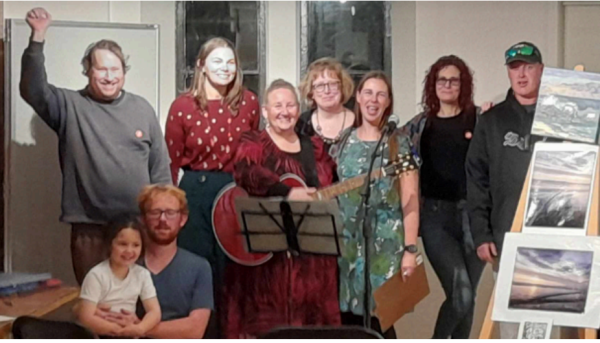
Set in Ōtautahi Christchurch, a unique community called Thriving Madly is making a difference in the lives of people who experience mental distress, addictions and/or neurodivergence.
Born from a kōrero among people working in other lived experience organisations, Thriving Madly set out to address a gap they saw in traditional support systems. Instead of looking at people’s diversity in a deficit-based way, this grassroots organisation celebrates people’s differences, achievements and shared experiences while supporting one another to foster a sense of belonging. Its members describe Thriving Madly as a place where they can be their authentic selves without judgement or expectation to perform societal ideas of ‘wellness’. The community holds space for individuals to navigate life's challenges together and find validation and safety when sharing personal experiences.
There’s a strong emphasis on ‘being’ rather than ‘doing’ in this community, an emphasis which creates a peaceful, low-pressure environment conducive to healing.
Belonging is cultivated in the community through intentional peer support practices, which allow authentic connections based on mutual respect and shared experiences to flow. There's no clinical or service-driven monitoring assessments — in this community (often likened to being part of a whānau) people are supported to heal in the way that suits them, and to feel supported even during isolated moments.
Thriving Madly is designed to welcome anyone who feels isolated or marginalised due to their mental health experiences — and this emphasis on inclusivity is key to its success. Its members notice each other, make introductions, and create a space where everyone can participate, however they feel comfortable. Accessibility is a priority, with events often held online to cater to those who prefer or require remote participation. This culture of acceptance is part of what makes the community so special and effective.
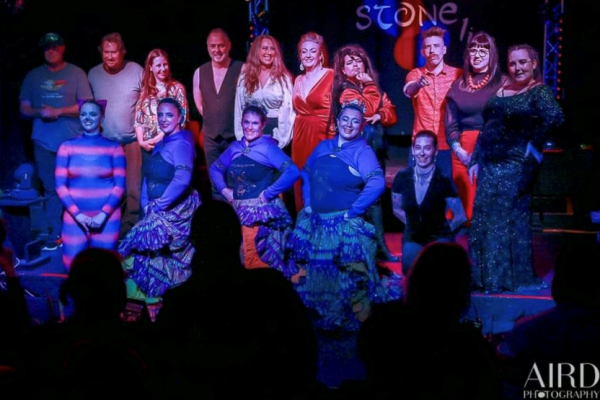
Thriving Madly has grown organically, with its activities and initiatives developed by the people who participate in them. One of their longest-running initiatives is the Black Dog Walk, a regular gathering where members meet up for a walk — with or without their dogs — and share a cuppa along the way. This simple yet powerful activity has become a cornerstone of the community, offering a relaxed setting where friendships blossom and new ideas take shape.
Thriving Madly members emphasise the importance of practising patience, gentleness, and self-discovery when working through distress. They stress the importance of finding a community that allows you to be yourself and remind others that community-building takes time but is an invaluable step towards healing.
When asked what surprised them most about their journey with Thriving Madly, one member reflected on the true meaning of community. "Growing up, I thought community was just about where you lived. But this — Thriving Madly — has shown me what real community is.
Pāyal Ramritu (they/them), a member of Thriving Madly, reflects on the profound sense of belonging and mutual support they’ve found within this unique space.
For them, Thriving Madly creates a place where everyone is free to navigate life together, a community of mutual support without the typical hierarchical dynamics that can be found in paid or service-based models. It's a community where people’s personal experiences take precedence over any professional roles or labels.
Pāyal’s previous experiences with various communities often left them feeling alienated, despite sharing common interests or identities. In these spaces, they felt the need to conceal parts of themselves, feeling they were unable to speak their truth about their mental distress or life experiences. This changed when Pāyal became part of Thriving Madly. The community, with its emphasis on mutuality and intentional peer support, gave them a platform to engage without fear of judgement.
“Mutual relationships heal,” they say, describing the deep, reciprocal connections they’ve formed in this space.
As Pāyal recalls, during a recent personal crisis, they turned to the community’s Facebook group for advice. The wisdom and generosity of the group were invaluable, offering not only answers but also a sense of shared experience and understanding. Pāyal, who is based in Wellington, recently had the opportunity to meet the community in person during the Divergence Festival of Madness in Christchurch. It was an experience they describe as special and transformative, cementing the sense of belonging and connection they’ve fostered through Thriving Madly. The festival allowed them to experience the depth of their community support in person, reinforcing the strength and importance of these bonds.
For Pāyal, Thriving Madly is not just a group of individuals — it’s a true community of belonging where difference is celebrated.
"True community is not a monolith. And true community has the capacity to hold difference without erasing it," they note.
Thriving Madly is truly a space where the subjective experiences of life are embraced, and where every member’s truth can be held with care and respect.
Punaka is an artist collective and studio space based in Pōneke, Wellington. Founded in 2022, Punaka Collective was established in response to a shared need among members for a supportive environment where artists are free to create, develop their craft, and explore creative potential.
Punaka has fostered an environment where creativity, vulnerability, and individuality are celebrated, making it so much more than just a collective of artists. Punaka hosts workshops and exhibitions with their artists, fostering connection both within the collective and the wider Pōneke community.
Dice & Fork is a board game café/bar in central Tāmaki Makaurau that truly has something for everyone. With more than 300 games to choose from and weekly events, there is no shortage of excitement at Dice and Fork.
The beloved shop flooded last January, and the support from the community was a testament to the impact Dice and Fork has had on people that come in.
Radiqal Movement is a queer-affirming, body-liberating, fitness organisation that started at the end of 2021. Their mission is to provide gender-affirming, joyful exercise experiences tailored to LGBTQIA+ 🌈 whānau.
Radiqal Movement is so much more than just fitness classes, it is an uplifting group of queer folks helping each other find holistic wellness and community through joyful movement.
Crushes on Karangahape Road has a passion for sustainability and community with hand-picked vintage, locally made products, and a social club with events that bring like-minded people together.
In 2022, they started Crushes Social Club to combat isolation and loneliness post COVID-19 lockdowns. The events were an immediate success and years later, they host workshops, meet-ups, friendship speed dating, markets, and more.
In the heart of Timaru, a special place has blossomed where community and connection thrive— the SJ Café.
Born out of a response to growing concerns about loneliness and social isolation in the area, this social café (supported by Hato Hone St John and a network of local agencies) has become a source of joy and connection for many.
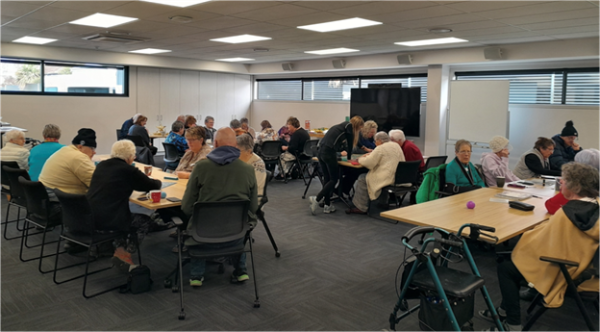
In Aotearoa, loneliness is an all-too-common challenge. With one in four New Zealanders born overseas and many families spread across the globe, it's easy to feel disconnected. Frequent house moves, ageing populations, and the lingering effects of the Covid-19 pandemic have only deepened these feelings of isolation. The SJ Café in Timaru was created to counteract these feelings, offering a warm, welcoming space for people of all walks of life to come together as a community.
The SJ Café (named after ‘Social Joining’ and St John) opened its doors in early March 2024 as a trial, with a simple yet profound mission: to provide a space where people can connect, share kōrero, and support one another. What started as an experiment quickly proved successful, and now, every Tuesday morning, nearly 40 people gather for two hours of companionship, activities, and a cuppa.
Gordon Handy, Chair of Hato Hone St John’s South Island Regional Trust Board, believes the café’s success lies in its inclusivity.
Supported by Health New Zealand | Te Whatu Ora, the Timaru District Council and Age Concern, the café is more than just a place to meet — it's a lifeline. Hosted by a dedicated health improvement practitioner and St John volunteers, the SJ Café offers a range of activities — from Scrabble and puzzles, to crafting and colouring. Special events, like a mid-year Christmas morning tea, bring extra joy to the community by gifting treats, decorations, and even goodie bags.
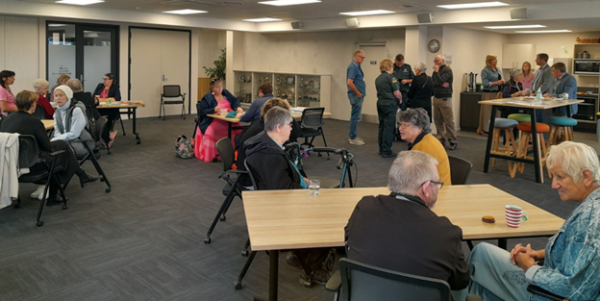
Reta Kritzinger, Aoraki Community Engagement Administrator, and Katie Morrison, Health Improvement Practitioner, are the heart and soul of the café. Their passion is evident as they welcome both regulars and newcomers with open arms. Local GPs have also embraced the café, and refer patients they believe would benefit from the social connections it fosters.
For many who attend, the SJ Café is the highlight of their week. It provides an opportunity to get out of the house, build confidence, and make new friends in a supportive environment. The café’s impact is clear: people leave feeling happier, more connected, and with a renewed sense of community.
Inspired by the café’s success in Timaru, St John volunteers are now working to establish SJ Cafés in other areas, including Geraldine, Greymouth, Hokitika, Porirua, central Auckland, and Northland, with more locations on the horizon. To help others start their own social cafés, the Timaru team has created a special guide ( available for download below) offering practical advice and insights.
Places like the SJ Café are proving that community is not just a concept — it's what we create together.
Are you interested in creating a similar space in your community? Hato Hone St John Timaru is ready to help. Contact Reta Kritzinger at Timaru.area@stjohn.org.nz or call 027 266 8181 for more information.
Art has a powerful way of bringing community together — a truth made abundantly clear at the Incubator creative hub.
The Incubator, a collection of 16 buildings in the heart of Tauranga, is a beloved space where creativity and collaboration collide to provide a sense of community for residents of the coastal Bay of Plenty city.
The Incubator was inspired by the experiences of its Founding Director, Simone Anderson. Simone (who spent much of her career in commercial art galleries) found working on the iconic Hundertwasser mural in Kawakawa brought people from the small Northland town together, and created a vibrant masterpiece enjoyed by locals and visitors for years to come. The Hundertwasser mural project, and similar initiatives that followed, opened Simone’s eyes to the empowering role art can play in strengthening connections between whānau, friends and members of a local community.
After hosting an interactive exhibition which received high praise from Tauranga residents, Simone realised there was a need for a cultural hub in the city; a communal, accessible space where locals could convene to create and appreciate art. She jumped at the chance to rent an abandoned space in the city’s Historic Village in 2013 — and that’s where The Incubator began. What started as a small group of friends gathering in an old barn has now grown into the Incubator’s thriving community, a home to ceramic studios, music venues, a vintage cinema, art galleries and much more.
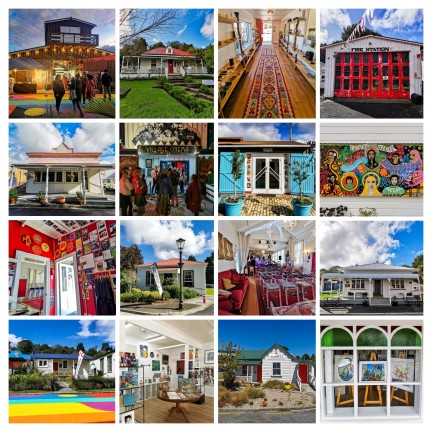
With an ever-growing list of events and activities, The Incubator nurtures a feeling of community by making art accessible to everyone. It’s a friendly and inclusive place, where people of all skill levels feel comfortable participating.
The Incubator’s focus on both community and collaboration helps build social connections locally — connections strongly associated with positive wellbeing.
Another way The Incubator supports positive mental health and wellbeing is by enabling people to process their emotions through art. This is especially helpful for people who might want to share troubling experiences, but are unsure of how to do so safely. Simone speaks of the artist Catherine Daniels, who portrayed challenging experiences from her childhood through her sculpture exhibition. Creating and displaying her art provided Catherine with an outlet to open up about her mental health challenges in a way she felt comfortable with.
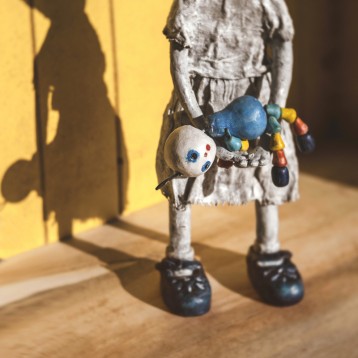
Simone’s journey with The Incubator offers useful insights for those looking to establish their own creative hub. Starting with a clear vision is important, she says.
Support from the community is essential, and can be achieved by building relationships with local schools, businesses and organisations — people who can help grow your hub by providing resources and funding, and increasing its public visibility.
Most importantly though, Simone recommends hubs exist in welcoming, accessible and safe physical spaces — spaces where people can build strong social connections and create a community together.
Want to learn more about the Incubator Creative Hub? Visit https://www.theincubator.co.nz/
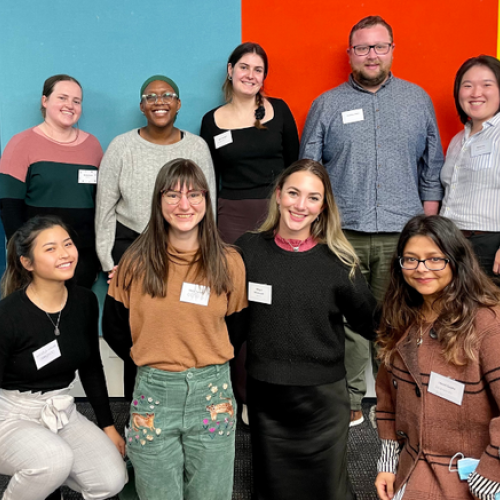
The Five Ways are proven tools that boost our mental health. The Five Ways also mirror how rangatahi want mental health supports and services to change.
Rangatahi want mental health supports and services that...
Many thanks to Romy Lee and the team at Whāuraurau for their collaboration on this piece
For more insights from rangatahi on how mental health supports could better support them, read more at Whāraurau.
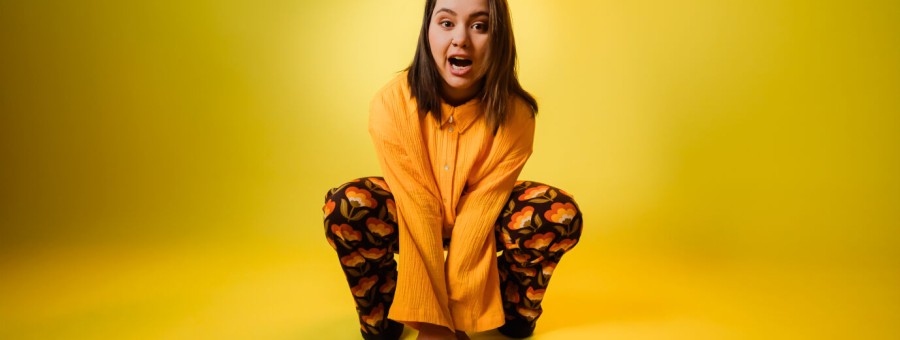
One of, if not the most important thing to my wellbeing is my relationship to my family, friends and partner.
I've formed my closest friendships throughout shared love for certain music and artists. Growing up, I was a fan of Lady Gaga, and her music empowered me to accept my identity and sexuality. The friends I made through her music had similar experiences that we bonded over.
A girl once approached me after a show with lyrics from my song 'Too Much To H8' tattooed on her arm. She shared that my song had supported her during a tough time. That really touched me.
Music has a unique power to express feelings that spoken words often can't. It's a profound experience.
Songs like "Where Is the Love" by the Black Eyed Peas, "Heal the World" by Michael Jackson, "Born This Way" by Lady Gaga all convey messages of self-love, love for the planet, embracing those society tells us not to love, and caring for everyone around us. These songs have a unique power to unite people during tough times and provide the motivation to keep moving forward. I think songs like this are what bring people together in hardship, and what keep us going.
In life, it's crucial to nurture our mind, body, and spirit. Taking care of our physical health through exercise and good eating is important, but it's equally important to take care of our spiritual needs, like finding moments of reflection and grounding in nature. Our mind thrives on practices such as meditation, self-affirmations, engaging conversations, learning, and music.
Maintaining a balance among these three elements is key. Sometimes, just one approach, like hitting the gym, might not be enough. My mum always reminds me to utilise all the tools available to me when I'm feeling down, rather than relying on just one.
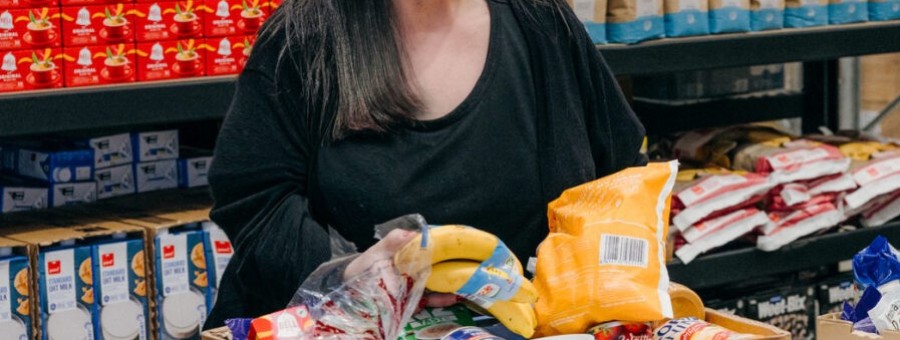
The Kindness Collective, founded by the remarkable Sarah Page, is a testament to the power of generosity, compassion, and community support. The Kindness Collective is a nationwide charity that spreads kindness by connecting children and families with the things they need, from everyday essentials to moments of joy.
“The Kindness Collective was born from the acknowledgment that not every person has the same experience living in Aotearoa.”
Sarah started the community initiative ten years ago, with a goal to ’even the playing field’, to give back to others, and as a way to heal herself.
“I was grappling with depression and my son’s autism diagnosis and was searching for tools to overcome the difficulties I was facing. I found that not everyone's ability to bounce back was the same, and that the ability to overcome adversity had a lot to do with privilege and access to the right supports.”
Today, The Kindness Collective has evolved into a dynamic and flourishing organisation that has since won Community of the Year for New Zealander of the Year 2023. With a vast network encompassing 40,000 individuals across Aotearoa, it unites donors, volunteers, supporters, brands, and businesses in a common purpose.
“I soon found that it was pretty hard to feel sad, stressed or anxious all the time when you were focusing on providing a better life for others. Kindness is our currency when providing essential support for children and families in need, but it's also our reminder, compass, drive and leveller.
“We give every day because it's the right thing to do, but because it feels good, too. Giving back to others is super addictive and the more you do, the more positive outcomes you see, the more you want to do it!”
"Find a cause that really resonates with you or makes you feel good and get involved. Whether it's volunteering, fundraising, or joining a community. There’s nothing quite like being surrounded by likeminded people, working together for the same cause to provide positive outcomes for others.”
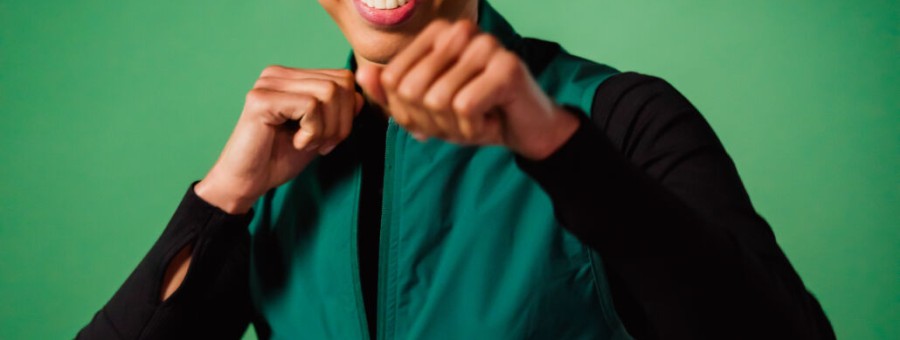
Our bodies are incredible machines that function at optimal capacity when moved regularly. Movement is care for both body and mind.
Being active is a game changer for my mental health – it helps me manage stress and I always feel lighter and clear headed after movement! I also get a better sleep at night, which is a bonus.
I was a competitive athlete for eighteen years; I moved a lot and knew how good exercise was for both my body and mind – my mental wellbeing was strong, and I felt fit and well. As someone who studied physiotherapy, I was also aware of the many benefits that exercise has on both our physiology and body function.
When I retired from boxing in 2018, I started to feel down; life felt harder; I felt tired and lethargic. Physically, I lost conditioning, but mentally, I was missing the endorphins that I used to get from exercise and movement.
I knew that to feel strong mentally, I needed to move my body regularly, so I reintroduced movement with kindness and compassion. The period of not moving and the feeling I got when I reintroduced movement really galvanised the importance of being active and the impact it has on my mental, emotional and physical wellbeing.
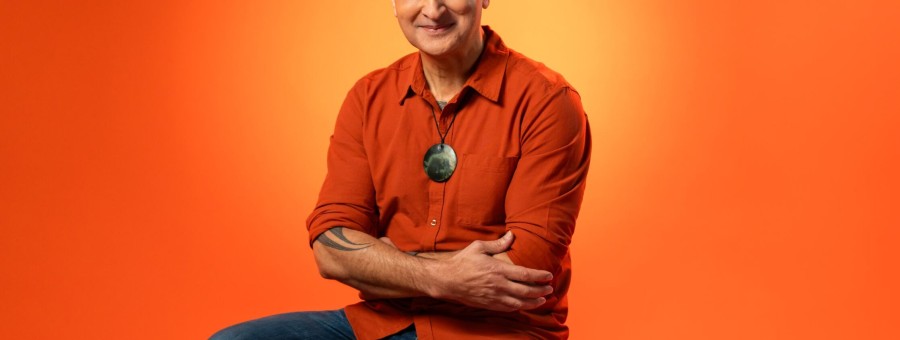
I feel like it is very easy to exist with a kind of tunnel vision, only really seeing what’s in front of you, and missing so much of what is around you. Learning literally widens your horizons and opens you up to new ideas and ways of thinking.
Learning Te Reo Māori is easily the hardest thing I’ve ever done but is also proving the most rewarding. Being Māori (Ngāti Kahungunu), Te Reo Māori is not a second language to me, it’s my language; and in that respect, it comes with its own unique challenges and rewards.
To put it simply, it has been life changing. Not to say that I had a terrible life before learning, but now my life is better.
I’m not a fluent speaker yet, but in studying and understanding tikanga Māori and Te Ao Māori, I feel an increasing sense of ‘mauri tau’ or calmness about my relationship with the whenua, my whanaunga and sense of identity.
There have been lots of little achievements along the way, and you definitely need to acknowledge them as they help you get through the tough times. Being able to take what I have been learning and use it outside of the classroom has been special. Speaking Te Reo at my uncle’s tangihanga on our marae this year was a very special moment for me and underpinned why I’m on this learning journey.
I now start every morning with a karakia. There’s a common misconception that karakia are prayers, but they’re more a chance to connect with your surroundings (in my case the beautiful bush near my home) and change your state. I find the breathing and rhythmic nature of karakia a wonderful way to centre myself, and some of the karakia I do directly relate to the wellbeing of my spirit.
My advice for anyone embarking on a learning journey would be to go at your own pace. It’s so easy, especially in a class environment, to compare your progress with others. Don’t! Know that wherever you are at the time is most likely a far better place than you were a few weeks ago. Haere tonu! Keep going!
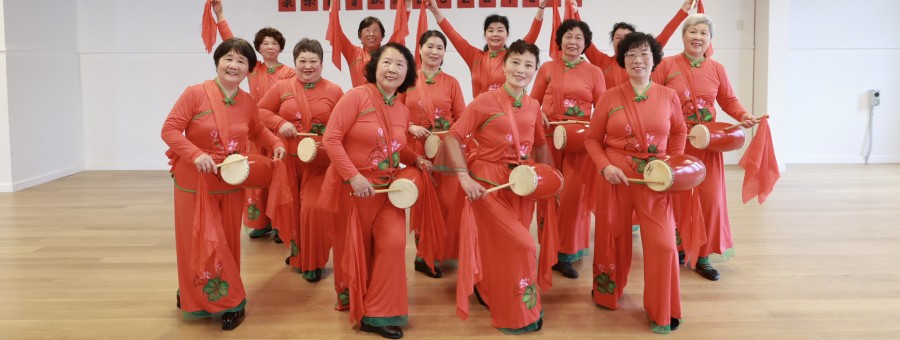
Juanhua Zhang embarked on an unexpected adventure when she moved from Beijing to Wellington in her fifties. With limited English and a sense of unfamiliarity, she never imagined that her temporary stay would turn into 15-year (and counting!) stint in Aotearoa.
It was through learning, namely, the English language, that Juanhua was able to enrich her life. Attending language classes became her gateway to a world of opportunities. Language classes not only helped her connect with new people but gave her a sense of accomplishment as her language skills blossomed. Soon, she found herself lending a hand at events and activities, even working as a part-time teaching assistant.
Juanhua acknowledges that learning a new language at an older age can be difficult, but putting in a little effort will go a long way. “It’s important to try, even if you’re old and can’t remember things as well as you used to. I have a hard time remembering the vocabulary, but I just keep practising. I don’t have my English-speaking children around me, so I have to sort everything out myself, which forces me to practise. You need to have dedication and patience.”
Juanhua's inspiring journey reminds us that learning knows no age limits. With determination and perseverance, we can conquer new skills and unlock a world of possibilities.
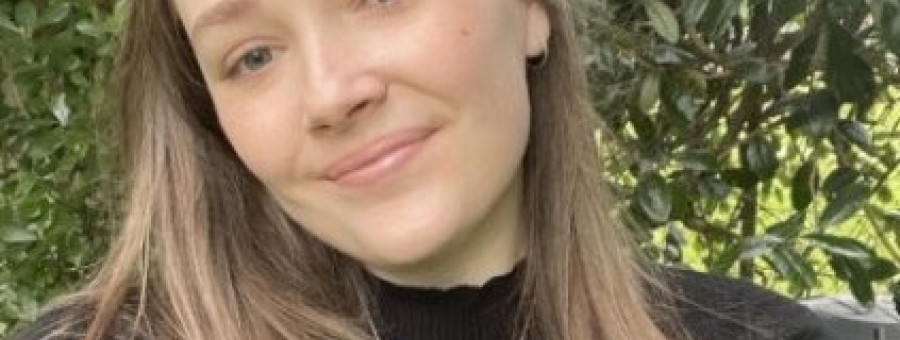
Meet Anna, a 24-year-old psychology major and firm believer in the power of nurturing mental wellbeing. Anna has experienced mental distress and addiction challenges which have driven her to pursue a career in the health sector and to advocate for inclusive and equitable environments for people experiencing mental distress.
Anna continues to face challenges, but she is grateful for her support system, and has learnt valuable lifelong skills along the way.
Anna believes Mental Health Awareness Week is a timely reminder of the importance of mental health in our overall wellbeing. She believes that everyone can benefit from becoming aware of their mental health and urges us to prioritise it alongside physical wellness.
The Five Ways to Wellbeing resonate with Anna on different levels. 'Keep Learning' brings her joy as she explores new things and channels her creativity. 'Connecting' occasionally requires a push, but the happiness and comfort it brings make it worthwhile. For 'Give,' Anna finds rewards in sharing her time, effort, and creativity with loved ones. 'Being Active' not only helps her sleep better but also boosts her resilience and coping mechanisms. Although 'Taking Notice' is challenging, Anna acknowledges its significant impact on her mindfulness and peace.
Anna hopes to reduce shame and stigma surrounding mental health challenges by sharing her story and speaking openly about her experiences. She emphasises that mental wellbeing is an ongoing adventure rather than a destination, and there's strength in seeking support and connection. We all have mental health, and embracing the Five Ways to Wellbeing can lead to a more compassionate and united understanding of it.
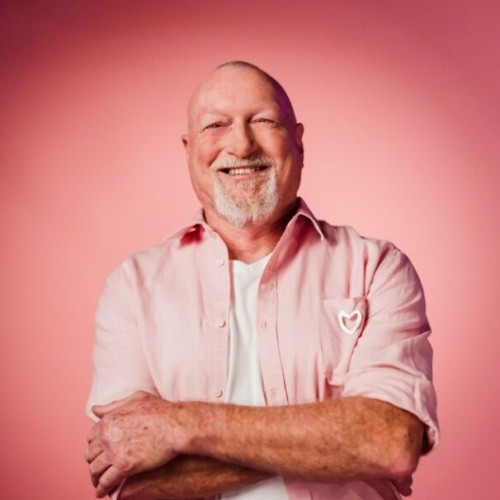
Spreading positivity and helping others not only makes them feel good but also uplifts our own spirits. When we give our time or efforts to others, it can be great for our sense of purpose and self-esteem. I've chatted with people I've helped, and it's been really rewarding to hear how my support has brightened their lives.
I'm a big fan of the saying "If you are doing something and expecting something in return, you're doing business not kindness." Kindness can really go a long way in boosting people's wellbeing.
I managed to overcome Stage four cancer. In 2017 I was given a 15% chance of making it past Christmas, but six years later I’m still here and cancer free. This victory, despite the odds, fuels my drive to make a difference. I've emerged from a challenging journey, and now I find purpose in giving back to others, whether it's to those with cancer, people struggling with their mental health, or any other way possible. Helping people to improve their wellbeing is undeniably rewarding. Throughout my own struggles, supporting others has been my coping mechanism and a way to give back.
A warm smile, a friendly hello, and a simple offer of a helping hand can go a long way. Making someone feel valued is incredibly powerful, and you never know how much it might mean to them. Every person you walk past could be fighting a battle you know nothing about.
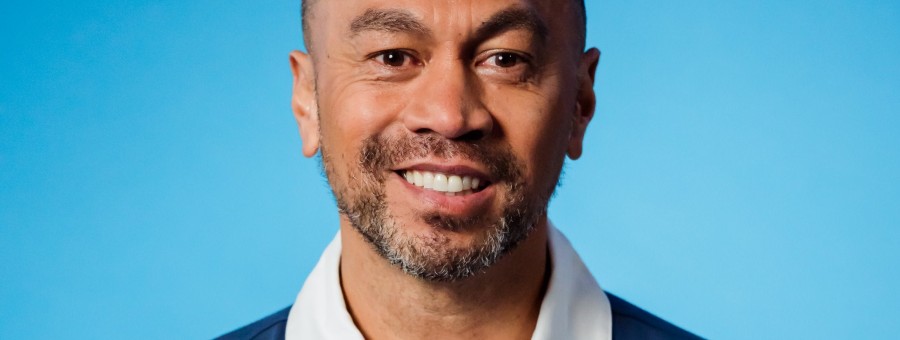
Aroha is the ultimate way to ‘take notice’ from a Te Ao Māori perspective. Aro means ‘to pay kind attention’, and hā refers to breath. When we hongi someone, we share breath; we show love this way. We ‘take notice’ when we recite karakia, mōteatea, or waiata and haka. Aroha, and in turn, taking notice, is how our kaumatua sit with closed eyes on the paepae (listening, taking the sensations into their puku to process and all the way up through their heart) so they can speak from that place when they stand. It’s in how our ancestors 'took notice’ of the stars that guided us here.
I set myself up for each day by taking notice – karakia, Taumārie (meditation for fifteen minutes), journalling to check in with my emotions, and reflections of the Te Whare Tapa Whā practices I used the day before. I also note down three things I’m grateful for and three aspirations for the day ahead. The last step in my routine is reading and translating from Te Reo Māori to English from a beautiful book, Tuku Iho, this is a part of my Te Reo studies.
If I am ‘taking notice’ or, the definition of mindfulness that I like, ‘paying kind attention without needing to change a thing’, then I can turn to my breath to settle myself in the moment when I experience anipā (anxiety), āmaimai (nervousness), or āwangawanga (worry).
‘Taking notice' comes in the form of everyday activities, like brushing our teeth, taking a shower, making kai, eating kai, walking or biking to work, or drinking tea... these are all mindfulness activities. The key is not what the action is, it's how you are doing it.
Being mindful has changed my life. These practices have increased my self-awareness – I’m more aware of my emotions and behaviours in each moment. I am now six and a half years sober, all because I ‘took notice’ of how the addictive habits were not serving me. Today, I am consistently calmer, happier and more productive. I am less reactive, kinder, more responsive and a better person to be around! When I take notice, I also know when it’s time to take a break, or when to say no.
By being self-aware, I have more room to choose how I respond, rather than react to a situation. I am much more aware of the emotions going through my body; I can now notice Ruaumoko (God of earthquakes, volcanoes and seasons) building in me when I am angry, and subconsciously, after years of practice, my breath kicks in to meet that anger, so that I can feel it but not let it take over my entire body.
I tune into my stress cues – heavy eyes, grumbling belly, tight neck and shoulders, and I can see stress in others. This means that I can lead as a CEO with compassion and empathy. Plus, I can communicate with my team openly and safely when I am going through stress or anxiety.
I have seen how mindfulness practices like ‘hā’, the breath, can support people in ‘te mura o te ahi’, the centre of the fire.
This whakataukī is something so simple, yet powerful and potent.
We all have the answers to our wellbeing inside of us. It's essential to find what works for you. That’s why I love the holistic nature of the Five Ways to Wellbeing. Take Notice, Give, Be Active, Connect, Keep Learning, are all simple tools to add to our wellbeing kete to help us. They are our arsenal for combatting huge challenges in our lives. The more tools we have in our kete, the better. Doing small practices like the Five Ways every day makes us stronger and more resilient.
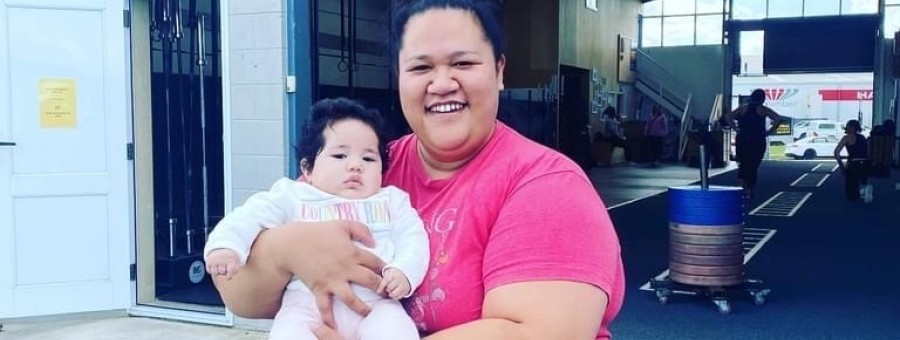
Three years ago, Situa Bureta decided she needed a change. She was uncomfortable in her own skin, with years of self-neglect holding her back physically and mentally. One night, a vulnerable conversation with her husband made it clear what she needed to do to get her health and wellbeing back on track.
“In 2019 I got married, but I was the heaviest I’d ever been. Everyone says your wedding day is supposed to be the happiest day of your life, and a couple of months later I realised it wasn’t, and it was because of how I felt about myself. My husband and I did this thing that we’ve never done before, where we sat down across from each other with a paper and pen and wrote down everything we wanted to improve in a year. On my paper, I wrote ME in big letters, and under that I wrote that I wanted to join FITmumz.”
FITmumz is a South Auckland gym focusing on women, specialising in group classes for strength and fitness training. Its counterpart, FITcomm, runs sessions for both men and women. Situa had wanted to find a mentor there, and not only did she meet a mentor, but also an entire community of supportive women pushing each other to grow and achieve their goals.
“At the gym, there’s a great vibe. We all know that we’re going to get a hard workout, but we bond through the struggle. You can hear all the girls cheering you on. Even if I don’t know everyone there, I know that the girls have my back.”
“Aside from the girls, I love the coaches too, like Siaosi, who has been a godsend. He’s been so understanding whenever I shared my struggles and has respected my privacy when it comes to that. Everyone else sees my physical and mental health journey, but he’s been amazing for my spiritual growth.”
Finding her faith is something that Situa is still working on as part of her personal growth. As a child, her Punjabi stepdad raised her in the Sikh temple, and when she was introduced to the Samoan Methodist church, she felt out of place, despite being biologically full Samoan.
“At the Sikh temple, we ate on the floor, like how Samoans do. That's how I connected my Indian side and my Samoan side, by thinking that Cool, we do the same thing, eating on the floor and doing our prayers first. The second thing I liked at the temple is how they promoted physical health. That’s how playing sports and games was introduced to me and started my interest in fitness.”
One highlight from Situa’s journey over the last few years has included reconnecting with Dora, her younger sister. Situa’s daughter was born three months ago, and she credits her sister for getting her through some difficult times at the beginning.
“I had never thought I would feel low after giving birth, but when we got home, my baby wasn’t feeding properly. I was crying so much and putting so much pressure on myself. I felt anxious that my husband was going back to work. My sister was a huge help and took so much on at that time.
“Growing up, we never really connected as sisters on a deeper level like we do now. Ever since I had my baby, I’ve gained so much respect for my sister, she’s been there for me. I know now that Dora will always have my back.”
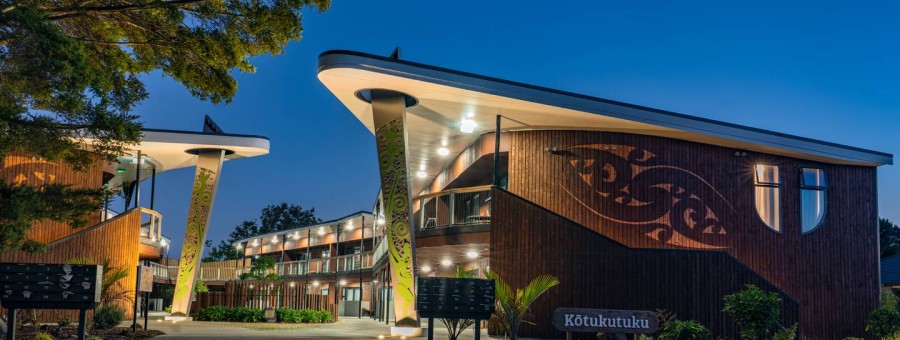
Sitting on just under an acre of land, Kōtukutuku Papakāinga is a community housing complex in Ōtara, Tāmaki Makaurau. Catering primarily to Māori but inclusive of all, the establishment is run by community housing provider Mahitahi Kāinga Trust and supported by its sister organisation Kaupapa Māori mental health and addictions service provider Mahitahi Trust. The establishment opened its doors in February 2021 and is currently occupied by thirty-six people, some of whom may occasionally access wellbeing support services. For tenants, the Papakāinga is not only a home, but a refuge, a house of healing, and where they are free (in fact, expected) to be Māori, as Raewyn Allan, Mahitahi Trust Tumu Whakarae (CEO) puts it.
A papakāinga is a group of three or more houses built on whenua Māori, operating as a community steeped in kaupapa Māori and wrapped in whānau support system. ‘Papa’ stands for connectedness to Papatūānuku (the Earth Mother) or returning to the soil, while ‘kāinga’ emphasises the communal living. “People can have different ideas about what a papakāinga is, but we thought about it in the original sense of a marae and the community living around it. We wanted to build a community within a community,” explains Louise Minhinnick - Service Manager, Te Oranga Pūmau. The systemic challenges some tāngata whaiora (‘people seeking wellness’) face when being admitted to mental health services can also lead them to losing their job or home. “Our aim is to reduce barriers our whānau are facing in the housing and mental health systems,” says Traci-Mae Nathan, Director - Ūkaipō and Tikanga. Wellbeing is the shared responsibility of the two trusts, with roles and teams that work across both. “We’re one in terms of our philosophy and how we deliver our services, but with two distinct areas of work,” Traci-Mae explains.
Sitting on the land where Mahitahi Trust started about three decades ago, Kōtukutuku Papakāinga holds a special spot in kaimahi’s hearts. Still, getting to this point was no easy feat, as Daniel Harrison, Finance and Operations Adviser tells us. In 2015, Mahitahi Trust was able to buy the 2000 m2 section of land from Housing New Zealand (now Kāinga Ora) – that’s where the original Kōtukutuku Whare, one of the seven accommodation houses Mahitahi Trust was running at the time, was built. A neighbouring property also came up for sale, so they decided to purchase that one too. “We had the land but not the money for development, so we went on a journey of finding the right people to make our vision a reality,” Daniel states. Things kicked into gear when Mahitahi Trust registered Mahitahi Kāinga Trust to become a community housing provider with the Housing Regulatory Authority in Wellington, which opened the door for upfront funding from the Ministry of Housing and Urban Development.
Before laying the groundwork, the team thought long and hard about what kind of development would best serve their community. Voices of whānau whaiora and their whānau were central to the design planning, and no detail was too small or irrelevant. Future tenants shared their aspirations on what safe, warm and affordable housing meant to them and provided input on the design, from room layout to colours and lighting. After several years of planning, admin and construction, the result was a stunning and palpable tribute to the whakapapa, whenua, and stories of hononga and resilience. The rich wairua of Kōtukutuku Papakāinga permeates every square meter of the whare and its surroundings, abundant in plantings of kai, fruit trees and rongoā. The building’s unique design is based on a waka, with a waharoa at the entrance designed to keep everyone safe. “If we reflect to our cultural wellbeing models, waka brings out our collective skills. The kaihoe (paddlers) must be of one mind and work in unison to get to their destination,” Louise Minhinnick explains.
The Papakāinga is made up of forty single-bed units, a whānau apartment for tenants’ family members’ visits, and a Whare Manaaki, a gathering place for hui and celebrations where kaimahi and tenants come together as whānau. The Whare Manaaki houses an office for the Tenancy Manager and two additional spaces to host health and wellbeing initiatives. Having the units facing each other was a deliberate decision to help foster whanaungatanga among tenants. “At Papakāinga, I see you, you see me, and that’s part of that connectedness,” says Matt Haua, Tenancy Manager. He points out the importance of reaching out to those that tend to stick to themselves, making sure they’re also living well. It’s often the case, Matt adds, that tenants who have found their footing take those who are struggling under their wing. “You see the community evolving, tenants helping one another. We’ve had situations when one person needed to go to the hospital, and others would clean their unit, so the person could come back to a clean and tidy home,” he says. Dwayne, one of the tenants, sums it up beautifully: “Every day when I wake up in the morning, we all greet each other, give each other a hug, and say good morning. And in the evening, I’ll put up some hot, beautiful kai to share with others. It’s an amazing place to live.”
Since its opening in early 2021, the Papakāinga has had to deal with a few curveballs to the way it operates. The COVID-19 lockdowns pushed kaimahi to think creatively about maintaining the same level of service and nourishing whānau social and cultural needs, while also keeping everyone safe. The teams split into two bubbles, with one kaimahi group focused on supporting tenants with any mental health needs, and the other dedicated to tenancy-specific support. With Jody Babbington, Service Manager at the helm, a Covid-response team was in charge of administering RAT tests, keeping the tenants abreast of the latest news and rules, and making sure everyone felt supported during these rocky times. “We had a bubble with 40-odd people, so of course tensions would sometimes arise. Reassuring everyone they were going to be safe and okay was incredibly important. It was heartening to see tenants looking out for each other,” Jody tells us.
Matt Haua knows all too well how crucial it is to be connected – not just to yourself and others, but with a sense of home – something many of the tenants didn’t previously have. If issues come up, it’s part of his role to equip them with tools to work through any disagreements themselves. Many tenants, he explains, had to relocate or rezone to access services or employment. That can create a sense of failure in whānau whaiora life, disconnecting them from whānau, hapū, iwi, whenua, which can induce mental health issues in the first place. The Mahitahi team knows that repairing and reestablishing these relationships is key to people’s healing and recovery, but they’re clear about one thing: it’s the tāngata whaiora whānau who are the decision makers, and kaimahi are there merely as safety vehicles to help them make those decisions.
The philosophy and tikanga underpinning Mahitahi's work are deeply rooted in the acknowledgment of the intimate connections to our environment. “Being connected with te taiao, our land and our water, is important – because we are one. When we talk about rongoā, it’s not just medical treatments – for us it’s also healthy kōrero, healthy thinking,” Louise Minhinnick shares. “We have never been a disconnected culture. Prior to colonisation, we lived long and healthy lives. This is what we’re trying to reestablish and reintroduce with our whānau here at the Papakāinga, rather than reinventing the wheel,” she concludes.
We mihi the extraordinary vision, mission and determination of the Mahitahi team to bring the taonga of Kōtukutuku Papakāinga to life. Their story is a simple yet powerful reminder about the power of connection, and proof of what can be achieved when it's embedded in the care of tāngata whaiora whānau.
When Romy Lee reflects on her journey growing up – when she felt confused about her cultural identity, and full of worry and uncertainty about accessing mental health and addictions services – and compares it to her role today helping young people who were once in her shoes, she feels a mix of emotions. She feels proud of how far she’s come, empathy for herself, and a sense of gratitude for where she’s landed today.
“I started accessing mental health and addiction services from around the age of 15 and it was a very confusing experience for me,” Romy says.
“I felt ashamed that I had to go through that and needed help. I felt lost because I didn’t know what help was available. I also felt scared because I didn’t know what that meant for me and the rest of my life.”
Now, Romy knows there is a light at the end of the tunnel, and that mental health challenges are nothing to be ashamed of. Her role as a project lead at Whāraurau means she supports young people to find work in the mental health and addictions sector, helping them to understand their job and use their personal mental distress and addictions experiences to support other young people who come through their service.
“I feel very fortunate to be able to do this work because my personal journey was very hard, but it has given me a lot of strength and drive to be able to make things better for others,” she says.
Romy says imposter syndrome hit her hard when she transitioned from being someone accessing a mental health and addictions service to an employee of one of those services.
“People who were once my clinicians and my support team became my colleagues. It was difficult to navigate the feeling that I wasn’t qualified, feeling like I was a broken person and couldn’t compete with them, and that my voice shouldn’t be as important as theirs in the workplace.”
Eventually, Romy’s confidence grew as she realised her lived experience was invaluable to informing the way services were delivered and she could represent others who had been on similar journeys - especially second-generation Asian migrants like herself.
“Often the workforce doesn’t know how to deal with young Asian second-generation migrants and the struggles and the discord and confusion they face, so one of the things I try to do in my role is to bring that representation of Asian people up,” Romy explains.
“As a young person, I always felt a level of shame about my culture. I felt different to my peers. I felt like people didn’t understand what I was going through and why I had such a different life at home. In my recovery journey I was very fortunate to have Māori kuia and kaumātua support me, and learning about te ao Māori and tikanga helped me connect back to my Korean culture.”
Connecting back to her culture and coming to a place of peace with her identity is just one of the ways that Romy has improved her wellbeing. She stresses the importance of connecting with friends and family to get through the ups and downs.
“Going through a journey of mental health and addiction and poor wellbeing can feel very isolating, and it’s very easy to feel like we’re alone. Connecting helps us understand there are other people going through similar things to us, and it also helps us to connect to people who might not relate but who still want to be there for us and support us in the way we want to be supported.
“Connection to my friends is important, and so is connection to my family – and family doesn’t necessarily mean family of origin, it can mean family of choice as well. I’m part of the rainbow community, and I know many of us have found a family there.”
Making time to do the things she enjoys is also one of Romy’s top wellbeing tips.
“I make sure I take time to do the things that lift me up. I love my job and I’m very dedicated to the work I do, so sometimes it’s easy for me to lose sight of things.
“I need to be intentional about taking time out and doing things I enjoy. It means getting out in the sun, it means exercising, taking time to cook a nice meal, staying off screens and the internet, and finding time to be present.”
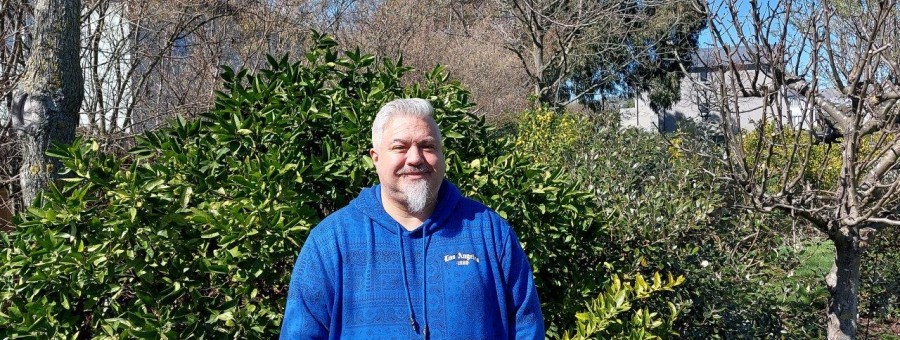
Cory Te Huia wears many hats – rugby coach, music lover, proud Cantabrian and quiz enthusiast. He also lives with Obsessive Compulsive Disorder (OCD) and has found connecting with the people who lift him up has really helped him through.
Looking back, Cory first noticed experiencing compulsions when he was 12.
“I didn’t realise it at the time, but I had developed OCD behaviours, which I learnt from sports.”
“By the time I was 16, OCD had taken over my life. I knew it wasn’t what other people were doing but I was embarrassed, and the shame around mental health was so strong back in those days. I didn’t say anything to anyone.”
As the years passed, the time Cory spent managing his OCD grew. Cory achieved all he wanted to – he'd completed three university degrees, secured a full-time job, and become a rugby coach with a busy social life – but OCD was taking up eight hours of his day. He felt exhausted from managing both OCD and major depressive disorder, and that exhaustion kickstarted his healing journey – 26 years after he’d first noticed something wasn’t quite right.
Cory saw a counsellor and specialists and started medication. Although he had to wait for months to access therapy, Cory finally got the tools he needed to manage his OCD. He felt relieved when he received his OCD diagnosis, as he finally got an explanation for the compulsions he’d experienced for most of his life.
After working through intensive treatment, Cory was given the all-clear to go back to work. He was excited to return, but worried about what people might think.
“People were going to question this five-year gap on my CV. So, I had to start thinking of ways of rebuilding myself. I didn’t know if I had the confidence to go back into work.”
Cory says the anxiety around going back to work and other activities after a long period of mental health challenges is not well understood.
“Recovery is an interesting thing. Getting well is scary, especially if you’ve been unwell for a long time. You’ve got all the support systems there propping you up for a long time, and then you’ve got to learn to stand on your own again with the help of your community and friends.”
Fortunately, Cory discovered a way to both reconnect with his community and help others in a similar situation to do the same. He stumbled upon Intentional Peer Support (IPS), a framework people with mental health challenges can follow to foster safe, mutually supportive relationships. IPS helps people achieve transformative change, learn from their experiences and move towards self-empowerment.
Cory loved practising IPS at Warmline, a Christchurch-based IPS phone line, and chatting to others who were going through or had been through mental health challenges too.
“Warmline was amazing for me, it got me active and contributing again, and connecting to others through my own experiences.
“It also gave me a clear pathway to progress into becoming a mentor, which I did, and then that turned into doing face to face trainings and a job, which was something I was worried about not being able to do again.”
Sharing his story with his colleagues, the players he coaches, and even to the odd Uber driver has sparked moments of connection and vulnerability for Cory, and he has been able to use his experiences to encourage other people to seek support. Cory doesn’t mind sharing and he’s particularly glad when he hears that his story is inspiring to others and pushes them to open up about their own wellbeing as well.
“I stayed away from my friends for so long because I was ashamed of what had happened to me. But I’m more than just my mental health struggles, I don’t live by the label. I’ve managed to reconnect with those people, and to be proud of my journey and my work in mental health.”
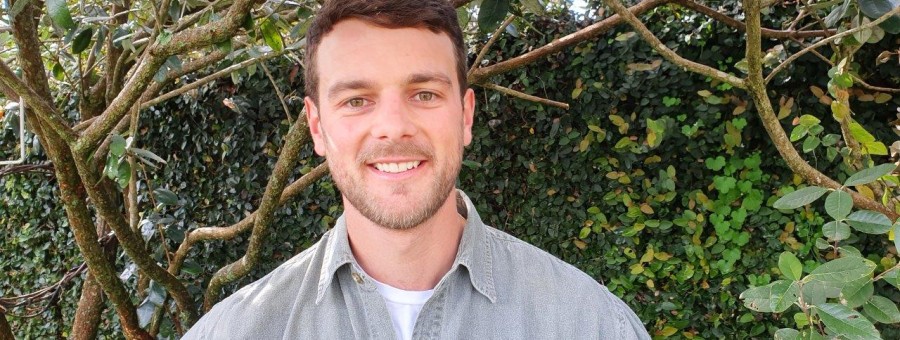
For Christchurch based wellbeing advisor Drew Divehall, sharing his own mental health experiences paved the way for a career in supporting the wellbeing of others.
Drew first experienced difficulties with his mental health in his early twenties, saying that this time in his life was “characterised by a lot of anxiety and low mood, and other challenges. I had poor mental health for a long period of time.”
With many of Drew’s close friends and family also experiencing mental health issues, as well as his mother being a mental health nurse, it is a topic that has always been close to his heart. “My passion for mental health came from my own experiences.”
It wasn’t until he participated in the Changing Minds Rākau Roroa/Tall Trees mental health leadership programme 5 years ago that he first felt comfortable to speak to others about his mental health.
People in his workplace at the Department of Conservation (DOC) were receptive to the conversation, so he started sharing his experiences and the tools that had helped him in workshops for staff. With these workshops proving to be valuable for the organisation, Drew moved into his current position of wellbeing advisor this year, and now focuses on promoting positive wellbeing to staff in a full-time capacity, which he loves. “I’ve always been exploring different tools and methods, so it’s rewarding to be able to safely share these with others at DOC, and as a facilitator for the Rākau Roroa/Tall Trees programme.”.”
Drew says people appreciate the opportunity to talk about wellbeing in the workplace. While they might be hesitant to participate at first, once they hear others share their own experiences, people become more comfortable to join in.
He explains that it’s important for leaders to know how to connect with their teams.
“A lot of my work at DOC is around supporting managers to have conversations about wellbeing. It’s about helping them to understand what their role is in supporting staff. It’s not about fixing their problems or being an expert, it’s about offering a safe space to open the conversation.”
As well as delivering workshops, Drew and his team are working on new tools and initiatives that leaders and staff can use to enhance wellbeing in the workplace.
“One thing we’ve started recently is a wellbeing champions programme. We are training people to become champions and advocates for wellbeing, and they will complete mental health first response training.”
Although Drew spends a lot of time promoting positive mental health through his work, supporting his own mental health has been an ongoing journey, and staying connected to the people and places that are important to him is an integral part of this. “Connection with people and nature were two key things that were missing for me when I wasn’t well,” says Drew.
“If I’m not careful and intentional, I can easily become disconnected, and end up too much in my head, ruminating over the past, or becoming anxious about the future.”
“The connection piece is important because it helps me stay grounded. And I can do that through nature and connecting with people. Those are the two things that help me to become present instantly, they are such important tools for me.”
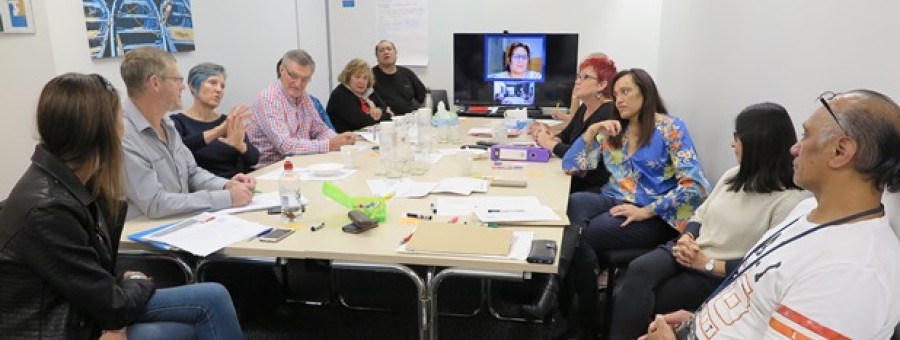
As part of Mental Health Awareness Week, we are shining the spotlight on mental health service providers in Aotearoa that are doing things differently, with connection and voices of tāngata whaiora at the very core of their care delivery.
One remarkable example is Te Whatu Ora Lakes Mental Health and Addictions and their sector-wide model of care Te Ara Tauwhirotanga. We spoke to several people involved from the start of the co-development process, and a few others monitoring the model implementation across the Te Whatu Ora Lakes district (Rotorua and Taupō).
The process was set in motion in early 2018, when Te Whatu Ora Lakes team recognised the existing mental health inpatient facility in Rotorua was no longer fit for purpose. However, they also knew that a new build, while necessary, would not go far enough in supporting people’s healing and recovery. A new model of care that could better serve people experiencing mental illness or addiction was even more essential. This planted the seed for what would eventually become Te Ara Tauwhirotanga – a pathway to kindness.
“A new build does nothing if you don’t embed an essentially philosophical orientation about how you deliver that care and really think about who it’s for, who it’s delivered by, and why,” says Michael O’Connell, Principal Advisor, Mental Health, Addictions & Wellbeing at Te Whatu Ora - Lakes.
A working group started an extensive co-development process through a series of hui. Over the course of five months, they listened to and collected input from over 450 people, including tāngata whaiora (‘people seeking wellness’), whānau, iwi, community stakeholders, clinical services, and others.
“We were trying to reach quite a granular level – people who were impacted by mental health and addiction issues, and who possibly used services before and found they were not very appropriate,” Michael O’Connell explains. “The local iwi (Te Arawa and Ngāti Tūwharetoa) played an integral part during this time, and getting their buy-in was crucial,” says Wi Te Tau Huata, Family/Whānau Advisor - Lakes Mental Health and Addictions Services.
Through the co-development process, a clear theme emerged – the new model should be centred on connectedness, kindness, and the value of human relationships. Services needed to enable tāngata whaiora and their whānau to be partners in their recovery.
The main themes that bubbled up from the collected data became the three pou (pillars) underpinning the new model: tāngata (people), taiao (environment) and tikanga (values). These are further reinforced by ten key principles guiding the model implementation.
Tāngata is a recognition that nothing ever happens without people, and we need each other to thrive. The key people behind Te Ara Tauwhirotanga are unanimous in their belief: the way staff connect with tāngata whaiora has a tremendous impact on the person’s healing journey.
Reconnecting with ourselves and where we’ve come from is just as important. “The historic trauma that Māori have been subjected to has distanced some of our whānau from their identity, and it can be hard to come back from that,” Wi Te Tau Huata explains. Jordy Bealing, Consumer Advisor - Lakes Mental Health and Addictions Services, can relate to that: “On a personal note, connecting with my Māori identity and walking on my marae at the age of 25 was a massive turning point in my healing journey.”
The role of taiao or environment on people’s pathway to wellness cannot be overstated. During the consultations, the community was vocal about the need for service providers with a strong local presence, as well as a range of alternative support options, such as rongoā, mindfulness, peer support and mātauranga Māori. “We’ve taken that on board and are trying to introduce a peer support workforce, one that deeply understands the needs and experiences of people and walks alongside them,” Jordy Bealing tells us. She adds that healthcare service providers play a significant part in creating a warm and supportive setting, one that also enhances people’s willingness to talk about what they’re going through.
Tikanga is at the heart and soul of care delivery, infusing warmth, humanity and Te Ao Māori into services that might otherwise feel cold or too institutional. “Here in Te Arawa, we have a high population of Māori. What some of the families experienced in the mental health system in the past went against who they were as Māori. They really wanted a Te Ao view going forward,” Wi Te Tau Huata recalls.
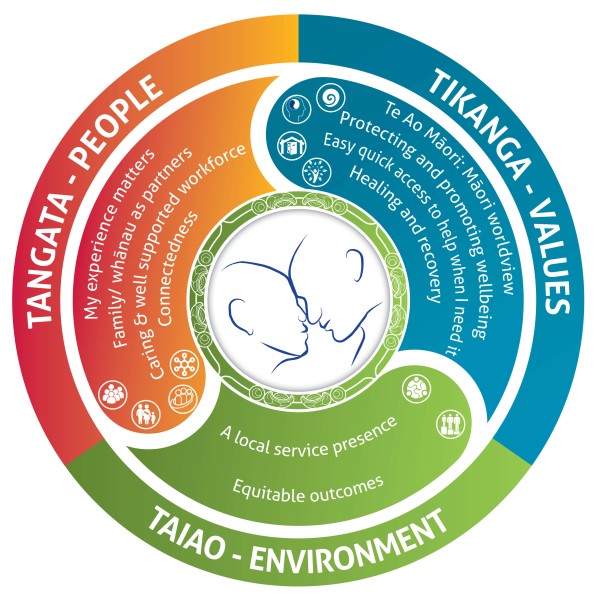
The team took extra care to ensure the character of the region and its people is represented in the logo and symbolism of Te Ara Tauwhirotanga. The colours reflect the Lakes region – green for the maunga and forests, red for the geothermal nature of the area, and blue for the lakes and sky. The hongi design in the centre speaks to people being at the heart of everything, explains Rebecca Ripia, Project Manager for Te Ara Tauwhirotanga.
“Our community needed to see themselves in the model of care. When it was crafted, we sent the draft with the refined themes back to the stakeholder groups. We asked them if this reflected what they were saying, and the answer was a resounding yes,” says Michael O’Connell.
Since its roll-out, a number of new projects have come out of Te Ara Tauwhirotanga, including the eMental Health Collective service. Feedback from tāngata whaiora, whānau, and the wider community has been nothing but positive. Just as importantly, the attitudes of staff working across different mental health services in the region have shifted. Tepora Apirana, Lifewise Regional Manager - Bay of Plenty, noticed it has helped move their focus from contracts, timeframes and diagnosis to a more holistic approach to supporting people on their healing journey. “Te Ara Tauwhirotanga is part of our contracts, competency framework, and induction process with all new team members. It’s also helping us stay accountable because our people see the model and know what’s expected of our staff,” she says. Previously, restrictions around contracts and the tendency for services to work ‘in silos’ have impacted the delivery of care, but Te Ara Tauwhirotanga helped free up providers from too much constraint. “Well-connected services are what’s supporting our people. If we’re not the right service for this person, let’s find one that is,” Jordy Bealing points out.
Tepora Apirana explains why there is no holistic health without connection. “In Te Reo Māori, the word for connection is hononga. When we connect, we not only have a responsibility to our iwi, but the privilege to be a part of a long, beautiful history. There’s a sense of pride and purpose. It’s about what’s best for us as a collective, and when you’re a part of an amazing indigenous culture like ours, healing becomes a lot easier for our people.”
“If Te Ara Tauwhirotanga can be a tool for people to reconnect with what’s meaningful to them or their identity, then we know it’s working,” concludes Rebecca Ripia, summarising the kōrero of Te Whatu Ora Lakes Mental Health and Addictions team. We tautoko the incredible individuals who brought this taonga to life in Te Whatu Ora Lakes district, with the hope it will soon become a blueprint and source of inspiration for other mental health service providers across the motu.
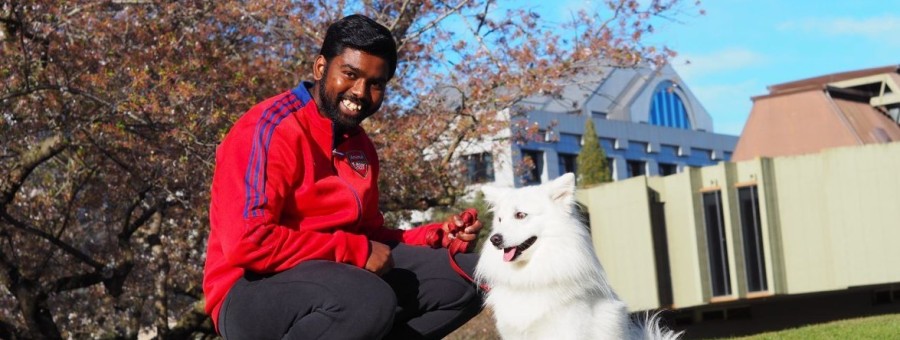
Between studying, finding his footing as a New Zealander, and juggling his role as the president of the New Zealand International Students’ Association (NZISA), Vikram Selvaraj doesn’t have much spare time on his hands. But the recent university graduate says it’s all part of the journey that he’s grateful to be on.
Originally from Singapore, Vikram moved to Christchurch in 2018 with his partner and dog in tow, to pursue a degree in criminal justice at the University of Canterbury. After settling in and getting a few years of study under his belt, he was appointed President of NZISA in early 2022.
The Association advocates for international student wellbeing and welfare at all New Zealand universities, with representatives at each university who bring back feedback about how international students are doing. Common issues are raised and brought to the attention of national agencies such as Education New Zealand, and then solutions are worked on.
One of their big projects coming up is a wellbeing roadshow, with four stops around the country. The roadshow aims to connect onshore international students and to welcome those who have recently just returned from their home countries, post pandemic, Vikram explains. “We’ll be connecting with students, making sure they are not alone, because being an international student can be daunting. It’s important that they’re not isolated and that they have the proper support networks.”
Vikram says the biggest wellbeing issue that he’s observed is students not knowing there is help and support available, leaving them to struggle alone.
"There’s a lack of information and support for the international community. Universities are trying, but the information they put out there may not be in the right place at the right time. I often get approached by students feeling isolated or lonely, and I will ask if they have spoken to anyone at the university and they aren’t aware that there are people they can talk to. I come in as a bridge to help students and universities understand how they can support each other.”
Vikram is vocal about the fact that it’s not easy, especially coming from an Asian culture, where universities are heavily focused on the academics and mental health is still a taboo topic. “It’s very different, we don’t talk about mental health. Talking about anything to do with what’s going on in your mind and soul is very new to people coming from Asian backgrounds. I was brought up with the attitude of ‘Why are you talking about this, it’s up to you to deal with it’. Here in New Zealand, people want you talk about it and be vulnerable, and it’s okay not to be okay. The challenge is connecting with and caring for students who need and want the support, but who have trouble reaching out.”
For Vikram, keeping mentally well is all about the people in his life – and his dog. He chooses to surround himself with people who lift him up. Something that has helped him is not being afraid or ashamed to admit he’s struggling, as he finds that the people in his life give him different advice and perspectives to consider. “Sometimes if you are going through a tough time, it’s easy to dwell on it. It’s important to have other people around you to pull you out of that, not just while you are going through problems but before as well.” Having a dog in New Zealand has helped him connect to his new home through exploring dog parks and meeting other dog owners, and he has learned a lot from his dog about adapting to new places with a positive attitude.
The main thing Vikram wants international students to know is that even though they may come from a different culture and background, where mental health is considered a taboo topic, it’s okay to reach out, and there are university services available for support.
“You might feel uncomfortable about asking for help, but it’s important to do it for your wellbeing. You don’t need to go through anything on your own.”
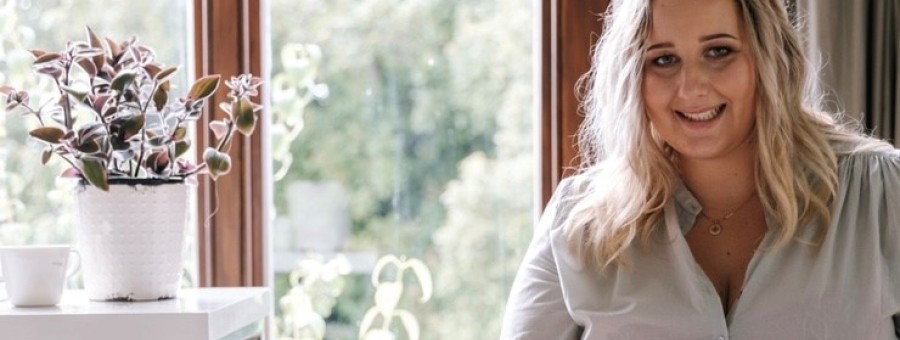
When Catie Nettlingham was diagnosed with bipolar disorder not long into her university studies, life as she knew it completely changed. Lecture halls were swapped for clinic visits, and after seeing several doctors and specialists, she moved home to the Hawke’s Bay for a few years to recover.
“It took a lot to accept and process. At the time when they said I had bipolar, I didn’t even really know what that meant. I didn’t know what the next few years were going to look like. But I always say a diagnosis is a blessing. Lots of people put off getting help and treatment but I recommend reaching out for help because it helps you get to the bottom of it and fight for your health again.”
Pausing her studies, undergoing treatment and moving to a new area led Catie to feel disconnected from the people she’d normally spend time with. “I always had good support, but there was a time where I was quite lonely. Getting pulled out from my group of friends, who were all at uni, was a bit of a lonely and disconnected experience. I had to find other ways to connect by re-forming friendships in the area I was in, like with my cousins. This illness got me calling people just for a chat and it’s made me a lot closer to people in my world.”
Reconnecting with people she hadn’t connected with for ages was just one of the silver linings of Catie’s time in the Hawke’s Bay.
Throughout her healing journey, she also discovered she loved to write. What started off as a cathartic way to process her feelings turned into a passion for poetry.
“One time when I was in hospital, I was on my own and had a lot in my head, so I thought I wanted to write it down... and then it flowed into a poem. A few months later, after I came home, I had another moment like that, and I wrote another poem. I started to gain momentum, and it helped me to process a lot, especially the mental health things I had been through. I found it healing and rewarding. The creative process of coming up with a poem was something that I enjoyed. Writing made me connect back to my values.”
60 poems later, Catie realised her poetry could help other people going through similar experiences and decided to collate them into a book titled Her Patient Fight.
“I didn’t intend on writing a book. It was just one of the things I did to help myself at the time. As I went through, the poems started to have more hope in them and that’s what people can be inspired by.”
The poems draw from Catie’s journey - starting off with her background, delving into what hard times can be like and her recovery journey through to where she is today. She hopes her words can be a source of encouragement for people to do the things that make them feel better, too.
Today, Catie enjoys her job as a support worker for people with intellectual disabilities. She regularly uses therapy, medication, exercise, and a sense of structure in her day to achieve her own sense of balance.
She credits her loved ones, whānau and friends for helping her through the tough times.
“I was really lucky to have such a good support system. My family came to all my appointments. I was a bit anxious that I might be judged for having a mental illness, but everyone’s been really supportive. My friends have stuck by me and we’re still all close. I believe it takes a whole tribe to get someone through it. This illness isn’t just my experience, it is my family’s and friends’ as well.”
When Eden O’Leary lost her brother, Reid, to suicide last year, the 21-year-old Hawkes Bay native drew close to her family to find a way through. Together with her parents and sister, she decided that sharing her family’s loss and starting a kōrero about mental health would be their way of honouring Reid’s life and legacy.
Reid and Eden were only 16 months apart in age, and were extremely close. Since Reid passed away, Eden and her family have been vocal advocates in their Hawkes Bay community, and around Aotearoa, for the importance of having a kōrero about mental health - even organising a 5k fundraiser run earlier this year: Run for Reido.
“Even though we’re going through such a hard time, we’d hate to see anyone else go through it. We’re very open, we like to be raw and real. So many people just sweep it under the rug, and that’s where the stigma and the struggle is, where suicide isn’t talked about as often.”
“In February [2021], I had this weird idea that I wanted to fundraise money. So I set my goal to a thousand dollars. Thinking oh, you know, my friends and family will donate. And then in the first 24 hours, it got to $10,000. I was like, oh, okay.”
Eden’s Run for Reido initiative ended up raising $24,000 for the Mental Health Foundation. However, it wasn’t just the money raised for mental health that was impressive, it was also the opportunity the run created for honest kōrero.
“It was incredible. We did it on Reid’s birthday, which is the 29th of March. We had about a hundred people running with us.”
“People ran, people walked and people talked and shared their experiences. We talked about Reid, and we talked about other people’s health and what we could do.”
Since the run, and with the launch of an Instagram account dedicated to her brother (@earthly_edenwillow), Eden often has people reach out to her to share their own experiences with mental health or the challenges of those close to them.
“All of a sudden people are coming and telling me how they’ve been through hardships, or their family, like losing someone to suicide.”
To help support her, Eden relies heavily on her closest circle of loved ones.
“I have a little go-to group: my mum, my dad and my sister, my boyfriend and my best friend.”
“Ever since Reid - we’ve always been a really close family, but we’ve grown so much closer. I couldn’t have done this without my sister, my mum and my dad.”
Eden has noticed major changes particularly in her dad’s approach to expressing emotions.
“Dad wasn’t one to talk much, but now it’s really nice to see him express his emotions as well. There is a change from when he was growing up - the ‘boys don’t cry’ [mentality]. Ever since Reid, he’s taken a real stance on making all his friends talk.”
Eden’s dad now helps to run Sunday walks for men in their community, an initiative first started by the men’s mental health group For All The Brothers. These walks are an opportunity for men to open up about how they’re feeling, check-in on their mates, and just generally start to shift the attitudes towards men expressing emotion.
“Reid was the blokey-bloke, always around his mates. His friends always go along [to thewalk], and it’s really cool to see them, because I know they’ve suffered a lot, and it’s nice that you know they’re talking to someone.”
Reid’s passing also prompted Eden to be more open about her own mental health challenges.
“For the last four and a half to five years I’ve had my own struggles with anxiety and depression. And I kept it pretty low key because no one really talked about that. And then ever since Reid I’ve realised how important it is to be open about it and talk to people.”
“It's just about surrounding myself with people who actually care about me. If you're around people that are just there to be ‘there’, you don't feel a sense of safety. So it's really nice to be around people that care about you.”
“I also go to therapy - I think therapy is just outstanding. I want it funded for everyone. Everyone needs to go. Being able to talk to someone who doesn’t have a biased opinion is really amazing.”
Ultimately, losing Reid is something that will always be a part of Eden and her family. They believe in being open and real - which also includes acknowledging that their hurt and grief isn’t going anywhere anytime soon.
“A lot of people do just see us on our good days, but 75% of the time we’re having a shit day and still going through it. We don’t know what we’re doing. At the end of the day, we’re just a family, but we do like to put our energy into spreading positivity and going out to make everyone feel better. Because we know what the hurt feels like.”
“Support systems and helplines are a big thing. All the people you can talk to in your support system know you, and then the helpline can have a non-biased conversation and talk you through other things. And they’re trained as well, which is such a big thing.“
Looking ahead, there’s a lot in the works for Eden and her family. She’s planning a bigger Run for Reido for his birthday next year, and she’s about to study psychology, with plans to pursue a career in mental health.
At the heart of everything is the memory of her brother Reid - a memory which has inspired her, her family, and so many others to stand up and be vocal about mental health, and the importance of reaching out for help - and being there to give help to those who need it.
“So many people are going through what you’re going through, and they feel the exact same - it just takes one person to spark the conversation.“
---
For helplines and support resources for yourself or others, head here. Find more information on how to get involved in MHAW, including great resources to use at home, here.
When choosing this year’s Mental Health Awareness Week theme, the team at the MHF wanted to highlight the importance of connecting with others for our mental health. Taking time to kōrero with friends and whānau is one major way we can boost our own wellbeing and the wellbeing of those around us. It’s also a great way to combat something that will affect many of us throughout our lifetime - loneliness.
Loneliness is something many of us will experience, and yet it is often something people feel ashamed to talk about. We spoke to Holly Walker, deputy director of the Helen Clark Foundation and loneliness researcher, about her recent report into loneliness in Aotearoa, Still Alone Together.
“We need each other. We're social animals - that's how we’re wired. Loneliness is actually a normal human emotion that we will all experience at different stages of our lives, but it's only really supposed to be temporary.”
“Loneliness itself is not a mental health problem, but prolonged loneliness can be a significant risk factor for developing poor mental health. It has profound impacts on mental health and wellbeing to stay in that state for a long time, so it can contribute to depression and anxiety. There's also all kinds of physiological impacts. It messes with your hormones, it messes with your sleep. It can elevate your blood pressure and can increase your risk of heart disease.”
Holly’s research began looking at loneliness from an urban design perspective - thinking about the ways public places encourage or discourage social connection. However, the shape of the research quickly changed after the outbreak of the COVID-19 pandemic.
“It suddenly became a whole lot more urgent and pressing because we were all in Level Four lockdown and in a state of enforced social isolation.”
Still Alone Together is a response to the original Alone Together reporton lockdown loneliness published last year, which found that while many groups bounced back from adverse mental health effects of 2020 lockdowns, there were still some groups much more likely to experience loneliness.
People living with disabilities were four times more likely to report feeling lonely than able-bodied people, while unemployed people, people on low incomes, sole parents, new migrants, people of Asian descent and young people aged 18 to 24, were also all more likely to experience loneliness.
For many of these groups, the extra support they may have felt extended to them in Level 4 quickly dissipated once New Zealand began to return to a relative normal.
“One of the things we found in our second report was that self-reported loneliness for many of these groups actually increased after the lockdown last year.”
“Our hypothesis is that during the lockdown we were all very conscious of social isolation and made quite a considered effort to check in with people who lived on their own, older people, disabled people - to stay connected, drop off groceries, have Zoom conversations… When the lockdown ended and most of us went back to our normal lives, a lot of that support fell away. And so for people who are already isolated, actually that period of return to ‘normal’ after lockdown was even more lonely.”
To better support these groups, it’s important to keep reaching out to others post-lockdown, to keep offering that same level of connection and support as we move back down alert levels.
“I think it’s important if we're in the position of being able to reach out to others to do that, even when we're busy and back to our regular existence.”
However, while individual-to-individual support is incredibly important, there are also a number of external factors in our society that contribute to increased rates of loneliness in certain groups.
“It’s pretty clear these issues cannot be solved with individual actions, as important as those are. We’re talking about what policies the government can adopt to create the conditions that make it easier for social connection to thrive.”
Still Alone Together outlines six overarching recommendations that, if put in place, could significantly impact the prevalence of loneliness in Aotearoa. These are:
1. Make sure people have enough money.
“Poverty is a huge risk factor for loneliness. If you have a really low income, a lot of your time and mental energy and headspace is spent in a state of toxic stress, trying to solve where your next bill payment, your next grocery shop is coming from. You don't have a lot of time and headspace for meeting your own self-care needs, your social needs, connecting with other people.”
2. Close the digital divide.
“In lockdown, that digital connection is a really important tool, but it actually isn't available to everybody. There are still quite a large number of people in New Zealand who don't have a regular internet connection or an internet enabled device, or they have one that's shared between a lot of different household members.”
3. Help communities do their magic.
“Where the rubber hits the road for a lot of people is actually in the community in which they live, whether that's their geographical community, like the neighborhood or community of interest, or as part of a cultural group, a sports team, a church, a school community…”
“Investing in community-led development and adequately supporting and funding community organisations is important, especially disability spaces that are accessible.”
4. Build friendly streets and neighbourhoods.
“Looking at how we could actually design, for example, housing developments to facilitate social connection. We looked at emerging Maōri housing models that put a lot of emphasis on collective spaces, community spaces, shared places for shared kai for communities to come together, outside spaces where kids can play and be supervised by parents and guardians from the whole community.”
5. Prioritise those who are already lonely.
“Targeting services and supports to those we know who are more likely at risk, because we've got really good data about who those people might be.”
6. Invest in frontline mental health services.
“For those who are spending a long time feeling lonely, who developed that kind of chronic loneliness, and it is impacting on their mental health, they need to be able to access services and support that is affordable and immediately available.”
For many of us, loneliness will be something we experience at least once during our lives. The COVID-19 pandemic and ensuing lockdowns have exacerbated this for some, while for others it is the return to relative ‘normal’ that signifies a falling away of support and a return to chronic isolation.
Changes at a policy level are obviously necessary to create real, positive change for many people feeling isolated and lonely in Aotearoa. While we should continue to advocate for these, we cannot lose sight of the tangible impact we can make right now, just by making the effort to reach out to one another.
“We should still encourage and support people to do what they can in their individual lives.”
“Whether that's someone who's feeling lonely, making that step to sort of reach out and talk to someone else and tell someone, talk about how they're feeling, but also for people who may not be experiencing loneliness to be aware of others who might be and make a conscious effort to connect.”
Now more than ever, we must continue to reach out, connect, listen, support one another, and take time to kōrero. Paired with the policy and advocacy work undertaken by organisations such as the Helen Clark Foundation and the Mental Health Foundation, these simple actions can make a real, tangible difference in the mental and emotional wellbeing of ourselves and the people around us.
Iti te kupu, nui te kōrero. A little chat can go a long way.
For more information on how to get involved in MHAW, including great resources to use at home, head here.
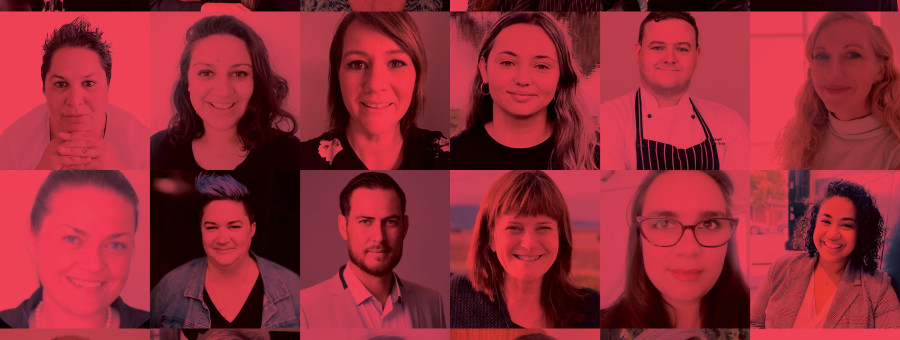
Kōrero and connection over kai
In light of the latest COVID-19 outbreak, and with Mental Health Awareness Week (MHAW) right around the corner, we spoke to Restaurant Association New Zealand spokesperson Marisa Bidois about how and why they are choosing to take part in MHAW this year.
“We are all over Mental Health Awareness Week. It's something that we as an organisation take really seriously. It’s really important for hospitality, and for many of our members, mental health has really kind of come to a head during this lockdown.”
The Restaurant Association recently completed an organisation-wide survey of 700 members, which found that 60% of respondents reported their mental health had been affected by the recent alert level changes.
“It's pretty tough at the moment, to be honest. We've been getting a lot of calls from members who are just really struggling. There's been a lot of stress going on within our team as well, because when you're supporting restaurants who are going through these difficult times, that's a lot for your teams to take on.”
However, it’s not just the current pandemic context that has been stressful for the hospitality industry - even in more normal times the high-pressure environment can take a toll on mental health and emotional wellbeing.
“When you work in a restaurant, you can be serving quite a few people in a small timeframe. So there can be quite a bit of pressure to upkeep standards, to keep things rolling, to keep customers happy.”
“[About] six years ago, we were noticing within our industry that there were a few cases of some serious issues going on in the mental health space, particularly in some of our kitchens around the country. I was approached by quite a few high-profile chefs that either had been going through these things themselves, or within their own teams in the workplace. So that's when we sat down and really thought, how can we address this? What can we do?”
For the Restaurant Association, MHAW provides a great way to push mental health and wellbeing to the forefront. At the core of the organisation’s MHAW 2021 plans are ‘family dinners’, an initiative that encourages members to have a kōrero over a shared meal at work.
“Oftentimes in hospitality there will be a staff meal naturally put out anyway in our businesses, so we thought it'd be really cool to make it an actual thing - to say, why don't we, if we can, have a time where we all sit down together and enjoy a meal? There's a lot of connecting done over kai. And some of the staff meals that our members put together are pretty impressive.”
Plans will have to be tweaked for Auckland-based teams if they remain at a higher alert level, but the organisation still hopes to encourage their Tāmaki Makaurau whānau to catch up and have a kōrero over technology. .
“The basis of what we're doing essentially really does centre around food and connecting. It’s [about] normalising that wellness check-in and to make it part of everyday conversation.”
“Sitting down and having a meal together, it does create a connection and a bond amongst your team in busy hospitality businesses and busy organisations. It can be a short time just to take a break and share some thoughts and really check in on your team.”
In addition to family dinners, the Restaurant Association are hosting a series of webinars on mental health and wellbeing topics, creating written resources, and publishing content for their followers on social media. This is in addition to year-round initiatives like their mental health app, which they use to encourage teams to check-in on their wellbeing.
Ultimately, the Restaurant Association believe that the true power of kōrero is not found just in talking, but also in listening.
“Not everyone knows that they can call us and we can speak to them. And one of the things we're working on during this time is to make sure that message is out there - that people in hospitality can ring us at the Association and that we're here to support them.”
“People just want to be listened to. I think the main thing they want to know is that they're not alone. That's the message that I'm getting - they want to know that someone’s there to support them.”
For information on how your workplace can get involved in MHAW, head here.
How Kapa Haka creates wellbeing and a space for kōrero
Awatea Wihongi has many strings to her bow: she’s an artist, singer, composer, Kura Kaupapa leaver, and core member of the Auckland Kapa Haka group Angitu. This multi-talented 23-year-old hails from Herekino, a small town in the Far North, but moved to Tāmaki Makarau with her whānau when she was five.
Open, honest kōrero is at the heart of Kapa Haka for Awatea. There can be some challenges, though. “A haka is a whole different environment, you’re going up against fifty other girls, so you don’t always want to bring in your mamae, you don’t want to share it,” she says.
And yet, as one of the tutors of the Angitu senior team, Awatea has managed to build a lot of trust among her rōpū members who feel safe to confide in her: “Sometimes members will come up to me after practice and let me know how they’re feeling, and I want them to be comfortable to come up to me no matter the time of day or what we’re doing. If you’re feeling mamae, don’t feel whakamā to come in and talk about it. That’s a big problem that a lot of people have, that they’re ashamed to talk about things.”
There’s no doubt about the direct link between Kapa Haka and Awatea’s wellbeing. Te Whare Tapa Whā – it’s all in the Kapa Haka, she says, from taha wairua (spiritual health), taha hinengaro (mental health), taha tinana (physical health), all the way to taha whānau (family health).
According to Awatea, while there is such a thing as “haka fit” (not to be confused with “normal fit,” she says with a smile) – running, singing, doing actions – Kapa Haka is also very much a mental game. “You often have to push through the hard times. What helps is knowing that you’re working towards something; you’re not pushing through a barrier for nothing. And you’re doing it with your rōpū, which is like your second whānau. All of the group members’ spirits come together for it, creating a safe space where everyone can learn under the guidance of Te Ao Māori.”
When she feels like she’s dipping into a bad headspace, Awatea calls time-out, takes a step back and tries to regain her calmness by facing whatever she’s feeling. She also encourages everyone in the Te Ao Haka to do the same when they’re feeling low. “I’m a strong believer in feeling every emotion. You shouldn’t try and push them away,” Awatea says.
When she needs a bit of heartfelt kōrero, the first person she calls is her koro (grandfather). Even though he lives four hours away from Awatea, he can immediately tell when something’s off. “I’m quite stubborn and don’t like to see the big picture sometimes, and that’s when my koro opens my eyes. Just hearing his voice and getting his gentle reassurance pushes me through.”
“Mental health is quite a big thing so don’t ever feel ashamed to talk about it. Whakanui to Mamaetanga.” Besides, she concludes, everyone has a story – no matter who they are or where they are in life. “We need to normalise that.”
For more information on how to get involved in MHAW, including great resources to use at home, head here.
Being involved in Kapa Haka all her life has given Erita Thomson (Te Aupōuri, Ngāti Paia) a solid sense of who she is and a safe space in which she can express herself fully with the people around her. She remembers taking her first step into the world of performing arts at kōhanga reo (Māori early childhood centre), where she instantly fell in love with waiata.
I was always asking, ‘Whaea, can we do waiata now?’ Every Monday and Friday we had waiata and it was my favourite part of the week.”
As Erita got older, Kapa Haka provided a bridge for her to move into new and unfamiliar territories, especially when she moved from a total immersion school into a mainstream school. Since finishing school, she’s kept actively involved with the community and it’s helped her maintain strong bonds with her Kapa Haka whānau.
“Kapa Haka makes me feel proud and my family loves seeing me do something I’ve been doing since I was little. It keeps me growing. The best feeling is performing on stage with the team. It makes you feel like you’re in another world, because you can feel the wairua within everyone.”
Aside from being a way for her to express her identity and creativity, Kapa Haka has also been the source of some of the most important relationships in Erita’s life. She says the wairua (energy) within the rōpu (group) is a safe space and can be a good distraction for anyone dealing with taumahatanga (struggles).
“In Kapa Haka we create bonds and close friendships. I’m really close with my friends at Kapa Haka. We always open up to one another, we always give good feedback to one another on performing. I actually met my partner at Kapa Haka, so that is the person I always go to when I’m feeling down. He opens up and gives really good feedback.”
“We also have little wānanga sessions with just us ladies, we talk about how you’re feeling and what’s bringing you down. We open up the circle, so everyone knows what you’re going through. It helps open up our eyes when there’s other people coming into Kapa Haka but don’t show they have so many taumahatanga. It’s really good to have those little sessions in Kapa Haka.”
Being so open has helped Erita understand the power of kōrero, especially when she or her friends are feeling down. She feels that it’s important to make sure the person you’re talking to is in the right space to listen, because it can be hard for them to process, especially if there’s a lot to take in.
“Sometimes it’s a very sensitive topic when my friends open up, I sometimes tell my friends, ‘Sorry, can you repeat that again?’ But you just have to actually listen and try to feel how that person is feeling and be there for that person.
“I reckon if someone is feeling down, then it’s best to open up because you’re carrying so much stuff. You don’t want to hold it in within yourself because it’s just going to get worse for yourself. Having a partner or a family member, or going to someone you trust, to let it out to is very important.”
For more information on how to get involved in MHAW, including great resources to use at home, head here.
Jessica Hita is a lawyer and mother of two living in Kirikiriroa, Hamilton. Like many other busy mums, Jessica can find it hard to prioritise her own mental and emotional wellbeing – which is why being involved in Kapa Haka is so important to her.
For Jessica, Kapa Haka is a safe space for kōrero - for talking, listening and connecting with others. Over the years she has found Kapa Haka to be a rongoā, a form of healing, one which has supported her through some of her toughest times.
“Kapa Haka is first and foremost a sense of belonging. You’re singing about your tūpuna, about your takiwā, your rohe, your hapū, your iwi. For me, that gave me a sense of belonging. I know where I’m from, I know who I am, and when you have that within yourself it’s very powerful.”
However, Kapa Haka hasn’t always been a big part of Jessica’s life. She was raised by her Nan before moving to Auckland and then Hamilton to complete her studies and was never really connected to her Muriwhenua side. It wasn’t until her first year of university that her cousin convinced her to give it a go. When she first joined, the only purpose for Jessica was to connect and learn about who she was, but over time that purpose deepened.
“As I got older and started having kids, I had different challenges in life, and [Kapa Haka] was kind of like a rongoā for me, and still is to this day – it’s a medicine and it helps me heal. I think you can only really understand it if you’re standing in the line doing it yourself.”
When Jessica had her first child, she took a four-year break from Kapa Haka, and it wasn’t until she got back on stage, in the lines, surrounded by her whānau, that she realised the massive gap that being away from Kapa Haka had left in her life.
It was during long car trips with her Kapa Haka whānau that Jessica truly appreciated the importance of having that support and a safe space to kōrero.
“I’m usually an introvert but when I come into these Kapa Haka spaces I feel a sense of safety. I feel safe to share my kōrero and the mamae that I’m carrying, and that’s what I do. When we’re driving up North, I just let it out, and just kōrero.”
Reflecting on the tough times she’s been through in her life, Jessica said there was an unspoken rule among the friends in her rōpū that they are there for each other no matter what. It wasn’t just being able to talk but having the right people to listen that got Jessica through.
“There was a whole season of Kapa Haka where I was going through a really dark stage in my life and a friend from Kapa Haka was always there for me, listening, giving advice every single week to help me get through. If it wasn’t for her, I don’t know where I would be.”
The relationships and support she’s found through Kapa Haka have taught Jessica to be more receiving and open to getting help and to prioritise her wellbeing when she’s feeling unbalanced.
“There’s no better feeling than having your feet on your own whenua, so when I’m feeling heavy, I always go home to my Nan’s house. For me it gives me a reminder of where I’m from and why I do what I do for my people. We’re privileged as Māori because we have a bigger purpose in life, it’s not just about my immediate family, we have our hapū, our iwi, our marae. That’s the way we’ve been raised, and we’re privileged to have a massive community around us.”
For more information on how to get involved in MHAW, including great resources to use at home, head here.
To celebrate both Mental Health Awareness Week and Te Wiki o Te Reo Māori, we met with Heemi Kapa Kingi to kōrero about wellbeing, including how kapa haka creates a safe space for tāne Māori to connect and share how they’re feeling.
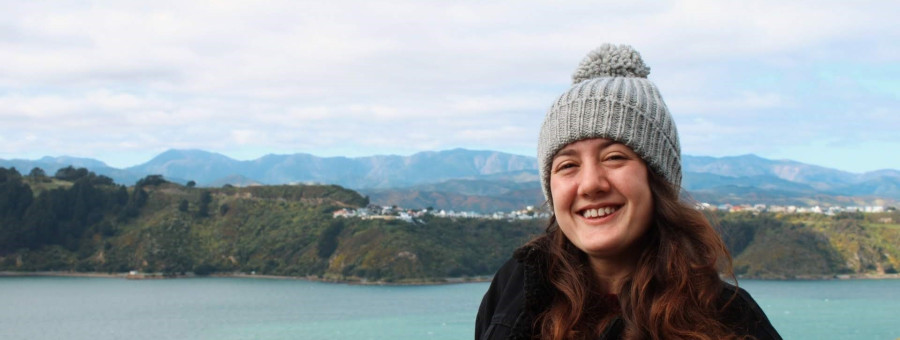
Saira Mcintosh has a huge passion for mental health. The Auckland-based jewellery designer and founder of Arias Design Co. donates 20% of all profits made from her polymer clay earrings to support the Mental Health Foundation, through her very own Lend An Ear initiative.
Saira’s passion is due in part to growing up alongside family members with mental health challenges, but it also stems from her own lived experience of mental distress. Last year, amid the height of the COVID-19 pandemic, Saira experienced a huge loss - the death of her brother Sami to addiction. Separated from her family in the UK, his death hit Saira hard, and she soon found herself facing major mental health challenges.
“I was just here alone without my family. So I didn't have that support network that I would have had in the UK. I suffered a very big mental breakdown and became very unwell. I deal with generalized anxiety, depression and chronic PTSD (post-traumatic stress disorder) from everything.”
During the peak of her mental distress, Saira found that the main thing she could do to calm her down was to reach out to those around her.
“One of the things that really helped me with that was talking to people a lot. If I wasn't able to talk to the people around me while I was going through that I do not think I would be here right now… You are drowning, and just being open and talking about it and having real conversations keeps your head above water.”
During this period, Saira also discovered a love for creating - specifically in the crafting of unique, artisan earrings. “I kind of stumbled across the earrings - making earrings out of polymer clay. And that has been such a huge factor in my kind of ongoing recovery, for so many reasons.”
“Creativity is a great thing, but also the opportunities it does give you to just get out there and talk to people. Since starting the earrings, I’ve had so many people come and talk to me about people they've lost. I've had so many conversations with people about their stories and their mental health, and it just all feeds into this great thing of looking after each other and social connection.”
However, Saira hasn’t always been comfortable having these conversations with others.
“It's a learned skill. I didn't really start talking to even my friends about it until after I had the first round of counseling. When you're younger and people don't really understand it, it's very much looked at as attention-seeking.”
Now, Saira says she is in a much better place, and feels capable enough to have honest discussions with friends, family, and even at her workplace.
“I'm doing a lot better now. It's been a journey, but I'm finally getting to a place now where I'm feeling a little bit more capable of doing things.”
“Even at work I'm really open with my mental health.. I've learned that that's just the best way to be about it. So everyone knows my situation. People know what I'm struggling with.“
So how does Saira open the conversation about her mental health, especially in places where it can feel awkward or scary to bring it up?
“I will just say, Hey, just so you know, I am feeling really anxious today. I am really not doing so well on the anxiety front. I'm feeling overwhelmed. And then we can just start to talk about what's making me feel overwhelmed.”
“It pays to remember that the biggest, the easiest place to find support is the people around you. People want to help if they know. And you'll be surprised at how many people around you have also struggled.”
For those that are currently experiencing mental health challenges, Saira’s story is one of hope - that by reaching out to those around you, you can find a way to get through.
“Talk to the people you trust. Firstly, always do that. Just bouncing off what's going on in your own head can provide such a sense of relief. Just talk to the people around you. And if you are feeling really down, [see] a doctor.”
“We're all social beings. We need to feel validated. We need to feel like we have some worth and we need to feel like we have some purpose. Having those conversations could give you that feeling, even if it's just for five minutes - it can lift your whole day.”
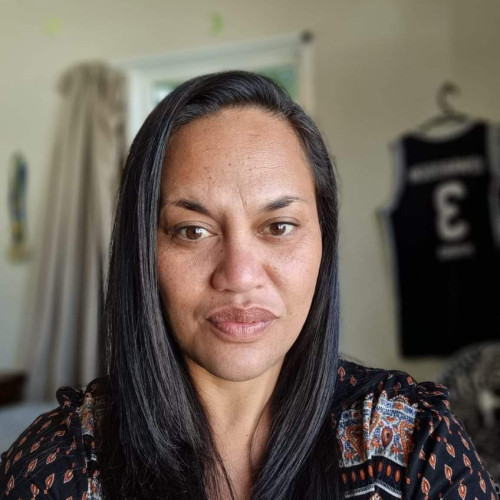
For Josie Brown, a kapa haka and music teacher in Tauranga, the theme of Mental Health Awareness Week 2021 ‘take time to kōrero – ma te kōrero, ka ora’ resonates both on a personal and professional level. Working with rangatahi Māori and tamariki Māori across different kura, Josie has seen first-hand the importance of kapa haka and waiata as a way of creating safe spaces for kōrero.
Josie was inspired to work in this space back when her son returned from school one day having been taught the wrong way to pronounce ‘tēnā koe’. She decided to offer her services for free, and her mahi has taken off from there!
Working in different decile schools, Josie has had to adapt to the different wellbeing needs and contrasting learning behaviours of tauira/students, but one thing that’s common across all of her kura is how kapa haka and waiata brings young people together. One of the most important components of kapa haka is not only its link to culture and Māori identity, but how it encourages whanaungatanga, the value of people and connectedness.
It’s no secret the power that kapa haka has on wellbeing, and providing a positive environment for rangatahi.
“Kapa haka is more than singing. It’s about expression too, so for our tamariki to learn how to express their emotions is a great thing.”
Music creates space for kids to kōrero and feel part of a community, Josie says, “it makes them more confident to be able to communicate with each other.”
Josie has even experienced the transformation in our own (typically shy) sons after taking part in performing arts. Although they were reluctant at first, “being able to do the production, being amongst their peers and mates, and getting encouragement from their teachers – it brought out a side [to them] I never thought I’d see.”
As both a teacher and in her personal life, Josie has experienced how kōrero can boost wellbeing if you’re feeling a bit hōhā. She tells a story of how she noticed a group of five girls at intermediate school, one whom was crying, and, after pulling them to one side and having a kōrero, they were all hugging and smiling.
For Josie personally, after suffering an unexpected bereavement in her whānau, she shut down and didn’t talk to anyone. “I couldn’t even listen to music and music was my thing”. But after a beautiful kōrero with her cousin it has made her aware of what she needs to do for her own wellbeing.
“Talking definitely helps when you think there’s no other way. Just that simple act of having a kōrero and knowing that someone’s listening and actually cares – it does wonders.”
Josie always starts and ends her kapa haka sessions with karakia. “Having that kōrero means that whatever happens in that space is ka pai.”
“I love that I can do mahi kapa haka and music to awhi our kids with their confidence because, as adults, we want to be sure that our children grow up to have confidence in themselves to be able to carry whatever they need to.”
For more information on how to get your school or kura involved in MHAW, including great resources to use in the classroom and at home, head here.
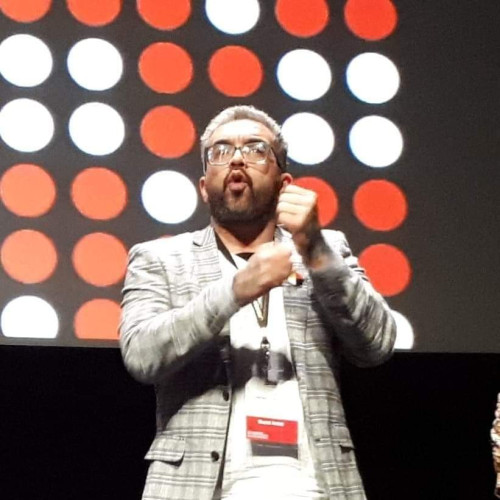
Masks are a big part of the fight against Covid-19 in New Zealand, but for a large part of the Kiwi community, they are also an added complication when it comes to being understood.
For Jared Flitcroft, a member of the Deaf community whose primary language is New Zealand Sign Language (NZSL), masks prevent him from being able to lip-read and see facial expressions.
“We need clear [see-through] masks, that would help a whole lot – or if that’s not possible, we could keep our distance, take the mask off and try and communicate. If the distance is not possible, then writing on a piece of paper would be the best thing to do.”
Being understood and being able to communicate is such a fundamental part of the human experience, but it’s one of the hurdles Deaf and hard of hearing people can face. It’s one of the reasons Jared, a film director, has spent his career working in film and television.
“I’ve been watching films for as long as I can remember. In the old days, films were not captioned, but it still gave me a sense of escapism into an imaginative world, which fascinated me.”
An early love of acting and drama turned into a passion for the behind-the-scenes aspects, eventually leading Jared into directing. “It was a fantastic opportunity for me to be creative and I wanted to make movies where both Deaf and hearing [people] are in parallel to each other.”
His short film Tama, which he made with a hearing co-director, went to numerous film festivals around the world; this has led to ongoing videography work.
Jared says the purpose behind his creative work is to “empower deaf people to stand up for themselves and allow them to chase their own dreams”.
Masks aside, the past few months of Covid-19 and the physical isolation that came with it have not added too many more difficulties for Jared. Zooms are just as useful for signing words as they are for verbally speaking.
But Jared says he did experience mental distress brought on by a relationship break-up at that time.
“It was really tough – I had a huge breakdown and had to go to emergency accommodation. My mental health derailed, my job was at risk because we weren’t sure what was going to happen and I moved into a motel, where I still am.”
It took a good, few months to start to feel back on track, Jared says. “I didn’t have a bubble, I was pretty lonely.”
To look after his wellbeing, he stuck to his routine as much as possible – he skated outside when he could and maintained therapy sessions over Zoom.
He’s still living in the hotel but uses it mainly for sleep, keeping to a morning routine of getting up and out of the house. He has put a stronger focus on work, coming up with new ideas and applying for grants. Like it is with many breakups and massive life interruptions, these daily routines were critical for getting Jared through to the other side.
“I’ve learned to be more grateful in my life really – my business is slowly taking off, my personal life is getting better. Yes, I have setbacks, but things are improving. My relationship with friends and whānau are improving as well, so it does give me a rethink on how I can be a better person.
When it comes to the theme of this Mental Health Awareness Week – Reimagine Wellbeing Together – He Tirohanga Anamata – Jared thinks it’s all about meeting the moment.
“We have to learn to adjust to how the world is right now. Covid-19 has tested us, either through our relationships, or through our work-life balance. Reimagining our wellbeing will enable us to still live fulfilling lives in a Covid-19 world.”
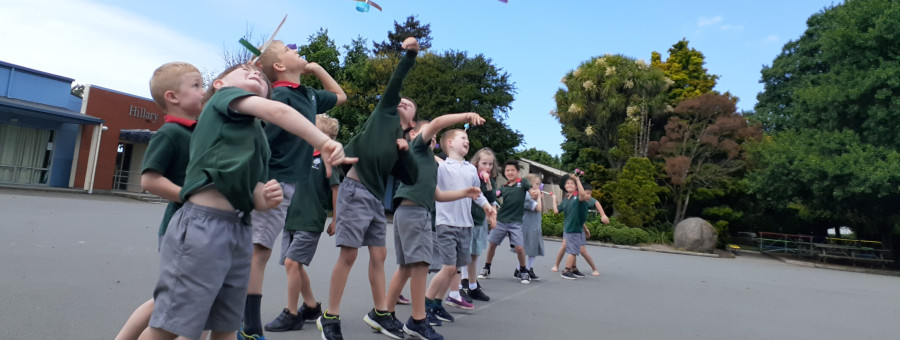
When it comes to leading school children through a traumatic event, Ōtautahi/Christchurch teachers are well-equipped to the complex, long-term effects that can happen when kids are exposed to unexpected situations, again and again.
Ellie Cherry and Nick Gunn, the Deputy Principals of Redwood Primary School Secondary and Junior years, are very aware from their years of teaching that you should take the full whānau into account when it comes to working out what’s best for the individual.
It’s the same whether they’re dealing with a kaimahi/staff member or a tauira/student, Ellie says.
“We’ve always had a real awareness of the pressure that families are under. Just being aware of how fragile other people’s mental health can be and that everyone responds in a different way. Like the prime minister keeps saying: ‘Just be kind’. It’s that simple.”
Ironically, the beginning of 2020 looked like it was going to be a settled year for Redwood Primary School. The school, located in North Canterbury, was finally due to undergo a rebuild, as one of the last schools to be redeveloped the September 2010 earthquake.
“We’ve been walking over the same uneven paths that have been there for the past 10 years,” Nick says. “We’re kind of living in that past a little bit – it’s not dreadful, but there are still viable signs. Everyone in Christchurch has that kind of shared experience.”
The community feel – and the knowledge that banding together is key for resilience – was part of Redwood Primary School’s immediate response to the challenges that have come with Covid-19.
“Prior to going into the first lockdown, we met as a leadership team and we identified whānau that might need some extra support,” Ellie says. They also did the same with staff members who might be isolated during noho rāhui/lockdown.
The school also kept their expectations flexible when it came to what home learning would look like for tauira and their whānau. The school community is a “snapshot of New Zealand”, with a mix of whānau with two working parents, solo-parent whānau, whānau that rely on benefits, or whānau where a parent is an essential worker.
There were also some whānau that had internet/computer devices at home, and some that didn’t. They split the work to about 70% offline, 30% online, to keep the pressure off families without resources.
“We tried to make the experiences as holistic, practical and helpful as possible. Activities like cooking, or helping a friend or neighbour, or walking someone’s dog, as well as more academic tasks.”
For the majority of whānau – as well as the teachers – it was a shift that was thoroughly enjoyed and the school are now looking at ways to bring elements of that teaching into the normal curriculum.
“It was really heart-warming listening to the kids and the kind of stuff they had done – and the joy they got out of it,” Ellie says. “For a lot of them, being able to spend that much time with their families was a real positive.”
For Mental Health Awareness Week on 21-27 September, Redwood Primary School will be incorporating one activity each day from Sparklers – a wellbeing toolkit for schools developed in partnership with the Mental Health Foundation.
Sparklers has long been a tool used by Redwood Primary School, particularly during their response to Covid-19. When it comes to reimagining wellbeing – the theme for this year’s Mental Health Awareness Week – Nick and Ellie say it’s about highlighting the fact that tauira already know what to do to keep themselves well and safe.
“After the earthquakes, we had a lot of chats about the positive side of things – reminding kids of all the things we did well,” Ellie says. “We say ‘I know the earthquakes are scary, but we know how to be safe, because we were safe in the other earthquakes, and these are the things that we did’.”
That empowering idea works just as well in a Covid-19 environment, Ellie says – looking at what is within our control – such as handwashing, Ellie says – and celebrating that.
“We know how to do this, we’ve done it before, and we’re superheroes at it.’”
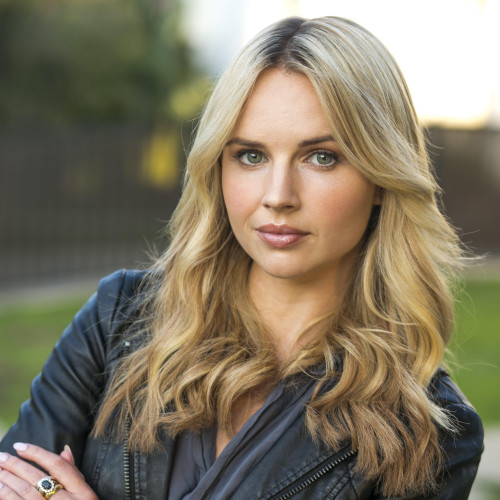
Reducing negative self-talk is how Kimberley Crossman is reimagining wellbeing in 2020.
She’s been a household name for half her life as one of New Zealand’s most popular and bubbly screen stars, so it was as much of a surprise for Kimberley Crossman as it was for anyone when she was diagnosed with burnout and depression in 2019.
“It was the first time where I couldn’t bounce back as quickly as I had done previously. I got myself to the lowest point I’d ever been, to the point where I was kind of scaring myself with the thoughts I was having. That was the turning point for getting therapy and getting myself some help.”
It was a combination of ego and perfectionism, Kim thinks, that started off in her teenage years and carried on right throughout her twenties.
“I had a whole resistance to being vulnerable – I wanted to be the cool girlfriend, the cool friend, ‘nothing bothers me…’”
Moving between Aotearoa and LA for acting and hosting work, Kim was frequently travelling and it was the level of exhaustion – plus her negative self-talk – that became the warning signs.
“I had a lot of physical ailments that come under the umbrella of a body showing stress – it was in my blood work, my gut health. I felt very overwhelmed and exhausted, but I also felt really unlike myself. In terms of my personality, I couldn’t recognise myself anymore – I was really pessimistic, really negative. For the first time in my life, I was feeling like things couldn’t ever get any better.”
Her diagnosis, she says, was a relief – and helped provide her with the tools she needed to start getting herself mentally healthy. Talking to a professional, prioritising sleep and no longer glorifying being busy all helped her.
In 2020, Kim has been back in New Zealand for large parts of the year – after usually being based in LA – and says her version of reimagining wellbeing has been learning to be gentler with herself in the face of a global pandemic and the constant uncertainty that comes with that.
“It’s about learning to cut myself some slack – and learning that there is a huge elephant in the room that I can’t control,” she says of Covid-19.
“With my mental health, I have a lot of my anxiety trying to control elements that I actually have no control over. So reimagining wellbeing, for me, is loosening the reins a bit and understanding that what thriving looks like in 2020 is going to be very different to what it looked like in 2019. I’m trying to reframe that narrative of, given the current restraints, what does a good year look like to me? And, it’s to be kinder to myself.”
The hustle nature of being a freelance actor – and having the international side of that job grind to a halt in 2020 – means that Kim has finally given herself more permission to rest. Having more time to think, she says, has made her realise how much work had taken over her life.
“The importance of family and having a community around me has really stood out for me. Because I’ve always been so work focussed, this year I have so much more awareness of how much I dropped the ball in those areas, when that’s really what matters. It’s hard, because so much of my identity is wrapped up in what I do and I need to work through that.”
The importance of Mental Health Awareness Week is not only key for those going through mental distress themselves, Kim says, but it also provides an invaluable opportunity for people who want to learn more about mental health to support their loved ones.
With her podcast, Pretty Depressed, Kim says she often has listeners reach out to her, looking for tips to help others.
“A problem shared is a problem halved,” she says. “Whether they’re parents, partners or the children of those affected, people actively educating themselves on mental health deserve a lot of credit. What bloody legends!”
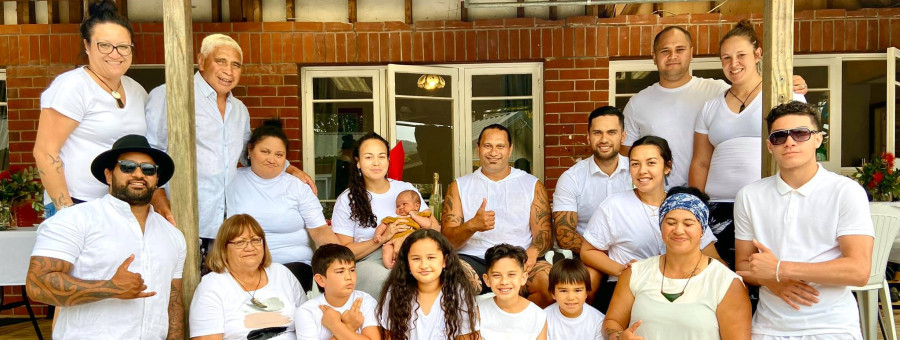
It’s been a tough year for many, but for Northland man Phoenix Ruka, this year has been exceptionally hard for him and his whānau.
It wasn’t just the noho rāhui that the 30-year-old and his whānau dealt with this year – Phoenix also had an unexpected stroke just after the first noho rāhui, meaning he couldn’t feel the entire left side of his body.
“I was working at a wānanga, and I was out running and had a stroke. That, plus lockdown, opened our eyes up as a whānau,” he says.
“I was in hospital for a while and I’m still in recovery now. I still can’t feel my left side – I can move it and I can use it, but it’s all numb and the doctors still don’t know why it happened.”
Nō te Hokianga ki te taha o tōna Pāpā, ā, nō Mangakāhia ki te taha o tōna Māma. Phoenix’s connections are strongly rooted in Te Taitokerau. He grew up in Kaikohe and Whangarei, where he still lives with his wife and their three tamariki.
He currently works at Sport Northland in He Oranga Poutama helping young people, and he also runs a gym with his whānau, where he is a personal trainer.
“We’re a really active whānau – always have been. We’ve played all sports and the gym allows me to support other people to stay active through whanaungatanga and healthier lifestyle choices,” says Phoenix.
For ten years, Phoenix has also committed his working career to the health and wellbeing of Māori. He started his hauora career in the kaupapa of Suicide Prevention – Kia Piki te Ora and has been passionate about tackling health inequalities for Māori ever since.
“My mum and my dad have always worked in hauora and as a whānau we’ve always been interested and committed to what it means to be Māori. All aspects of it – business, reo, tikanga and physical and mental wellbeing as well.”
Whānau connection is important to Phoenix. It is the pillar of strength that both his parents have built for him and his younger brother – and it’s this strength that helped him get through the obstacles of Covid-19 and his stroke.
Reimagining wellbeing in a post noho rāhui environment, Phoenix talks about how grateful he is and what he is thankful for. He says as hard as this year has been, it has brought his whānau closer together.
“It forces you to appreciate all the small things way more, like being able to go for a walk – especially after going through a period of time where I couldn’t – going to the gym even after the doctors said I might not be able to, still being alive and being with whānau,” says Phoenix.
Recovery from his stroke remains a priority for Phoenix, with multiple appointments with key health providers locked in to help with his progress.
“I'm annoyed at where I’m at and in terms of where my body’s at following my stroke. I can’t do what I’m supposed to be doing, which is super frustrating for me, because I love being active and busy, and the doctors are telling me to do less when my mind is telling me to do more.
Phoenix is also back at Sport Northland full time and has started back at CrossFit.
“I tried to do nothing, to do less, but I felt like I was getting worse. Staying busy, staying active and staying social is all about looking after my hinengaro.
His goal is to provide a great future for his tamariki – to leave a legacy of determination and inspiration. In his own words, time is borrowed; you're never promised tomorrow, so spend more time with your whānau while you can.
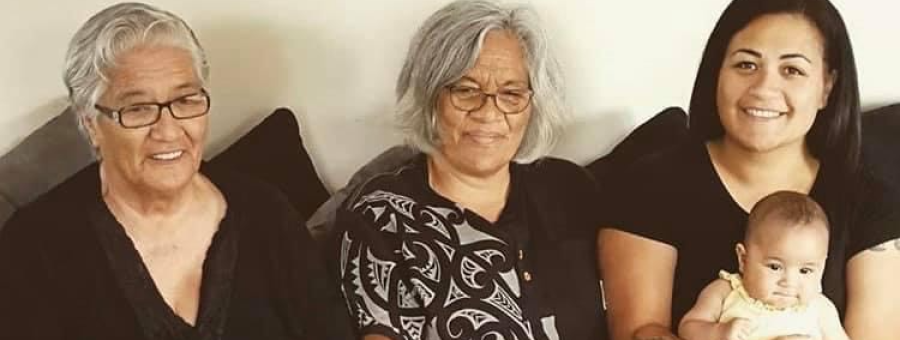
It’s safe to say this has not been an easy winter for New Zealand, shifting through multiple noho rāhui over the past few months. In Northland, however, there has been the added complication of devastating flooding to the region.
It’s a threat that is never too far away, but in July 2020, the area of Northland endured what was referred to as a ‘once in 500 years’ weather incident, swamping the area and causing devastation.
“On top of the after-effects of Covid-19, the flooding was kind of the cherry on top, pushing everyone over the edge,” says Tapeka Henare, Moerewa resident and mum-of-three.
“Kids having to stay at home because schools are closed, that puts stress on the whānau. For some whānau, the pressure of life in general is a bit much, so having the flooding just compounds everything. But we live in a resilient community and we just muck in and get it done, so that we can carry on with life.”
In Tapeka’s bubble has been her husband, their three children, aged 9, 7 and 3, and her mother and step-father – a wide range of ages to cater for in tricky times. “It’s had its challenging moments but we’re lucky to have a decent-sized home and a good section for the kids, so it hasn’t been too painful. We’ve definitely got to know each other very well,” she laughs.
Tapeka says the moves in and out of noho rāhui has been hardest on her husband, who is based in Auckland as a builder during the week. “Returning back to work after level four was stressful for him, because he didn’t want to bring germs home. It has definitely increased some anxiety for him. He is all over the place on construction sites, having contact with hundreds of people. Everything has been an unknown.”
Living in Moerewa means living with an extra level of uncertainty due to the possibility of flooding at any stage. Luckily, the community is strong and knows how to look after each other.
“We’ve got some good community leaders and whānau who have been through generations of this kind of stuff, so we’ve been able to learn from them about how we can deal with it,” Tapeka says. “We can’t control everything that happens to us, but we can control how we react and fix up the situation, so that the stress is alleviated for some of our whānau.”
These leaders and their community groups are the ones who help organise individual whānau aid such as food parcels and sanitation parcels. They also coordinate larger responses, like having Northland Waste bring down skip bins so that whānau and schools are able to clean up their properties without worrying where they’re going to put the rubbish.
The most important thing these groups do for the community is driving around and popping in to see how everyone’s going.
“That goes a long way,” Tapeka says. “We have a lot of elder members of the community who are isolated anyway, so just being able to see the groups coming around and offering nursing services or food parcels is great. Once our schools were able to open, they were able to provide meeting points for our whānau – especially our rural whānau – to be able to come in for a chat and a meal.”
The importance of checking in on your neighbours and helping where you can was modelled for Tapeka by her parents and her grandparents. Tapeka’s grandmother, one of the oldest members of the community, still goes on regular visits to those who need it.
“Nothing beats a visit from someone, so you can have a cup of tea and a good yarn about what’s been happening in your whare or your school,” Tapeka says. That plus the social vibe at local spots like the community gym – who has started offering online classes – or the marae helps connect people in good times and bad.
The message of Mental Health Awareness Week this year is He Tirohanga Anamata – a glance into our future. For Tapeka and her whānau, that means keep looking forward and keep moving forward, together.
“The people here are what makes living here so good. Even though we get knocked down, we get back up and at the end of the day, we’re all connected in Moerewa, we’re all whānau.”
Photographed left to right: Tapeka’s grandmother (Tapeka Davis), her mother (Te Hemoata Henare), and her baby (Ohineriria)
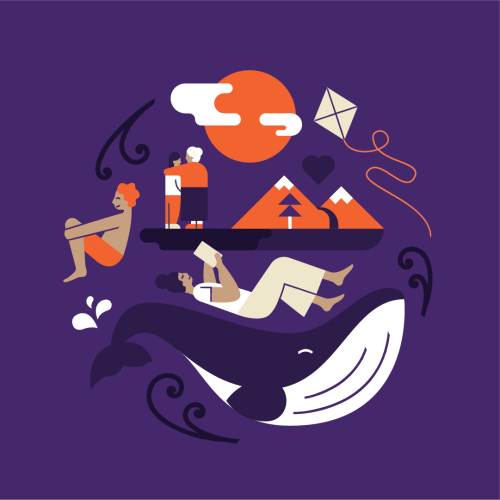
MEDIA RELEASE
Friday 11 September 2020
There’s just over a week to go until Mental Health Awareness Week (MHAW) kicks off across Aotearoa on 21 September.
Close to 10,000 workplaces, communities, whānau, schools and kura are gearing up to Reimagine Wellbeing Together – He Tirohanga Anamata.
Mental Health Foundation (MHF) chief executive Shaun Robinson says the theme of the week acknowledges that this year has not been an easy one.
“Many of us have had to reconsider the experiences, actions and surroundings that make us feel good, stay well, and uplift our wellbeing,” he says.
“Restrictions on living have presented challenges for many of us – and opportunities too. I’m hearing from New Zealanders about the good things they’re doing to acknowledge their own mental wellbeing right now. We want to learn more about the simple, everyday things you’ve done this year to look after yourself and your whanau”.
Mr Robinson acknowledges that everyone goes through ups and downs in life – that’s a completely normal part of being human. He says sometimes our sense of wellbeing might feel strong, sometimes not, and that’s OK.
“Wellbeing is for everyone and isn’t just for people who’ve experienced mental illness. 1 in 5 Kiwis experience a mental illness each year and it’s important to remember that with the right tautoko/support many people can and do live well with mental illness.”
The daily themes of MHAW this year are inspired by Māori health model, Te Whare Tapa Whā, designed by leading Māori health advocate and MHF patron Sir Mason Durie.
Activities include the Wellbeing Photo Challenge with prizes up for grabs; a colouring competition for tamariki/children, which is a chance for them to creatively reimagine their wellbeing by drawing the things that make them feel good; a calendar of events showcasing a variety of activities happening across the motu/country and resources are available to download and order for free.
Robyn Shearer, Deputy Director General, Mental Health and Addiction at the Ministry of Health says “MHAW is a great opportunity for us to reflect on the simple but powerful things we can all do every day to maintain our wellbeing. Remembering and practicing what got us through tough times before can help us build resilience for when times are more challenging.”
There’s still time to register for MHAW (21-27 September) to receive ideas on how to get involved in the week, see what events are happening in your local area and receive the latest news.
For more information contact:
Mark Wilson, Senior Public Relations & Media Engagement Officer, Mental Health Foundation of New Zealand
021 998 949, mark.wilson@mentalhealth.org.nz
Kate Clark, Mental Health and Addiction Directorate, Ministry of Health
021 197 4785, kate.clark@health.govt.nz
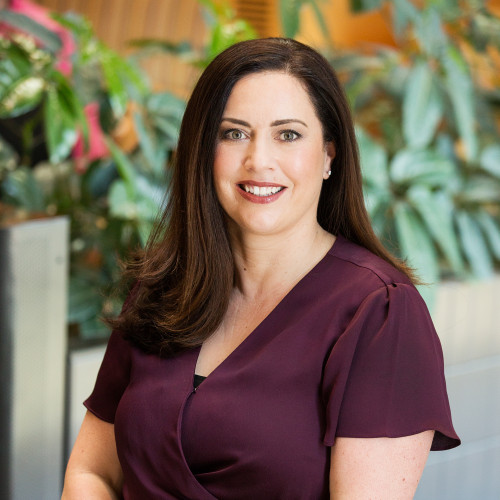
The role of the Claims Team at AIA, New Zealand’s largest life, health and wellbeing insurer, involves dealing with people at possibly the worst time of their lives.
This is how Brynlea Hunter-Morpeth, Chief People and Culture Officer at AIA New Zealand, describes it.
“The people calling up have sometimes received a terrible diagnosis or are facing something incredibly overwhelming for them or their family members,” Brynlea explains.
Take those interactions and then place them in a remote working environment during Covid-19 and it makes for a particularly challenging job for the team.
The importance of workplace wellness is front and centre more than ever before for AIA New Zealand.
“Wellbeing is something we’ve always been concerned about – we want to support people in being well when they’re working with us,” says Brynlea. “But when people are working in a remote environment, and all the stressors and added anxiety that we’ve all found ourselves under this year are so much greater, then mental health and supporting people becomes a lot more challenging but all the more important.”
Initially, AIA’s focus was on helping everyone shift to a remote-working environment and the many complications that came with that – such as balancing work life with child-care and staff living situations.
“Our leaders and managers had to be really tuned in and make sure they were having conversations with people to check in on all of this.”
Early on in the first noho rāhui/lockdown, AIA ran a series of virtual town hall meetings for their staff with Sir John Kirwan and Dr Fiona Crichton, who are behind the mental health app Mentemia, which AIA offers to its staff through its AIA Vitality health and wellbeing programme.
Those meetings were “incredibly well received”, Brynlea says. They also set up a shared site on the work intranet with tools and resources for all AIA employees, as well as creating a task force, within the company, dedicated to looking after health and wellbeing.
One of the biggest issues has been encouraging people to take their annual leave. It can seem a bit pointless where there’s nowhere to go but this is a year where, arguably, people are working harder than ever and any form of a break needs to be prioritised.
“Because the home and work environment are now so interwoven, people aren’t necessarily turning off at all. So, we’ve been really focused on making sure people are taking breaks and taking their annual leave.”
AIA also has additional leave built in with four ‘recharge days’ per annum. “It’s like a duvet day, basically,” Brynlea says. “The intention is you take it off, you recharge, you have a facial, read a book, go and watch a movie. You do something nice for yourself.”
Staff are encouraged to put their ‘recharge day’ in their out-of-office messages, so people acknowledge the importance of them and others can think about booking in their own.
For this year’s Mental Health Awareness Week, the AIA team have put together a wide range of wellbeing activities for the staff to enjoy that incorporate the holistic view of looking after physical and mental health. Yoga and mindfulness classes for the staff, a webinar with Nigel Latta about ‘Coping in 2020’ and a month-long step challenge – with wellbeing prizes – are just part of the line-up.
Brynlea says the ongoing mental shift from Covid-19 being something of the past, and instead being something we will have to continue to factor in, means the wider purpose of workplace wellbeing has been making work feel like a stable part of an unstable world.
“It’s all about trying to build resilience and also supporting each other to bounce back. Now, we’re better enabled to face the uncertainty in the world because we know – no matter the level – what work is going to look like.”
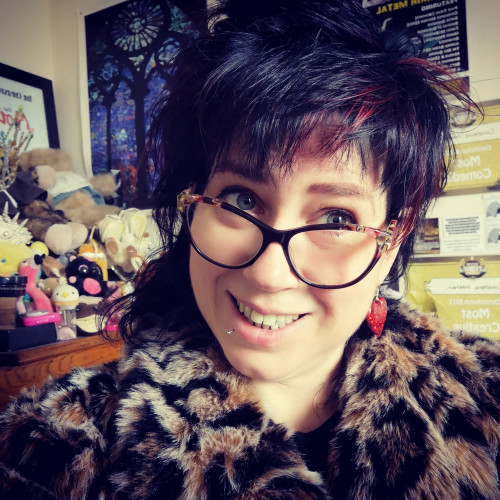
As a lived experience facilitator and trained social worker, Hannah Whittaker-Komatsu knows what living with mental distress can be like from both a personal and professional perspective. She first encountered the mental health system when she was eight years old after disclosing sexual abuse and has lived with a range of diagnoses ever since.
Turning those experiences into something that no longer defines her has been Hannah’s life work for the past 20 years. She is now passionate about passing on the message that living with mental distress can be something to work with, rather than work against.
“I’ve had to experience what it’s like to live within that continuum of wellbeing,” she says. “To get to a place of understanding that my experiences, which are called ‘disorders and illnesses’, are actually part of who I am. I’ve had to learn to love those components of myself, because they are the things that allow me to be alive, to be creative and to survive the first 21 years of my life.”
That shift in thinking has supported her in becoming who she is today. “The good, the bad, the ugly and the beautiful.”
The ’diagnoses’ Hannah has been given include Borderline Personality Disorder (BPD) and Other Specified Dissociative Disorder – and for a long time, she says, she experienced them as “predictions for my life that were cast upon me”.
It was a painful process, she says honestly, learning to reframe them. But it is a process that changed her life. “The story I’d been told is that if you don’t fit the mould, if your way of being isn’t typical or if you can’t do all the things that are considered ‘normal’ for a human to do, you are then disordered or ill,” she says.
“Whereas for me, I’d had these massive experiences when I was younger, so it made perfect sense that I wouldn’t be behaving typically, or feeling so great. For so long, I believed that the experiences I had in childhood had broken my brain… but it’s actually bollocks. Believing that just gives the power over my life to the people who harmed me.
“I had to start to understand and build a relationship with my experiences. Now I think it would’ve been more disordered if my brain hadn’t reacted in the way it did, if I hadn’t created these distinct ways of moving through the world.”
It was a shift of thinking she found empowering, Hannah says. “I have taken my power back.”
There were limitations, made by others, that came with those diagnoses when Hannah was younger. “When I was 17, I was told I would be unlikely to hold a long-term relationship because of my BPD diagnosis,” she says. “I’ll have been married 20 years in March.”
It also affected the career path she took – although, she says, she has no regrets in training as a social worker. Being able to help others break free from similar limitations “is a fundamental reason for me to continue existing”.
When it comes to looking after her wellbeing, Hannah says having a connection to the world around her is key. “Whānau but also whenua; making sure I am an outdoor creature at times.”
Creativity and contribution are also the big drivers in making her feel strong and healthy – both of which have combined in her launching the Divergence Festival, which takes place the week before Mental Health Awareness Week (21-27 September).
It’s an upcoming event she describes as “a Mad pride event: celebrating mad, divergent and neurodivergent lives”. Kicking off on 12 September, the Divergence Festival will take place in Ōtautahi/Christchurch and include events such as the Black Dog Walk Off and Mad Poets.
But the biggest source of ongoing wellbeing support for Hannah has come from her community of friends and loved ones. The love her mother had for her, she says, was transformational.
“She held the faith with me – she saw me as her daughter, even when I was acting in an unusual manner, she still saw me as her Hannah.”
It was the same with her core group of friends. “They still saw me as who I was at my best, even when I couldn’t.” Having people look beyond the labels and ‘diagnoses’ placed on Hannah helped her to eventually do the same.
“Now, at 43 years old, I’ve moved to a place where those definitions and categorisations of my lived experience throughout my life – they don’t define me and they certainly don’t predict what my life is going to be. I’m going to live to be more than what those predictions have said about my existence.”
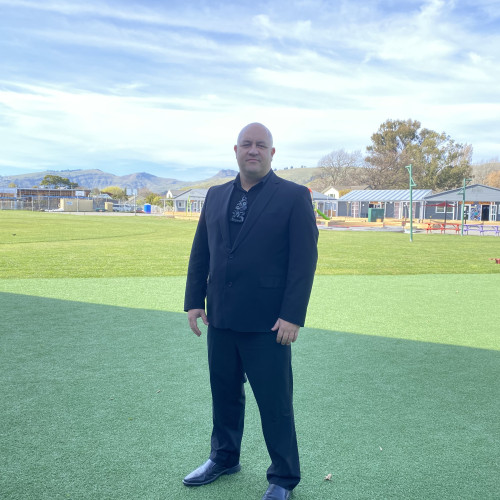
For five years, Tahu Paki has been working at Te Kura Whakapūmau, where he is currently deputy principal and head of the Wharekura. As one of only two full immersion Kura Kaupapa Māori schools in Christchurch – and one of only five in the South Island – the community have always been tight knit.
That community has grown even closer during the ongoing hardships of Covid-19 and also the various levels of noho rāhui/lockdown that have been placed on Ōtautahi throughout 2020. With 130 students, ranging in age from five to 18, there are many things to consider as a kaiako.
Luckily, Tahu says, the relatively small size of their kura means that the faculty are able to keep a close eye on both their students and their whānau. All of this became even more crucial when suddenly the entire community had to suddenly move into online learning, overnight.
“Luckily, we’re quite a tech savvy school – we have a lot of teachers who have lots of tech skills, so we were quick and organising classes to make sure we could still connect with whānau,” Tahu says.
Because of how tight the kura and the students’ whānau all were before noho rāhui kicked in, the kura was in an excellent position to know the individual needs of the whānau – and there was already an existing level of trust within the community.
“We sent out food packages, meat packages, winter packages, clothing packages, cleaning and hygiene packages,” Tahu recalls.
The majority of the secondary school students all had part-time jobs, many of which disappeared in the first round of job loss that hit after noho rāhui. This placed additional financial struggles on many whānau, hence the need for immediate wrap-around support from the Kura Kaupapa community.
“That’s always been our kaupapa,” Tahu says. “We’re whānau driven, ensuring everyone’s okay, no matter where you are in our kaupapa. Even for those who aren’t direct whānau. We know we’ve got kaumātua that are connected to our kura and we’ve been keeping an eye on them as well.”
As a Kura Kaupapa Māori, a focus on wellbeing has always been a priority.
“Wellbeing is all about having balance; having a holistic approach to learning as well. It’s really important that we have our Te Whare Tapa Whā – that our house is strong. The kids have lots of physical education every morning, looking after tinana. Because we have small classes, we can see how they’re developing mentally and cognitively. And we have really close relationships with our whānau. They’re really open and really happy to let us know if they’re struggling.”
When it came to moving out of noho rāhui and returning to kura, it was done in a very cautious manner, Tahu says.
“We have the mind-set that we need to be looking after the next leaders on the marae, the next generation.” Also, the kaiako knew they would need to put in the mahi to bring back the fluency of the reo spoken in school.
“We had to have a good plan that te reo Māori was really important to them again and that they understood the importance of speaking it all the time at kura, because they hadn’t been speaking it at home.”
The school grounds were also in the middle of a rebuild as well, meaning there have been extra challenges in making social distancing possible when only a third of the buildings are able to be used.
Looking after his own mental health during this time was crucial for Tahu, with so much urgent need required in the community. His whānau are also heavily involved in the kura – both in leadership roles and as students. It was good to be able to keep both worlds close, Tahu says. In a way, he says, the noho rāhui provided a reset for all of them.
“It was a good break – a chance to re-look and reorganise what’s important to us as a whānau. There were good things that came out of the lockdown.”
When it comes to ‘He Tirohanga Anamata’ the te reo Māori slogan of Mental Health Awareness Week, and moving forward together, Tahu says the message is clear.
“The future is really important and we need to focus on it, making sure we have contingency plans. We’re moving through very uncertain times and we need to be able to still support families, as well as keep looking and moving forward.”
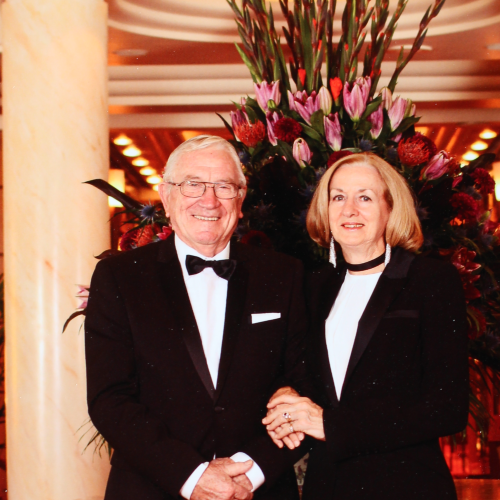
If you’re lucky, you get a love story that lasts a lifetime. For the thousands of New Zealanders whose loved ones have dementia, that story takes on another kind of journey.
Donal and Trish Miller were married in the mid-1970s and just under 10 years ago; Trish was diagnosed with early on-set dementia. They both live in the Edmund Hillary Retirement Village in Auckland, where they started out in an independent apartment. Now Trish lives in the secure care unit (dementia) and Donal lives in their apartment by himself.
There are, of course, now added complications to this set-up, with Covid-19 restricting the movements of those over 70 – particularly in retirement villages. The sense of community in the village has been invaluable over the past few years, Donal says.
“To be honest, I don’t know if I would have got this far if it hadn’t been for being in this village,” he says. “There are so many people here who have been through what I’ve been through and you get a great amount of support.”
“There was one gentleman in the village who had lost his wife to dementia just before we moved in and he came and found me, saying ‘I want to see you, let’s have a coffee together.’ He went through his experiences, making sure I knew what help was available and what to do. You build up friends you see here on a daily basis. It’s not like having to leave the house and go and see someone. And so many people here are used to it – whereas out in the general world, it can be quite isolating.”
Donal also has a group of friends outside the retirement village he usually sees regularly, but during Covid-19’s assorted lockdowns, he’s not able to leave the village without losing access to the hospital section where Trish is, out of fear at how quickly the deadly disease could spread throughout the facility. But there are plenty of friends and activities to keep him connected in the meantime, he says.
The nature of the retirement village also meant that not only was Donal supported as a carer, but there were options and wraparound support for each ongoing stage of Trish’s dementia. While living unassisted, they had some in-home care help for a few hours a day. When Trish’s condition began to decline, she was transitioned into the dementia unit – but she was able to attend activities there beforehand, so it was easier for her to be comfortable and settle in to a familiar surroundings.
Nowadays, Donal spends mornings and afternoons with Trish – talking to her, taking her out in the sun on warm days, having morning and afternoon tea with her. It is an enduring marriage with professional back-up from carers who feel like special friends, he says. “It’s wonderful to see the bonds that can come up between the carers.”
It is not easy, Donal says frankly. It is a journey. “You know there’s no chance that she’s going to get better. And some people wouldn’t bother. They would just let the carers and the dementia unit environment just carry on but I like to make sure she’s happy and settled.”
Lisa Burns, from Dementia Auckland, says support from people who have also experienced being a carer of a loved one is invaluable. But she says reducing the fear of dementia is also key. Friends or loved ones can sometimes avoid the person, wanting to remember the person as they were, but this can leave the partner or caregiver of this person feeling very isolated from their friends as well. “If there’s one message we want to get out, it’s to see the person – not the dementia. That’s the thing with Donal – he still loves and cherishes Trish. He sees the person, not the disease.”
There are good days and bad days, Donal says, and when Trish is upset, it is very upsetting to him. But being able to see her every day and know that she’s safe and in good, caring hands is a big help, as is being surrounded by people who have been in his shoes. He’s now in a position where he can also reach out to new residents of the retirement home who are starting the same journey as he was with their loved ones.
“I wonder about people who are confined to their own home, trying to handle things by themselves. I wonder would I have got this far – and would Trish have got this far – without the community around us.
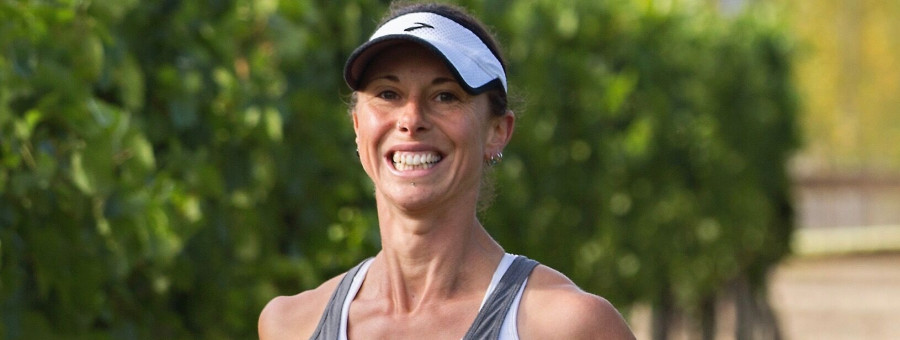
When endurance runner Emma Timmis received an injury meaning she could no longer run, her whole life was turned upside down.
But the 35-year-old rock climbing instructor has used the experience as a way to slow down, be in the moment and focus on other elements in her life that keep her well.
Emma, orginally from England, moved to Queenstown almost four years ago.
“I’ve been doing long distance running for 23 years – my whole life has been centred around being active. In 2014, I was the first person to run across Africa which is 4,000km. I get a big buzz from pushing my limits,” says Emma.
Mental health impacted by injury
In 2017, Emma felt a pain in her leg and had to give up her running dreams.
“I struggled to get any kind of diagnosis. Nothing was resolving the pain. Some doctors even told me there wasn’t anything wrong with me.”
Emma says from that moment her whole life changed.
“I could no longer do what I loved and even my job suffered – I had no income coming through and no independence. It completely changed my life. I hit rock bottom and was diagnosed with depression and anxiety.”
Emma had to change her usual attitude of “the harder you work, the better you’ll do” and come up with new coping strategies.
“This has been the hardest time of my life but I’ve also learnt so much to a point that I probably wouldn’t change anything.”
Setting small goals to stay well
Keeping mentally well took on a completely new meaning for Emma who had to adapt to a more sedentary lifestyle due to her leg pain.
She started with setting small goals, because at first Emma says she struggled to sit still for longer than 45 minutes.
“To stay well, I meditate to be more in the now. As an athelte, I was so used to looking forward to the future so it’s a good way for me to be still.
“I also do art which ties in with mindfulness. It quietens my mind and I stay calm. I also do yoga – it’s a way for me to be able to still move my body.”
Going outside and sitting in nature is something Emma once thought was pointless unless she was being active – now it’s something she happily does to just listen to the birds and feel the air on her skin.
Advice to others going through difficult times
Emma says one of her ways to wellbeing is opening up to others.
"Find someone that can listen to you without judgement but don't be ashamed to seek medical help if you need it. I’ve been a person that blocks out negativity in the past, but I’ve since realised that you can’t just hide these feelings. Instead this vulnerability has made me stronger and given me a new sense of resilience.”
Emma knows when her wellbeing isn’t strong when she starts to lose control of the things that are good for her.
“I start to make poor choices with socialising by staying away from those situations and I make poor choices with food. These are my signs that my wellbeing is out of balance.”
Emma says this Mental Health Awareness Week (MHAW) she will put even more emphasis on doing the things that make her feel good – yoga, meditation, art and nature.
“A local organisation is running free yoga classes in Queenstown for MHAW so I’ll definitely be going to that.”
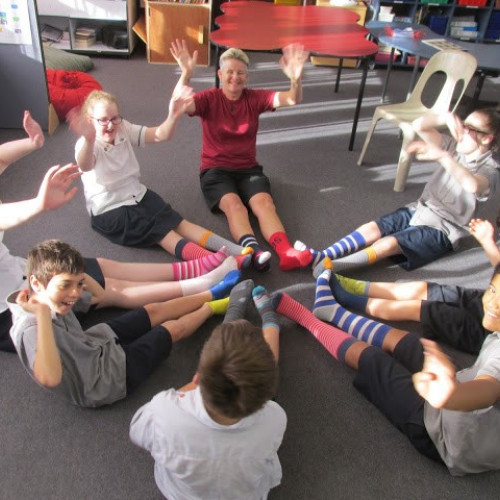
Wairau Valley Special School is using Mental Health Awareness Week (MHAW) as an opportunity to support student and staff wellbeing in a holistic way.
The school, based in Glenfield in Auckland, caters for students with a wide range of disabilities.
Teacher Karen Ramsay says that while their students face challenges, the school has moved away from the deficit model and sees each student as an individual with unique needs, feelings and strengths.
“Participating in MHAW helps us to ask ourselves: Are we thinking about each student’s spiritual wellbeing, mental and emotional wellbeing, physical wellbeing and family and social wellbeing? How are we communicating with the student’s family and caregivers?”
Tailoring MHAW for individual needs
MHAW is also an opportunity for the school to build on their pre-existing knowledge of Māori health model Te Whare Tapa Whā and the Five Ways to Wellbeing.
“At our teacher only day earlier in the year, we introduced the Five Ways to Wellbeing and Te Whare Tapa Whā. So for us, MHAW is about building on what we already know,” says Karen.
They also want to share more information about Te Whare Tapa Whā and the Five Ways to Wellbeing with each student's whānau and found using the MHAW school blurb helpful.
Since the school caters for students aged 5–21, teachers are encouraged to choose which MHAW resources are suitable for the learning level of their class group.
“It’s not a one-size-fits-all approach for us – it’s about what will be engaging and suitable for each student. Teachers can adapt the content to suit the needs and interests of their students.”
MHAW activity plan
Wairau Valley Special School has aligned their MHAW activities with Te Whare Tapa Whā with activities for staff and students:
Whenua – Whakataukī/proverbs will be left on staffroom and classroom tables for people to have a kōrero about over a tea or coffee.
Hinengaro – Gratitude windows. Students and teachers will be given chalk to write what they’re grateful for on classroom windows. At the staff meeting, there will be a quiz about the Five Ways to Wellbeing, Te Whare Tapa Whā and their local Kaipatiki history.
Tinana – A fitness programme for staff and students to take part in a way that suits their level of mobility and fitness.
Whānau – Shared kai/food for the wider school community to whakawhanaungatanga/connect.
Wairua – Kindness post cards. Staff will write a compliment on a post card for their colleagues.
Focussing on wellbeing goes beyond MHAW for Wairau Valley Special School. Karen says they are committed to developing a flourishing school culture with hauora/wellbeing at its heart.
“For us, MHAW is about how we can support our students, engage with their whānau, and further develop the understanding of our staff."

Waiheke High School is running a student-led Mental Health Awareness Week (MHAW) to ensure it has a lasting impact on their students.
Usually the school’s MHAW celebrations are run by school staff – but this year is different.
Their mid-week MHAW is being run by the school’s Peer Sexuality Support Programme (PSSP) students and senior student peer mediators.
“A student-led MHAW means it’s going to be more effective,” says Waiheke High School nurse Maggie Lethwaite. “If I was leading this, it wouldn’t have as much impact – student-to-student is powerful.”
Celebration underpinned by Te Whare Tapa Whā
On the Wednesday during MHAW, students will set up a billboard with a diagram of Te Whare Tapa Whā.
The point of the activity is to encourage students to explore their way to wellbeing, learn more about Te Whare Tapa Whā and test their knowledge of Te Reo Māori.
Te Whare Tapa Whā is a Māori health model which underpins MHAW. It describes wellbeing as a wharenui/meeting house.
“Te Whare Tapa Whā is ingrained in our school culture. I talk about it all the time – and most of the students know about the health model and most of the teachers understand it,” says Maggie.
“Students will be asked what each element of Te Whare Tapa Whā means to them. They can also attach post-it notes on the billboard explaining what has made them feel good in the last month. Each student that participates will receive a MHAW sticker.”
Making MHAW work for the school
While MHAW is a week-long campaign, Waiheke High School students have tailored their plans to suit the needs of their school.
“With exams coming up, we’ve decided to run MHAW on one day rather than the full week. In order to achieve real change, I think you need to keep it simple,” says Maggie.
Maggie says taking part in MHAW helps spark conversation about wellbeing between students and normalises the conversation.
“MHAW helps students feel comfortable to come forward for help early, and this is really important.”
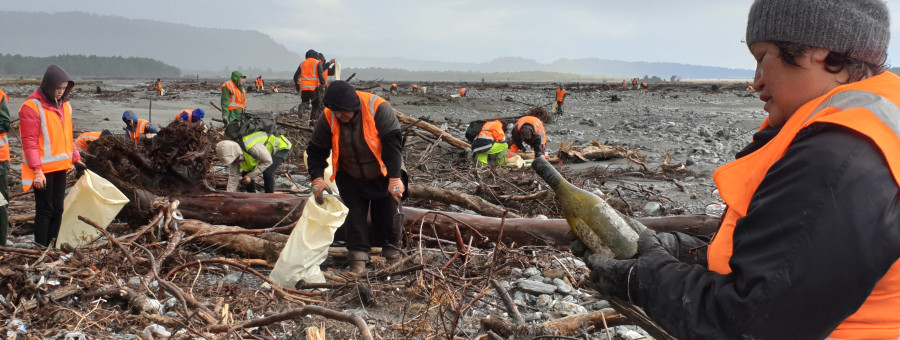
It might be the first time Te Kura Taumata O Panguru is participating in Mental Health Awareness Week (MHAW), but wellbeing is ingrained in the culture of the kura/school.
Tauira/students and kaiako/teachers at the North Hokianga kura have joined forces to plan their first MHAW activities, which are aligned with Te Whare Tapa Whā and the Five Ways to Wellbeing.
“We do everything collectively here. An activity we’ve planned together is a daily waiata,” says Principal Mina Pomare-Peita. “We’ll take a break at morning tea, stand up and sing a waiata each day together.”
Other MHAW activities include taonga tākaro and other traditional Māori games which Mina says are being revived at the kura.
“We’ll also make special emphasis on providing services for students who might want extra support throughout the week,” she says.
Mina has been the principal of Te Kura Taumata O Panguru for 19 years. All 104 of her students are of Māori descent.
Outside of MHAW, Te Kura Taumata O Panguru has a unique way of looking after the wellbeing of their tauira – by regularly volunteering for Department of Conservation (DOC).
“I explain to my students that volunteering is “kohi to koha”. That means we gather and collect to give to the world or the kaupapa unconditionally and without expecting anything in return,” says Mina.
Reengaging with the whenua for positive wellbeing
Volunteering is her way to help boost the wellbeing of rangatahi by reengaging them with the whenua, helping them to understand the concept of giving back and seeing more of Aotearoa.
“Encouraging them to volunteer and reengage with the whenua gives them a sense of connection and helps them learn more than I think any science class can.”
Reconnecting rangatahi with the whenua is Mina’s passion. She feels Māori have lost their connection with the whenua over time through colonization, having a huge impact on their wellbeing.
“We talk about Tangaroa, Papatūānuku and Ranginui all the time – but to connect with them, we have to do more than talk about them. We have to be with them.
“Helping rangatahi to do this will help them understand what we mean when we say we whakapapa to the whenua.”
Other benefits of volunteering
Mina says volunteering is also about whakawhanaungatanga, showing tauira that there are people and adults they can trust.
“I want our students to trust and open up to us. I want them to feel safe, not vulnerable.”
In the July school holidays this year, Mina and seven Te Kura Taumata O Panguru tauira aged 10–16 volunteered at DOC's Operation Tidy Fox on the West Coast of the South Island.
The journey to get there took two days and 1,300km. For many, it was their first trip to the South Island.
"They got to explore more of Aotearoa, see snow-capped mountains and go on the Interislander. It’s all about showing them there is air to breathe and land to look at, while doing their bit for the planet," says Mina.
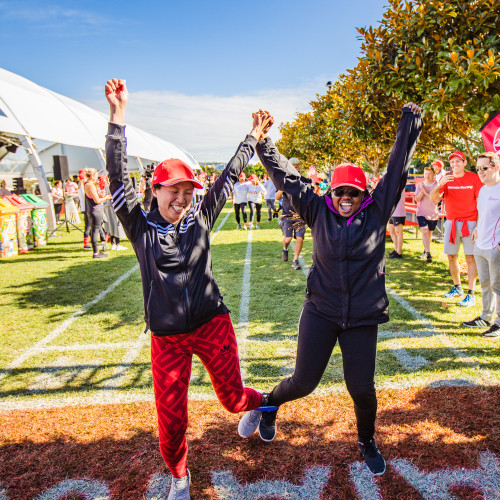
From a gratitude wall and breakfast panel, to running clubs and flax weaving, AIA New Zealand has a range of plans on offer this Mental Health Awareness Week (MHAW) to help their people explore their way to wellbeing.
The Auckland-based life insurance company has taken part in MHAW since 2014. It’s a cause AIA takes pride with being involved in, says chief customer officer Sharron Botica.
“The response from staff has always been awesome and our people know how important positive mental health is for Kiwis, so they love getting involved,” says Sharron.
Aligning activities with Te Whare Tapa Whā
The company is running a special wellbeing breakfast panel during MHAW for all AIA staff and Smales Farm businesses in Auckland.
Sharron is on the panel, alongside AIA ambassador and former Dancing with the Stars contestant Jess Quinn, Spark’s Grant Pritchard and Mental Health Foundation (MHF) employee Janet McAllister.
They’ve aligned the rest of their MHAW activities with the Five Ways to Wellbeing and Māori health model Te Whare Tapa Whā:
Whenua: Gratitude Wall with prizes for participating.
Hinengaro: Flax weaving workshop, along with the Q&A breakfast panel.
Whānau: Team activities across AIA.
Tinana: Yoga classes and AIA Vitality Run Club led by AIA ambassador and former All Black Ian Jones.
Wairua: During the week, AIA will match staff and customer active benefits donations to the MHF.
Impact of large-scale integration on staff wellbeing
Sharron says AIA has recently been undergoing a large-scale integration with significant organisational change – merging Sovereign with AIA New Zealand.
“We recognise the stress that this type of change can put on individuals and their wellbeing. To address this, we have introduced resilience and change workshops and online learning resources,” says Sharron.
She says mental wellbeing is treated the same as physical wellbeing at AIA, and the company recognises the impact of poor mental health on performance at work.
“Our staff are offered support in a number of ways – and we acknowledge that one size does not fit all and that support needs to be tailored to the person,” she says.
Internal wellness programme
AIA offers staff support through their AIA Vitality programme, which launched in August 2019.
AIA Vitality provides employees with access to smoking cessation workshops, discounted medical checks, dietician appointments, mole maps and other services that can contribute to positive wellbeing.
The programme encourages staff to increase their exercise, healthy sleeping habits, and regular medical checks through rewards and points.
“An additional staff benefit is a quarterly recharge day. This additional day of leave is available for staff to use each quarter as an opportunity to relax and take some time to concentrate on themselves," says Sharron.
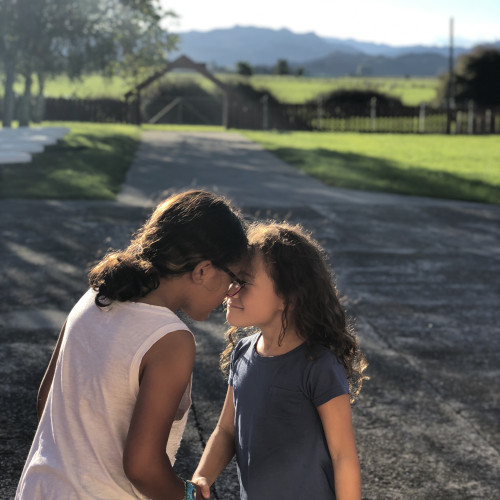
| Ko Hikurangi te maunga | Hikurangi is the mountain |
| Ko Waiapu te awa | Waiapu is the river |
| Ko Horouta te waka | Horouta is the canoe |
| Ko Ngāti Porou te iwi | Ngāti Porou is the tribe |
| He uri hoki tēnei o Te Aitanga a Hauiti me Ngāti Konohi | I also descend from Hauiti and Konohi |
| Tihei mauri ora | Behold the breath of life |
| Ko Chaney Manuel ahau | My name is Chaney Manuel |
Chaney Manuel keeps her Whare Tapa Whā well balanced through her mahi, whānau, iwi and regular activities of netball, kapa haka, waka ama and hikoi.
Mental Health Awareness Week (MHAW) 2019 is inspired by Te Whare Tapa Whā, a Māori health model that describes health as a wharenui/meeting house with four walls.
The walls represent wairua/spiritual wellbeing, hinengaro/mental and emotional wellbeing, tinana/physical wellbeing and whānau/family and social wellbeing. Our connection with the whenua/land forms the foundation.
In 2018, Chaney won the MHAW Wellbeing Photo Challenge with an image of her 8-year-old daughter Aniwa and 10-year-old niece and god daughter Rangimarie.
Story behind the photo
Aniwa and Rangimarie were role-playing a pōwhiri on their marae in Uawa when Chaney took the photo.
“Uawa is a beautiful little town about 45 minutes northeast of Tūranga-nui-a-Kiwa/Gisborne. It's significant to me and my whānau – this is where my great grandmother is from and the place I want myself and my baby to grow together,” Chaney says.
“As children, my siblings and I never really had much to do with our marae, whenua or iwi. This was probably because we were always on the move. But I always felt like something was missing and I didn’t feel connected.
“Four years ago, we moved to Uawa so we could grow together surrounded by our reo, whakapapa, whenua, iwi and for Aniwa to make life-long relationships and connections.”
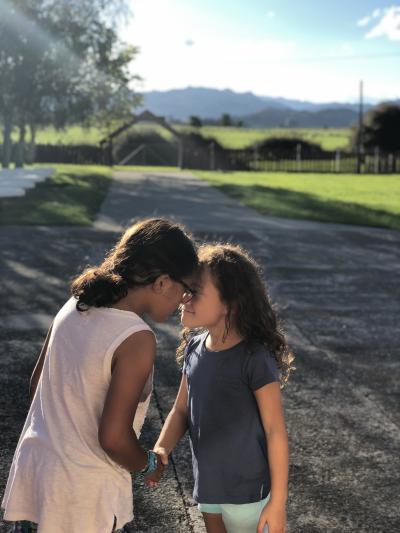
Capturing key moments with her Nikon camera
Taking out the MHAW challenge meant Chaney was lucky enough to win a camera thanks to our friends at Nikon New Zealand!
In June 2019, Chaney’s kapa haka group, Te Aitanga a Hauiti ki Uawa, travelled to Tahiti for a cultural exchange and she was able to use her Nikon camera.
“I was fortunate enough to be the photographer for our trip. I have also used it to take photos at work (at kohanga/pre-school) and used it to take our 2018 official kohanga photo.”
Wellbeing Photo Challenge
The Wellbeing Photo Challenge runs from 23–27 September and the daily themes are aligned Te Whare Tapa Whā.
To get involved and to learn more about these daily themes and what they mean, register for the challenge!
Check out photography tips and daily theme advice from our judge and Nikon NZ ambassador, Esther Bunnings!
Take part, and just like Chaney, you’ll into the draw to win daily prizes plus a grand prize of a Nikon D3500 camera worth $799.
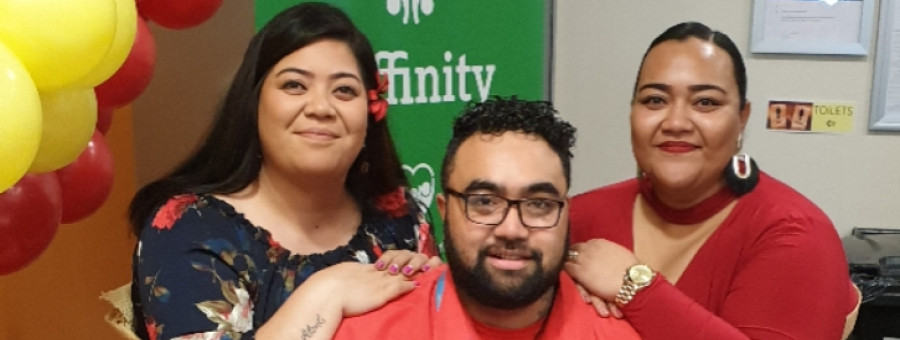
Investing in staff wellbeing
Participating in Mental Health Awareness Week (MHAW) is one strategy Latitude Financial Services has in place to boost staff wellbeing.
Latitude Financial Services is a financial services company based in New Zealand and Australia. In New Zealand, they have a total of 420 staff.
Corporate affairs leader Frederika Walls says the company is always looking for ways to enhance how they can boost their people’s wellbeing.
“Investing in wellbeing is good for productivity, helps to decrease stress and improve engagement. We know how important it is to prioritise wellbeing in the workplace and it’s important that our staff know we prioritise their wellbeing too,” says Frederika.
“Our staff are the key success factor in our business and looking after their wellbeing is a smart investment.”
Latitude Financial Services and MHAW
Latitude Financial Services will be participating in MHAW in 2019 by holding rōpū/team events that encourage hoamahi/colleagues to connect with each other and share their experiences if they feel comfortable to.
This year they plan to have Diversi-tea Kōrero Card stations around the office and will ask team leaders to run the activity with their rōpū throughout the week.
“We participated in MHAW for the first time in 2018 and the staff response has been fantastic. We emailed out advice on how to participate in each daily theme, placed mindful colouring stations around the building and had a visit from Auckland Puppy Rescue,” says Frederika.
“Along with MHAW, we support Pink Shirt Day [a bullying prevention campaign] and try to make sure that we are talking about mental health throughout the year – it’s so important to talk about mental health on a regular basis.”
Frederika says participating in MHAW and Pink Shirt Day is about fostering an inclusive culture where people feel safe to be who they are and know who to turn to when they need tautoko/support.
Internal programmes and policies
One way of ensuring this happens is through their ‘Workplace Behaviour’ policy. This covers everything from expected behaviours, to ways to raise concerns or complaints – through integrity leaders or anonymously if staff don’t feel comfortable reporting issues openly.
Latitude Financial Services also has an Affinity Programme, which is an employee-led network with four pillars; connectors, volunteers, healthitude, and diversity and inclusion.
Each pillar has different team members, a team lead and holds regular internal events.
“Any employee can be involved in the Affinity Programme. We see it as a development opportunity in terms of leadership, developing budgeting skills and meeting new people across different departments,” says Frederika.
Frederika says Latitude Financial Services has also partnered with the Commission for Financial Capability (CFFC) to run a Financial Capability Programme, which involves internal workshops where staff can attend for two hours each week during work hours.
The programme is designed to build the capability and financial literacy of employees, which can play a key role in wellbeing.
Like Latitude Financial Services, boost the wellbeing of your hoamahi/colleagues this MHAW and Explore your way to wellbeing – Whāia te ara hauora, Whitiora!
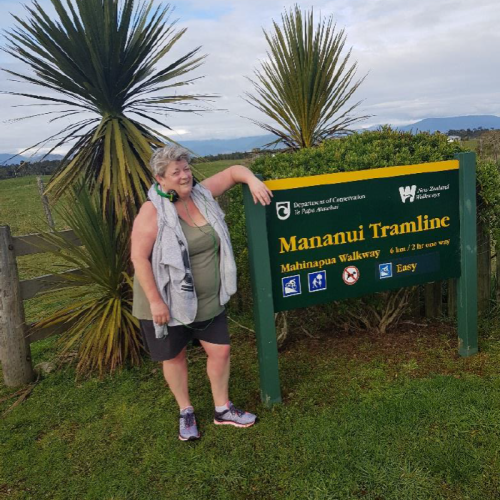
When Lara decided it was time to exercise and be active, she didn’t realise the positive effects it would have on her career, her relationships, and her anxiety and depression.
Lara, a busy desk-bound Department of Conservation (DOC) employee, credits being active for changing her life for the better.
Gone are the days of experiencing intense headaches, taking medication for stress and having trouble sleeping.
“I’d go home from work, eat, and collapse into bed but I’d only sleep for four hours a night. After months of that, I was in a dark place. I had to do something,” Lara says.
The answer came in the local newspaper – a six-week body blitz at the gym was starting up, and Lara plucked up the courage to join in.
“The support is amazing at the gym. I go four days a week, but I also go on outdoor walks during the weekend – I enjoy the fresh air and listening to my own music.”
Lara has lost weight but says the focus is more about overall health and wellbeing.
“I’ve stopped smoking and now only vape; my skin is much better due to the anxiety dropping away. The outdoor exercise has given me new, big spaces to enjoy and it helps me feel stronger inside my mind and body.”
For work, it means those crashing headaches are gone for Lara.
“Walking outdoors has really helped reduce the depression. I feel fantastic. I’m more engaged with my team at work and have stopped sitting at my desk blocked off with my headphones on. As a team we recently went out to a sanctuary and I did some planting – it was great to participate alongside my workmates.”
Lara’s new active journey makes a big difference to her wellbeing; now she connects better with her kids, friends and workmates, and noticing the good in things is becoming usual.
She puts a lot of her new confidence and contentment down to being able to get out and smell the te kōuka/cabbage trees, or the salt off the karekare/waves.
“I’ve pulled myself away from the negative stuff. I’m not sweating the small stuff. I’m me, and that’s who you get. Getting outside and breathing just feels so much better in my head, and my heart.”
This year, MHAW will be held on 23–29 September 2019. We’re encouraging Kiwis to take notice of what makes you feel good, just like Lara, and Explore your way to wellbeing – Whāia te ara hauora, Whitiora!
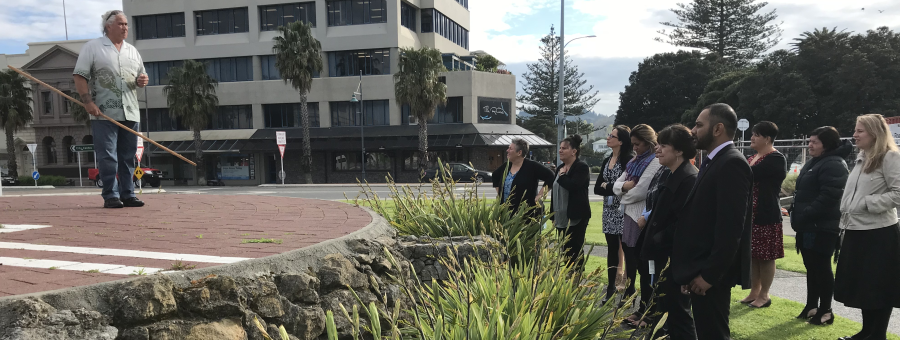
Ministry of Justice in Gisborne has won the Mental Health Awareness Week (MHAW) Workplace Challenge in 2018.
It was the first time Ministry of Justice in Gisborne had celebrated MHAW, Court Registry Officer Julie Hollamby says.
Together, the team at the Ministry of Justice realised the importance of looking after their mental health, and this was the highlight of the challenge for them.
"Mental health is as important as physical health – they run side-by-side. This week gave us time to pause and reflect on things that truly matter, such as nature and how to embrace it in our work environment,” Julie says.
“What a breath of fresh air it has been reconnecting with our surroundings and nature.”
Another highlight for the team was how taking part in the workplace challenge helped them to continue their te reo Māori journey as a workplace. Julie says her team is lucky to have their manager, Kaurauria Ruru, support staff through to learn te reo Māori.
“We were also very fortunate to have Te Aturangi Nepia-Clamp (an artist/carver) speak to us about Te Tauihu/the waka prow – this has stood outside the courthouse for many years, yet we never knew the significance. All staff who attended commented about how this changed their view on the carving, knowing what it really was about.”
Ministry of Justice Gisborne have won a $200 morning tea for up to 30 people with by submitting a stunning PowerPoint they created of their MHAW activities.
During MHAW, the team held different activities that encompassed the Five Ways to Wellbeing, the Maramataka and/or Māori ancestral knowledge.
Staff shared they saw MHAW as an opportunity to discuss mental health more frankly and openly in the workplace, and Julie knows these new attitudes will stay with the team and be regularly incorporated into their work days.
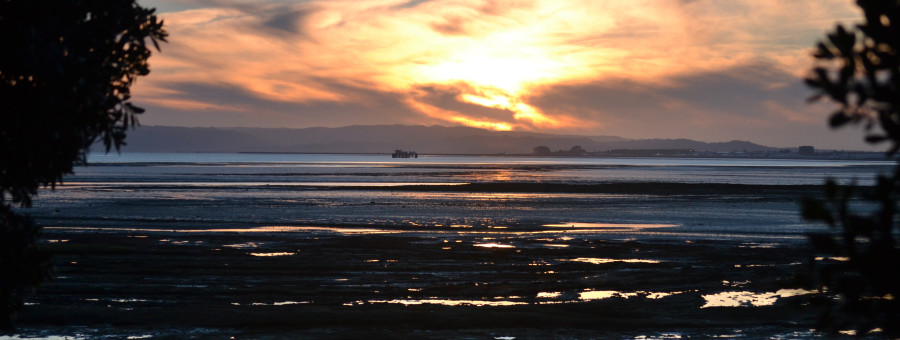
To mark World Mental Health Day on Wednesday 10 October, Healthy Families have organised a rare event which will give people insight into an ancient Māori practice used to wash away raru and bring in new life force energy and wellbeing.
The practice integrates the Maramataka, or Māori lunar calendar, with the ocean’s tidal flows, explains Mason Ngawhika, Kaiārahi Māori for Healthy Families Manukau.
“Our tūpuna/ancestors developed the Maramataka based on their close relationship and understanding of our natural environment. It connects the whenua/land, rangi/sky and moana/sea and tells us what days are best for planting, fishing and harvesting. It also tells us what days are considered high energy, or low energy and how to best spend our time,” Mason says.
“On Wednesday 10 October 2018, the moon will be in its 'tirea' phase which is what we call a low energy day, which is the perfect time to focus on our mental health and wellbeing.”
To help people revitalise, Healthy Families are inviting people to join them in casting their worries into the Manukau Harbour.
“When the tide reaches its peak at 12.15pm, there will be a short period of tai matatū/slack tide, followed by a gradual momentum shift as the harbour waters begin to ebb. Once the tide increases in speed and momentum, this is a perfect time to practise what we call pure, or to recite cleansing karakia where our raru, or issues and stresses may be cast out on the outgoing tide,” explains Mason.
“Even if people don’t know karakia or te reo, they can still cast out negativity in any language, including through thought. Often a physical symbol such as a leaf can be placed on the outgoing tide as a physical manifestation of what is being released to the moana/sea.”
As part of this cleansing practice, people will have the opportunity to experience the shift in energies as the tide comes in.
“The tai whanake is the halfway point on an incoming tide and it is when the hihiri/energy is at its highest. This is the perfect time to practise breathing; deep breaths in, deep breaths out. It is good to focus on goals that need to be achieved, recite personal affirmations, practice karakia or just sit and be present in the moment.”
The event will include a kōrero/talk on the Maramataka and how it can be used to enhance wellbeing. This will be led by the learned Matua Rereata Makiha.
Following the kōrero, people will be encouraged to replicate the process of the pure in their own way. The event will end with kai.
“It is our hope that people will feel the benefits of this natural daily phenomenon, share it with their whānau and friends and make it a regular practice to restore their connection to the moana and boost their mental wellbeing.”
Event Details:
Time: 11.45am
Location: Mangere Bridge Boat Club Jetty
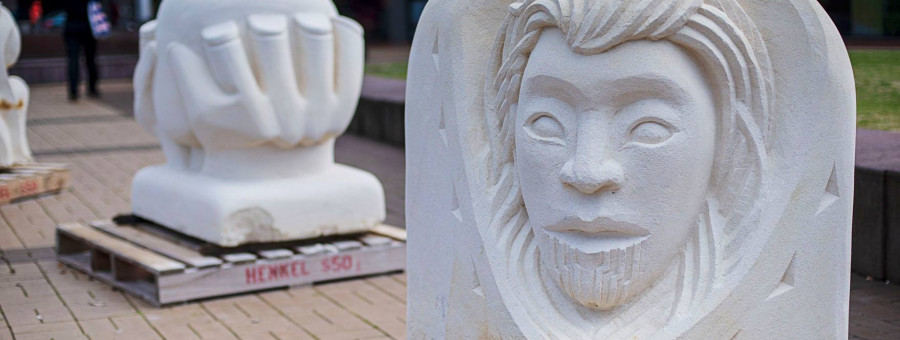
Outside the Civic Square in the Manukau CBD stand 12 carefully carved pou, which tell the stories of the stars, seasons and moon phases, creating a unique Maramataka/Māori lunar calendar compass.
The Maramataka, which means the turning of the moon, guides us on how to interact with the natural world for optimal health, wellbeing and healing. It uses tohu/signs which indicate the best days for planting, fishing and harvesting and tell us what days are considered high energy, or low energy and how to best spend our time. It tells us when we should rest and recharge and when it is time to move our tinana/body or re-energise ourselves by trying something new.
The mobile Maramataka compass was created as part of the Te Mata o Rehua carving symposium to celebrate Matariki and help lift Māori wellbeing in the Manukau region.
Mason Ngawhika, Kaiārahi Māori for Healthy Families Manukau, says the carvings weigh about a tonne, and were created by a group led by Darryl Thompson (Ngāti Kahungunu) and Filipe Tohi (Tonga).
The carvers included five people who were once rough sleepers in the Manukau area. The group also included mana whenua carvers led by master carver Ted Ngataki.
“The carvings are a physical interpretation of the Maramataka which is becoming more widely used as Māori reconnect with the ancient practices used by our tūpuna/ancestors, and the knowledge becomes more profound,” says Mason.
“The Maramataka is centred around our relationship and understanding of the environment and the interconnectedness of the whenua/land, rangi/sky and moana/sea. When our connection to nature is strong we know our wellbeing - physical, spiritual and mental, can thrive."
The carvings are just one of the many ways Healthy Families South Auckland, Panuku Placemaking South, The Southern Initiative and other Māori organisations are working to support the wellbeing of the South Auckland community.
“Manukau was a place that people flocked to for its warm climate, rich fertile soil and its access to two large harbours. We need to restore that by cleaning our rivers and reserves, having careful and considered development and nurturing an environment where people can connect to the whenua/land and the abundance of wellbeing it provides – when the land is well, the people are well. He pai te whenua, he pai hoki ngā hua.”
The portable pou will go on to be used for multiple purposes, including as a teaching resource for the community, connecting with and discussing traditional Māori systems in accordance with the Maramataka.
“It’s our hope that we will continue to build an eco-system of Maramataka practitioners who can teach others the importance of tuning in to the ebb and flow of nature, to boost wellbeing," says Mason.
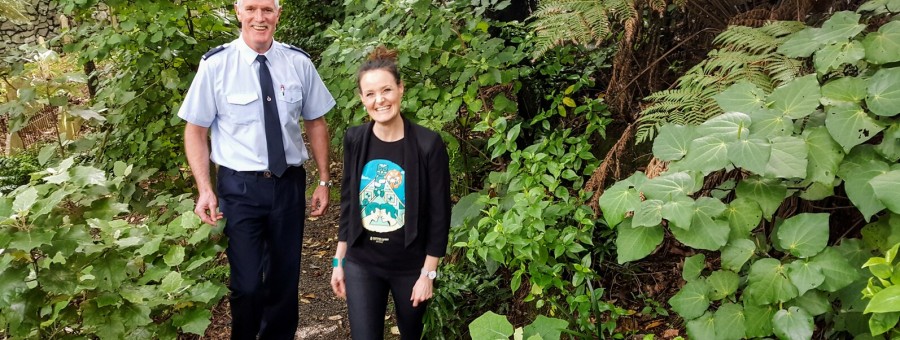
Department of Corrections is going the extra mile to look after its people with a two-week Mental Health Awareness Week challenge.
An internal programme, ‘Your Mental Health Matters’, will launch during week one in the lead-up to the official Mental Health Awareness Week (MHAW) held on 8–14 October.
Department of Corrections principal health and wellbeing advisor Sarah Harmer says week one aims to build awareness, whereas week two is where the behaviour change element comes in.
Videos from the ‘Your Mental Health Matters’ programme will launch to staff during week one. The videos cover different topics, including:
- Ways to talk about mental health in the workplace
- How do you achieve positive mental health?
- How do you talk to someone about mental health?
- How do you bounce back from a setback?
- What else is the Department of Corrections is doing for staff wellbeing?
“It’s really about starting the conversation – it’s not rocket science. We want staff to feel that we’re a source of help and that we’re willing to help or point them in the right direction,” Sarah says.
After MHAW, Department of Corrections plan on launching its “micro-learnings” programme, which is based on resources developed by the Mental Health Foundation.
Sarah says the micro-learnings is based on Māori health model Te Whare Tapa Whā, Open Minds and the Five Ways to Wellbeing. It discusses the signs and symptoms of mental illness, how to talk with colleagues about mental illness and sources of help.
It equips leaders with tools and methods to help them create a positive safety culture in their teams and across the organisation.
“We want leaders to be having these important conversations with their teams.”
Other wellbeing initiatives will slowly be launched later in the year, including how to manage your own mental health in the workplace, which addresses the specific challenges of working in a prison environment and a term called “corrections fatigue”.
“Corrections fatigue is the result of dealing with high-risk people, shift-work, aggression and violence and how they can have an impact on our wellbeing,” Sarah says.
“It’s about acknowleding that the work out staff do is so important to the safety of all New Zealanders – it can be tough work and not every day is a good day, so here are some strategies to help you look after yourself.”
Prioritising routine, relaxation, positive relationships outside work and balancing work with life are suggested strategies.
“We hope this will remind staff that there is hope, and most people in this world are really good people.”
During MHAW week, Department of Corrections is joining in on the Wellbeing Photo Challenge and staff are encouraged to get out into nature.
View our workplace resources, merchandise and the MHAW Workplace Challenge, here.
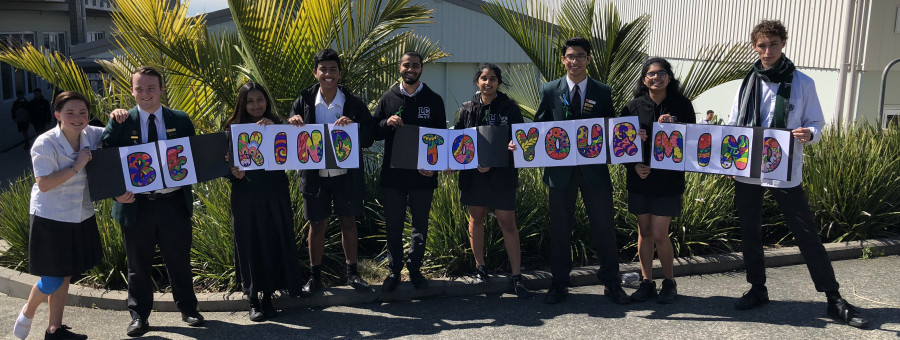
An Auckland College has held their student-led Mental Health Awareness Week (MHAW) a month early before exam stress kicks in.
Lynfield College in Mount Roskill held their MHAW on Tuesday 11 September.
The celebrations were organised by Peer Sexuality Support Programme (PSSP) students, who decided to run it for a day rather than a whole week.
Catherine Barker, English and media studies teacher and PSSP coordinator, helped the students organise the event.
“The students came up with everything – how the day would be run and how to engage students. Many of them are in other committees such as the Safe Schools Committee, SKITTLES (LGBTQIA+ group), and some are part of Student Executive. It’s a great mix.
“They felt it was really important to run our Mental Health Awareness Week celebrations before the September exams started.”
MHAW helping students get through exam stress
She calls this period “peak stress time” and wanted to create awareness of mental health to encourage students to take care of theirs if they’re not feeling 100%.
“Mental health is so important. We need to create awareness about it so students know they don’t have to be studying every minute of every day for exams. We want to show them it’s important to take time out for yourself. Bringing awareness to this has real long-term health benefits.”
Activities run on the day
Activities held during lunch time included mindfulness, colouring-in and receiving gift bags. Inside the gift bags were Five Ways to Wellbeing cards, MHAW stickers, pencils with positive affirmations, herbal tea, and a local Warehouse donated note pads.
“The students had such a good time. Some simply thanked us for promoting mental health as they find it really important. We’re currently recruiting for the 2019 PSSP group and that afternoon we had many students emailing to express their interest. It was pretty awesome,” Catherine says.
She says creating awareness of student wellbeing is a priority at Lynfield College.
“Student wellbeing is a huge focus; not just for the PSSP team, but for the whole school. We’re very aware of the mental illness statistics and we want students to know the school is there for them."
A young aspiring photographer couldn’t believe her luck when she received last year’s Mental Health Awareness Week (MHAW) Photo Challenge grand prize, a Nikon camera worth $1,299.
But 15-year-old Huia didn’t win the camera herself. It was gifted to her by her father’s cousin, Lara MacGregor.
Lara took out the grand prize in 2017 with a photo she took of her partner leaning against a tree in Otago Peninsula. Her photo was one of 15,000 entries to the challenge.
“We were walking in the hills above the New Zealand Marine Studies Centre in Portobello. It is an exceptionally beautiful part of our country that is home to a variety of wildlife, including penguins, seals and albatross,” Lara says.
The 49-year-old says it was a childhood memory that sparked her desire to take the photo.
“Up that high the trees are quite exposed to the elements and the wind can mould them into shapes not too dissimilar to trees from a Dr Seuss story. My partner just happened to rest for a few moments in the bend of the tree trunk. It was a perfect offering from mother nature.”
Lara loved how the photo challenge helped her share moments with strangers and see New Zealand through different eyes.
“Walking about with my camera in nature observing light, shade, movement and composition is one of the most joyous solo pursuits ever. Adding an additional sense of purpose with the daily photo challenges was pure fun.
When the Mental Health Foundation contacted Lara to let her know she had won the grand prize, we weren’t expecting her to say she would give it to a “very special young woman” who is passionate about New Zealand’s birdlife.
Huia, a Ngā Manu Nature Reserve volunteer in Wellington, was shocked to be given the camera.
“I couldn't believe it at first – then it sank in and I felt like the luckiest person alive!” Huia says.
She thanks Lara for getting her into photography to begin with.
“I have a love for spending time in nature and photography, and Lara inspired me to get into a more technical side of photography.”
Huia has been using her new camera at nature retreats, to document a family holiday in the South Island and to photograph a recent trip to Mount Taranaki.
Both Huia and Lara plan to take part in the MHAW 2018 Wellbeing Photo Challenge (8–12 October). If you would like to get involved, register to stay updated on all the details.
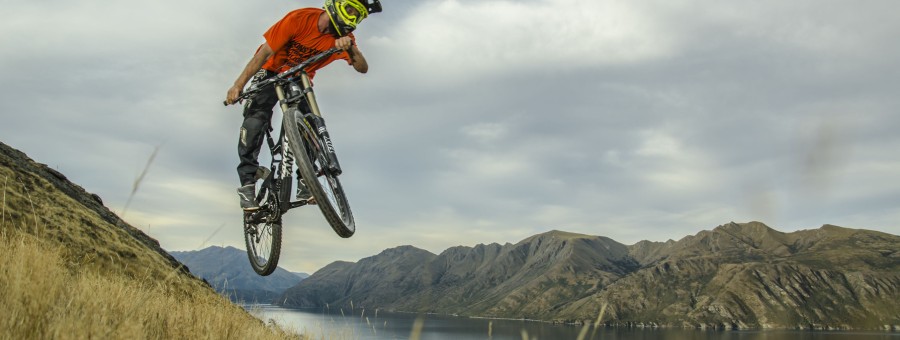
Nikon ambassador Simon Williams uses three tools to stay mentally healthy: his camera, the outdoors and the Five Ways to Wellbeing.
The 44-year-old British photographer now lives in Queenstown. One of his photos features in a newly released book by Nikon, I Am New Zealand: Aotearoa Through Many Eyes. Proceeds from the book will be donated to the Mental Health Foundation.
Simon also entered this photo into the Mental Health Awareness Week (MHAW) 2016 Photo Challenge. He’s proud of its back-story.
“It was taken during a time where it was really hard for me to leave the house. I took myself on a day mission to Ironside Hill in Wanaka,” Simon says.
“I discovered the most beautiful place, with incredible views over the lake and the Upper Clutha, surrounded by natives and exotics. The next week I drove my mate out there and we took photos on our bikes.”
Simon has lived with depression for most of his life. He regularly uses the Five Ways to Wellbeing to internally check-in with how he’s doing.
“I dealt with a lot of depression in my mid-to-late twenties. That’s why I came to New Zealand – I was looking for something to help me get well,” Simon says.
“When I got here, I came across the Five Ways to Wellbeing. I use them as touch stones to check in with myself.”
The Five Ways to Wellbeing (Give, Connect, Take Notice, Keep Learning and Be Active) are simple actions we can all use in nature to help boost our wellbeing. They are weaved throughout MHAW this year, along with the Maramataka/Māori lunar calendar and phases of the moon.
For Simon, photography is his way of staying mentally healthy. He says a camera has been in his life for most of it.
“If there’s ever a day where I’m not feeling so flash, I just pick up the camera and immediately start to feel better.
“I got my first film camera as a teenager and created skate movies. Then I studied astrophysics where I learnt all about lights, lenses, optics and telescopes. I’ve owned a digital SLR camera for eight years now.”
Photography constantly helps him to Keep Learning and Connect, two of the Five Ways to Wellbeing.
“It’s all about meeting new people and connecting with them. That part of it is so nourishing. I’m constantly learning new things through photography and giving back to the community as I do it.”
Simon is joining our Wellbeing Photo Challenge (8–12 October) again this MHAW. Register your name to get involved and feel the wonder of being in nature!
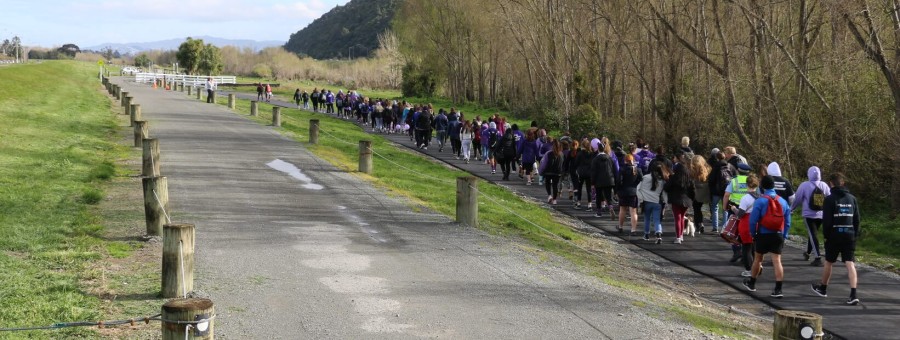
‘He waka eke noa – we’re in this together’ is the motto adopted by a group of Wellington head students for their unique Mental Health Awareness Week (MHAW).
Ngā Māngai Rangatahi o Te Awakairangi, a collective of head students based in Lower Hutt, didn’t let MHAW falling in the October school holidays stop them from getting involved.
They held an interschool MHAW on 20–24 August.
Hutt Valley High School head student Safari Hynes says students from 7–8 schools joined forces to plan the special week.
“The power of unified rangatahi was realised when our group met in April,” Safari says.
“We discussed, planned and began our journey to tackle the large issues of which mental health proved to be of the highest impact on our rangatahi.”
The group made sure all five days of their week aligned with the Five Ways to Wellbeing – five simple actions people can use every day to help find balance, build resilience and boost wellbeing.
Their Five Ways to Wellbeing school activities across the week included:
Be Active: Yoga, open sports day and jump jam
Keep Learning: Amazing race and placing fact stickers about mental health around the school
Take Notice: Balloon treasure hunt and take notice activities
Give: Random acts of kindness, a kindness wall and a thank you note stations
Connect: A March for Mental Health and mufti-day.
Their week ended with ‘March for Mental Health’, a 8.7km student-led hikoi. Starting at Taita Rock, the walk continued down the Hutt River Trail and ended at Hutt Valley High School. It was open to all local schools and the wider community.
“All 150 people who attended wore purple in support of the Mental Health Foundation and MHAW,” Safari says.
Ngā Māngai Rangatahi o TeAwakairangi encourages schools to Let nature in, strengthen your wellbeing – Mā te taiao kia whakapakari tōu oranga this MHAW by participating during a week that works for them.

Staff at the Department of Conservation (DOC) are reaping the benefits of a workplace policy to ensure they have opportunities to enjoy nature, and they’re encouraging other workplaces to Let nature in this Mental Health Awareness Week (MHAW).
DOC Permission Advisor Amanda Edmonds wishes she could capture each moment a glowing colleague returns to the office from the outdoors.
She saw first-hand the connection between nature and productivity, and the positive outcomes it can have on workplaces and their people during MHAW 2017.
Last MHAW was an opportunity for Amanda to take a lead in changing her workplace culture, after realising her team of about 20 Christchurch colleagues weren’t focusing on one of the key strands of DOC’s Safety and Wellbeing Strategy – ‘opportunities to enjoy nature’.
To kickstart this culture change, she ran a two-hour workshop asking her people how they were engaging with nature at work, what they could do more of and what the barriers were to enjoying nature at work.
A team wellbeing strategy was developed with practices to support engagement in nature. Today the strategy is reviewed and discussed at each fortnightly team catch-up.
The workshop also led to trialling out beanbags near windows, so people can read in natural sunlight, assisting the operations teams with outdoor work and having walking meetings.
“Why have your monthly operating review in a stuffy room when you can walk across to the park?” Amanda says.
The team also trialled staff working bees as part of the new wellbeing strategy – DOC Christchurch statutory land management advisor Craig Jones attended a working bee at Tiromoana Reserve to help clear invasive hawthorn.
"I returned to the office rejuvenated, having had a productive day clearing vegetation but also connecting in with people I might not often get the chance to, while also enjoying nature.
“It’s refreshing to see your co-workers in a new light and to share those memorable experiences,” Craig says.
DOC manager of permissions and statutory land management John Blue had reservations about the new team wellbeing strategy at first, but now sees the value in letting nature in.
"I look forward to DOC placing more focus on staff wellbeing – through the rollout of Five Ways to Wellbeing and other initiatives,” John says.
Amanda encourages New Zealand workplaces to get involved in MHAW 2018.
“Challenge the norm – find new ways of incorporating nature into your work day… Little steps and creating small changes mean nature can be easily embedded in business as usual and the weekly and monthly routine.”
This year, MHAW will be held on 8–14 October. Like DOC, show your people you care about their mental health and wellbeing and Let nature into your workplace - tukua te uho taiao ki roto nā papa mahi!
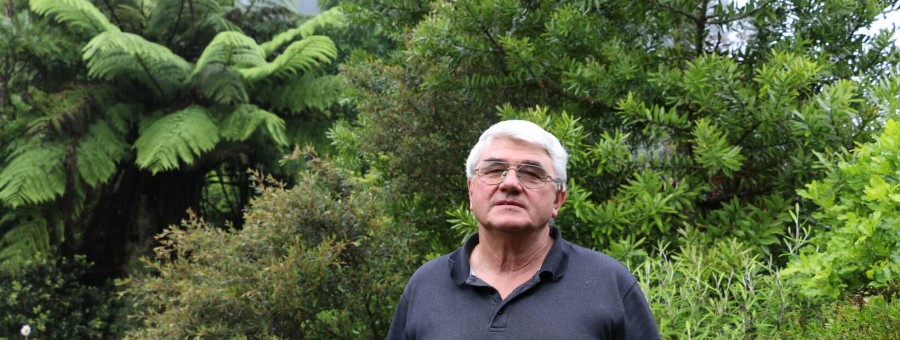
Connection with the land is intrinsic to the relationship Māori have with themselves – it transmutes to their culture, spirit, and wellbeing.
Strengthening the bond between Māori and their tribal land is one of the roles of DOC worker Rob “Pa” McGowan, an ecologist working on the preservation of covenanted land all over New Zealand.
Rob, who is Pākehā, also teaches courses in rongoā – traditional Māori medicine.
“It’s not just about beautifying the land, it’s also about beautifying the people. We want to celebrate our belonging to the landscape,” says Rob, a former priest.
Māori culture grew out of the people’s first encounter with land, and if they lose that connection they will lose their culture and identity, he says.
“In the 21st century, about 750,000 Māori are urbanised and living away from their home areas. If the branch has fallen off the tree, it becomes driftwood and drifts away.”
Showing people rongoā is helping them get back to nature, a connection that grows their spiritual and physical health.
“Traditional Māori medicine isn’t just about plants – it’s spiritual, our wairua. Unless you can heal the spirit, nothing else works. You can’t cure diabetes with plants, but you can deal with situations to get the person to see a better life.”
A session with Rob in nature, which often begins with a karakia, can be a turning point for people.
“So many things come together for people when you take them into a special place in the bush. For a while, you can put away troubles and the buzzing in your head and live in moment.”
The practice of being in the moment – or mindfulness – has been shown to increase calmness, reduce stress and improve focus and attention. It’s one of the ways the Mental Health Foundation promotes to help people stay well.
“People get a glimpse into another dimension that may enrich their way of living. The response within them can be quite startling and their lives become profoundly different. Suddenly, they feel they’re at home.”
Ancestral memories are often awakened for many during these experiences, he says.
“It’s a time to remember people, parents, teachers and role models in life. That’s a very spiritual thing. It opens people up, which is when you can start to teach them.”
“Everything’s nice when the sun is shining, but when the going gets tough, there’s not much to fall back on. With loving the land, people can find the support and strength they need to cope with the cloudy days.”
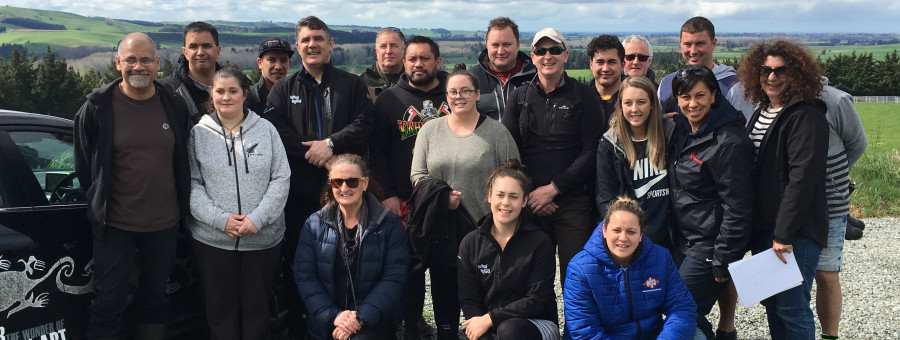
From bootcamp and yoga classes, to nature walks, community clean-ups and marae stays, there’s a strong focus on holistic wellbeing for kaimahi (staff) at Ngāi Tahu.
A cohort of kaimahi from Ngāi Tahu just completed a noho marae event at Arowhenua in Te Umukaha (Temuka), where they learnt about the medicinal and wellbeing properties of native plants.
“It was wonderful to reconnect to Mother Earth and discover natural resources in their raw state like water cress, herbs and Rongoā Māori,” Anthony Tipene-Matua, iwi communications advisor, says.
“The holistic value of oils, rocks and our own Māori affirmations are very powerful and moving,” Mr Tipene-Matua says.
He feels the marae visit gave staff a natural boost.
“The Marae is the last bastion for things Māori in terms of kawa and tikanga so it is priceless. These opportunities give substance to the values of the organisation; whakawhanaungatanga, rangatiratanga, manaakitanga, and they uplift our wairua in a Māori environment.”
Productivity and connection to colleagues improves
Kiri Williams, an administrator from Hauora, says she looks forward to spending time in nature.
“I love the fresh air, natural colours and beauty in our surroundings, and the sound of birds – it 100% shifts your mood! If you can kick your shoes off and go barefoot that’s even better,” she says.
Ms Williams says this helps her work productivity and her connection to colleagues improves.
“I notice that we are all the same, fancy suits or high job titles disappear and everyone becomes equal when you are looking at rock art, making things with clay and learning about our natural surroundings. The extra vitamin D also does wonders for productivity as you have a happier mood.”
Employees say they pick up tools and strategies through the wellbeing programmes that they take back to the office and into their communities.
“If you can be aware of your wellbeing and know what works for you, you will be a more productive person at work, at home, with your friends and for your community. This has to be good for everyone,” Dave Wilkins, environmental advisor says.
Bootcamp and yoga classes popular
Ngāi Tahu also runs bootcamp and yoga classes which are so popular with staff they’re often booked out.
“When I have completed a bootcamp session my brain feels completely refreshed, I can attack my tasks like I would first thing in the morning, and it stimulates new ideas,” Adrian Patchett, GIS analyst says.
Mr Patchett says the classes are an opportunity to connect with colleagues.
“In my job, I do not generally have too much interaction with others, but the social connections that I make at bootcamp have made me more outgoing and I now feel that I can open up to others more.”
But if employees aren’t into physical activity, Ngāi Tahu has made sure there are other options.
“We cover a broad spectrum of mana-enhancing activities to suit our diverse workforce – there’s a little something for everyone,” Wayne Vargis, senior strategy advisor says.
Mr Vargis says the benefits of workplace wellbeing programmes are really clear.
“I return to work with a renewed sense of both purpose and enthusiasm. Most importantly, it allows me to take a step back from the complexity at hand and take a more strategic outlook on things,” Mr Vargis says.
Workplace wellbeing invaluable
The management team says investing in workplace wellbeing is invaluable.
“A safe and well workplace culture enables a strong position for us to achieve our core mission and progress outcomes for whānau,” Katie McEwan, group head people & culture says.
Ms McEwan says it’s important for Ngāi Tahu to walk the talk when it comes to caring for its people.
“When our kaimahi engage in our programmes they are able to see our values in action and understand their reciprocal benefits within the workplace whānau. Our initiatives are designed to not only support physical health and fitness but to also enhance psychosocial wellbeing elements, a sense of belonging and whānau values.”
Ngāi Tahu has a message for all employers across New Zealand.
“Kua takoto te mānuka… kawea ake! The challenge has been laid… pick it up!”
Māori communities are collecting mauri (life force) within kōhatu or stone from their turangawaewae (place of standing) enabling them to bring nature indoors this Mental Health Awareness Week.
This year’s theme encourages people to connect to nature for their mental wellbeing. In workplaces, people can’t always access the green and blue spaces around them as much as they would like, but a slice of nature can be brought indoors.
“Bringing a kōhatu or stone is bringing life force or energy into a workplace,” says Mental Health Foundation Māori development manager Ellen Norman.
Ellen has gathered kōhatu from Maungapiko and sand, shells and rocks from Te Oneroa o Tohe 90 Mile Beach, that sit on her desk at work.
“It grounds me and gives me the energy to continue to work in an environment that’s a bit of a concrete jungle.”
She says the kōhatu are physical reminders that help her when she feels disconnected from her maunga.
“It’s a piece of home that represents safety and nurturing. It’s a spiritual connection to signify that my tupuna are looking after me, and a resilience I carry with me, knowing that whatever situation I get into, I know they’re looking after me.”
After 15 days and more than 15,000 stunning photos shared for Mental Health Awareness Week (MHAW), the Mental Health Foundation (MHF) has announced the winner of its Photo-a-day Challenge.
Lara Macgregor took the photo of her partner Phil while they were on a walk in the hills on the Otago Peninsula.
She says a childhood memory sparked her desire to take the photo.
“Up that high in the hills, the trees are quite exposed to the elements and the wind can mould them into shapes not too dissimilar to trees from a Dr Seuss story.
“Phil just happened rest for a few moments in the bend of this tree trunk. It was a perfect offering from mother nature,” she says.
Lara says the MHAW photo challenge was a joy to be a part of.
“Sharing moments with strangers, seeing our country through different eyes and the reminder we're all in this journey together. Mostly, the joy that comes with shared experience,” she says.
Lara’s photo was the Nikon ambassador’s wild card pick. Esther Bunning chose the six finalists, which were then voted on by the public.
“It was a tough choice. I loved the diversity and varied approach to the theme – it was wonderful to see,” Esther says.
Lara to give prize away
Twelve hundred people cast their votes and Lara’s photo came out on top with 200 more votes. She won a $1,299 Nikon New Zealand camera, which she plans to giveaway.
“To win the Nikon camera is too good to be true! I plan to give it to a very special young woman who is exceptionally passionate about New Zealand's birdlife,” she says.
The young woman is a volunteer guide at Zealandia, and spends time trapping and monitoring weta in a bid to increase their numbers.
“We were chatting a few weeks ago, sharing photography tips, and she mentioned she wanted to eventually get a better camera to take better images of the birds. I couldn't think of a better home for it to go to,” Lara says.
Photo challenge brings benefits
MHF communications and marketing manager Sophia Graham says she was thrilled by the thought put into each entry.
“It was a real privilege to get a glimpse of New Zealand through the eyes of thousands of Kiwis,” she says.
“We looked at every single entry and it was so nice to see what different people treasured, how they connected with nature and the places and spaces that were meaningful to them.
“We felt like we really got to know the people who took part in the challenge and we were genuinely sad when it was over.”
The MHF runs the challenge to gently encourage participants to look at the nature around them with fresh eyes, and Sophia says feedback has been overwhelmingly positive.
“More than 90% of the people we surveyed reported they spent more time in nature as a result of the challenge,” she says.
“And we heard hundreds of stories about people finding it improved their mental health, or using the challenge to connect with people experiencing a mental health problem. Others used the challenge as an opportunity to share their own experiences with mental illness. It was really great to see that the challenge is fun and genuinely helps people.”
New Zealand’s largest life insurer Sovereign got behind Mental Health Awareness Week (MHAW) by organising daily activities to boost wellbeing.
Sovereign’s 700 staff on Auckland’s North Shore could take their pick from a mindfulness talk, free chiropractor assessments, pilates, yoga, backyard cricket and an outdoor treasure hunt.
“The yoga gave me time to turn the brain off and just be in the moment. I came back to my desk refreshed,” Risk Specialist Victoria Jensen says.
Ms Jensen says MHAW was a reminder about the importance of taking regular breaks to look after mind and body.
“It made me aware that we aren’t robots and we do have up and down days,” she says.
On World Mental Health Day (Tuesday, 10 October) and as part of the nationwide Lockout, staff were armed with yoga mats and headed outside.
“I spent the hour resetting my mind and breathing in some fresh air,” Internal Communications Manager Rosalyn Lambert says.
“By getting outside and away from my desk, I was able to focus my mind on something entirely different.
“I have to say my mind didn’t wander back to my computer at all, and I was more productive when I did get back into the office,” Ms Lambert says.
Sovereign’s Corporate Social Responsibility Manager Rebecca Emery says it’s a no-brainer for businesses to take part in MHAW.
“Encouraging staff to be healthy improves their morale and increases collaboration between teams.
“Offering flexible working arrangements and promoting work/life balance from the executive leadership down is one of the many things that sets Sovereign apart as an employer,” Ms Emery says.
She says MHAW encourages management and staff to focus on wellbeing, which is something many people don’t do enough.
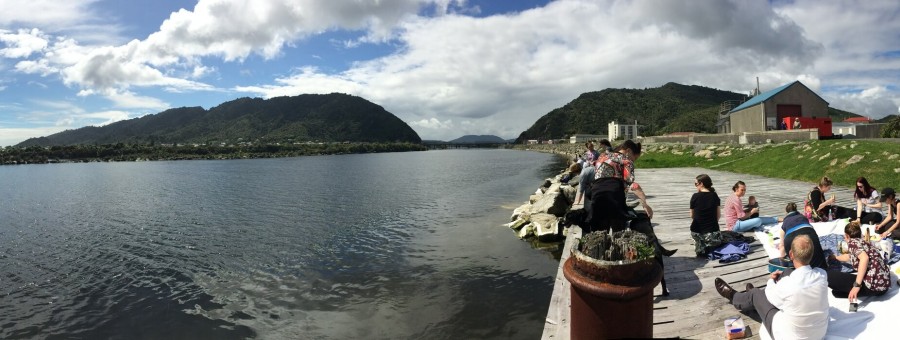
Home-made cheese scones, waiata and sketching were all features of the Lockout for teams from West Coast Community and Public Health.
“We baked cheese scones, our office favourite, and organised a picnic on the river front, we took a guitar and sang waiata and enjoyed laying in the sun on the gorgeous Māwheranui (Greymouth River),” says Freedom Preston, team leader of Community & Public Health West Coast.
“The white baiters were out and about, some of the public were walking along the wall in the sunshine, tourists were exploring, families were cycling, it was a perfect spot to see people enjoying the river which is a strong focal point and identity of Greymouth.”
Ms Preston says the Lockout was an opportunity to take a break, but also to remind staff to walk the talk, when it comes to health promotion messages.
“Mental Health Awareness Week always provides our health promotion and protection teams a space to promote wellbeing messages in our community and social networks, and in doing so, it reminds us about modelling those messages and looking after our own wellbeing.”
Ms Preston says they ran a quiz about the Greymouth River and drew sketches to share with their colleagues, who couldn’t join them for the Lockout.
“The quiz and sketching allowed our creativity and spontaneity to be ignited and the general warmth of stopping, watching the river and engaging with passers-by gave us all a mental break from business as usual.”
Feeling connected
Nutrition Health Promoter Jade Winter says staff connected with each other and enjoyed the sunshine.
“I noticed sculptures that I haven’t noticed before, I felt more energetic and connected with the environment and the people around me and I had a full belly of scones!” Ms Winter says.
“We are fortunate to work in an environment where wellbeing is a priority. It's always nice to share these moments with team leaders and management.”
Health Promoter Rosie McGrath says she noticed positive changes after the time spent in nature.
“I learned some things about my place which I didn’t know, and being together and laughing made me feel lighter and less stressed,” Ms McGrath says.
And in case you’re wondering whether there’s a secret West Coast scone recipe…
“The scones are essentially three ingredients; buttermilk, flour (gluten free to be inclusive) and tasty cheese (plus a pinch of salt and cayenne pepper)!
“If you dug deep into the basket you would’ve found a few without their bottoms… deliberately cut off as they were only good for the birds.”

At sunrise and with the rain threatening, yogi’s gathered on Auckland’s Takapuna Beach (pictured above) to mark the start of Mental Health Awareness Week (MHAW).
The beach yoga was one of five Lululemon classes held around New Zealand on Monday, 9 October (the first day of MHAW).
There was sand, but no rain and the sun even came out as everyone moved in to their downward dog position.
The class was focused on connecting to the breath as a way to carry peoples’ minds to stillness. The instructor drew people’s attention to the feeling of the sand beneath their feet, the sound of the waves, and the ocean breeze. Supreme Coffee provided a delicious post yoga brew.
Just a few hours later, at lunchtime, people swapped their suits for stretchy pants as another group of yogi’s gathered at Auckland’s Britomart.
Yoga instructor Amelia McCombie says yoga has helped to change her life.
“The more that I dive into this work, the sense of connection and love I feel for myself, my body and my life, becomes deeper.
“I now know that when life gets tough and my mind slips back into old stories, I have the tools to quieten my mind, bring myself back to the present moment and to reconnect to a place of love and acceptance,” Ms McCombie says.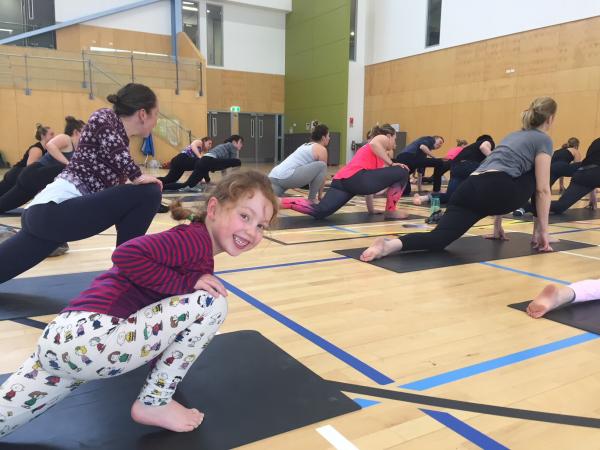
In Christchurch (pictured above), nature wasn’t the ultimate key to getting people to their outdoor yoga class. Rain meant that the class was moved inside. Despite the change in venue, the meaning and purpose behind the class remained the same.
"Yoga saved my life and that is why I teach. I wasn't living in my body before, I spent too long living in my head, with negative and unhealthy thoughts,” says Lululemon Christchurch ambassador, Kotte Aguilar.
Practicing yoga has created space for me to find awareness in my habits and that is why I have been able improve. Yoga allows me to be a better person to myself so I can be better to others."
Lululemon also held classes in Wellington and Queenstown.
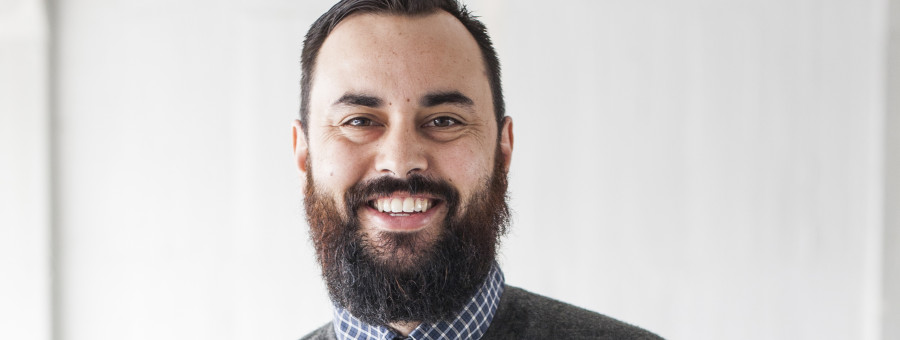
Entrepreneur Nick Shewring connects with nature every day during work hours as a daily reminder that his mental health is worth looking after.
It’s the Vitamin D from the sun hitting his skin, the endorphins and the general good feeling that makes him do it. Even on the busy days.
Nick is the co-founder of BizDojo, a co-working space provider located in Auckland, Wellington, Christchurch and Queenstown.
“Getting outside and exercising gives me some time out from the stressful conversations or the problem-solving. In that time when I am outside, away from the desk and with my phone turned off, my brain can slow down and just soak in the Wellington waterfront or watch the dogs sunbathing outside the cafes,” he says.
"It kind of feels like a revolutionary act when a year ago that self-worth and that self-investment was so diminished.”
Nick lives with depression, and he hit breaking point last year and tried to end his life.
“BizDojo was in the midst of growth mode. We were adding team members, setting up new locations and getting ready for the launch of new projects.
“As a founder, I was under immense pressure, which I met by working harder, taking on more, and devoting less and less time to looking after myself.”
He's since recovered and now lives really well. He’s formed better habits; prioritising healthy eating, mindfulness, sleeping better and exercising to cope with the challenges that he faces as the founder of a start-up company.
After taking time out last year, Nick began to see more and more entrepreneurs who were also experiencing mental illness.
“There is this saying that when you own a yellow car, you start seeing yellow cars everywhere.”
He penned a LinkedIn post sharing his tough experience and asked people to fill in an anonymous survey.
One hundred founders, entrepreneurs and business owners responded – 95% of whom said being an entrepreneur had affected their mental health, 71% experienced anxiety, 40% identified as being depressed and over 50% did not seek help even when facing mental health issues.
The reasons respondents were struggling varied – 38% of people were affected by scaling their business, 14% by investor pressure, 26% by the need to sustain growth in their business and 32% by the process of capital raising.
The added stress that comes with being a business founder clearly takes its toll.
“In many cases you move from a person with an idea and your personal savings on the line, to someone with a team, partners and investors, and all the added responsibility that comes with it.”
BizDojo has a free and frank culture when it comes to mental health. At management meetings, each manager does a stress check-in, using a scale from one to ten.
“From a management level, we try to model healthy habits to our team. Things like making it visible that we are taking lunch breaks, or leaving the office on time… doing this shows in a very clear way that taking care of yourself, taking time out, and keeping your work life and home life in balance are valued and important.”
BizDojo has wellness programmes throughout their five New Zealand locations, which include meditation, mindfulness sessions, social soccer, healthy food clubs, and massage sessions. They’ve also just created Founders Central, an initiative to support entrepreneurs so they’re able to work through the stress of a start-up and come out the other side with a successful business and a successful life.
But Nick says they’re not perfect. BizDojo has been in the thick of growth mode and this has put a lot of pressure on their team.
“The things we had put in place to support our team last year when there were 17 of us, were not working as well with 40 of us.
“There was a really positive side to this; the openness and culture of sharing we had built within BizDojo meant that when our team support structures began to fail, our team told us. They voiced their concerns and we have been able to address, regroup and work towards solutions.”
Along with Sustainable Coastlines and Bikes and Bends, BizDojo are holding a Takapuna Beach Clean-up for Mental Health Awareness Week 2017. The aim is to boost everyone’s mood by getting them outdoors doing yoga and community work.
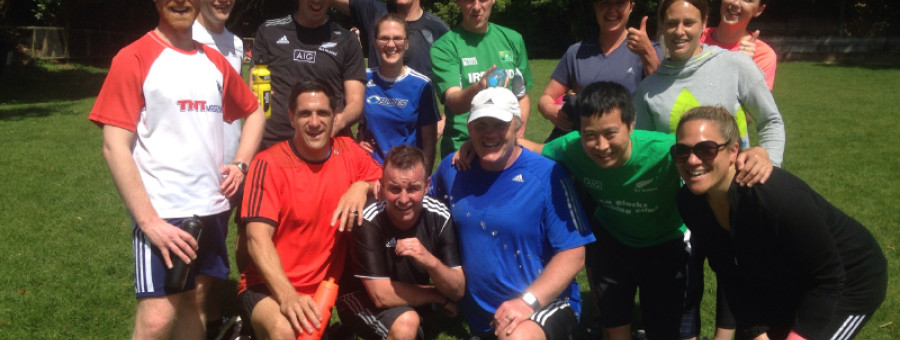
New Zealand Rugby (NZR) says helping its employees to get out of the office and into green spaces is key to keeping the organisation at the top of its game.
And that’s why it’s taking part in the Mental Health Awareness Week Lockout on Tuesday, 10 October. From 12–1pm, Kiwis are being encouraged to head outside to discover how happiness and wellbeing bloom when you connect with the nature that surrounds you every day.
“We hold our people as our greatest asset, so we are prepared to invest in their wellbeing,” NZR chief financial officer Nicki Nicol says.
NZR runs wellbeing programmes and workshops, as well as health-focused challenges, sporting competitions and yoga.
NZR provincial union support manager John Kirkup says there’s something different on offer every day to suit any sort of weather or mood.
“Being a sporting organisation, getting up and away from your desk is encouraged. I try and do something every day, whether it’s an organised session like swiss ball or yoga, or a hit of squash or indoor netball with workmates, or even hitting the gym downstairs,” John says.
John says when he takes a break from his desk and gets moving outside, he’s more focused and gets more done.
“If the weather is good, you get that feel-good vibe. If it’s rubbish, which it often can be in Wellington, it’s that added challenge of battling the elements. Standing up the top of the lookout by the cable car in a howling northerly certainly blows the cobwebs out!”
Being organised is one of the secrets to sticking to a wellbeing plan.
“That first step away from your desk needs to be as easy as possible so you don’t have excuses – that’s the key for me. Book it in your calendar, have your gear ready to go and think of it as a treat rather than a chore,” John says.
Positive changes noticed
Eighty percent of NZR’s 130 employees take part in at least one wellbeing activity throughout the year, with some activities happening weekly. And NZR has noticed positive changes among staff, who are more engaged and more energised.
Twice a week, Melvin Worth, NZR commercial operations manager for NZ Sevens, uses his lunch break for a run, game of squash or mountain bike.
“Being outside during work hours always reminds me of how important the work-life balance is. This puts me in a more positive frame of mind,” Melvin says.
His concentration levels are better and it’s also a chance to socialise with colleagues.
There’s also a walking group which braves Wellington’s weather regularly, as well as a running group and a bunch of people who attend group exercises together.
If you're interested in taking part in the Lockout, please submit your event.
If someone had told Jenni Chambers that she would take up running later in life, she probably would have fallen about laughing.
But running was just one of life’s surprises, which also included becoming a mother to four beautiful children and raising them alone on Waiheke Island near Auckland.
A series of major life changes about 10 years ago, including moving to a remote area, a relationship breakdown and then taking sole charge of her brood of four small children, initially led Jenni to become isolated, exhausted and desperate.
“I was at home with three toddlers and scared to take them anywhere. I was not coping very well with myself, let alone the kids. It was terrifying. I looked at myself, asked myself what was going on and tried to fix the problem. But I couldn’t. I came to the conclusion I was depressed.”
Medication helped for a little while, but a side effect of weight gain caused its own problem for Jenni. “Being fat me made more depressed than ever, and then I became depressed because I was depressed.”
Determined to lift her mood, Jenni started looking or other options and joined a gym.
“I wanted to feel better about myself. I didn’t see too much difference physically, but I noticed the exercise helped keep the black dog at bay.”
One of the Mental Health Foundation’s Five Ways to Wellbeing is Be Active. Exercising has been proven to help make you feel good, both physically and mentally.
As she got fitter, Jenni found herself wanting to run, and spent a lot of time on the treadmill.
When her gym membership expired, she was drawn to a “Wild Woman” fitness group, which trained by running through bush trails.
“I found myself doing things I’d never done, and getting better and better.”
Over time she felt the urge to run solo and, after training with her group, would hit her local bush trails alone.
“I enjoyed the exercise more in the environment, rather than running around the streets or being in the gym,” she says.
Listening to the sound of her footsteps and breathing, undistracted by music from headphones, and truly being in the moment, weaved a healing magic for Jenni.
“There’s such a clarity to being out there in the bush, you couldn’t get purer air to breathe and mentally, well, you don’t have to worry about anything.”
Feeling great by exercising in nature inspired Jenni to enter a marathon. “I thought, if I’m going to do it, I’m going to run a full marathon – 42 km.”
Being active in nature is now an important tool Jenni can use to manage her depression, along with counselling, natural therapies and a good support network of family and friends.
“I found that exercise was the key and running in the bush will be forever my go-to. I’ll always be drawn to it.”

Gardening has always been viewed as nature’s therapy: Getting your hands dirty often seems to melt your worries away, leaving you feeling invigorated and satisfied.
Social and therapeutic horticulture (STH) is a method used by occupational therapists and other health professionals to harness nature’s healing properties.
Research shows that STH promotes social acceptance and wellbeing for people with mental health, social and physical problems.
That’s why Whanganui District Health Board (WDHB) regional mental health unit, Stanford House, has introduced STH for its residents. They can often be found tending their fruit and vegetables in the unit’s garden.
WDHB mental health support worker Richard Hemingway says most of the residents (many of whom will spend their lives at the facility), get involved in planting, weeding, pruning, harvesting and cooking the produce they’ve grown.
In the secure part of the unit, a beautiful rose garden flourishes, bringing a bright spot of beauty to their environment. Richard says the idea of extending STH at Stanford House came to him about five years ago.
Mulling over the future of the garden there, he thought STH could play an important role for the garden and the residents. With the support of all staff, he began using gardening as a therapy for residents.
Happiness and wellbeing are just a couple of the benefits Richard sees in the residents he gardens with. Movement, exercise, planning and safety skills are additional benefits they gain, he says.
“Gardening increases their confidence. For some residents, the one-on-one time we have reignites memories of spending time with their parents or grandparents.”
“I have a client who says to me: ‘Richard, it’s time to mow the lawns… so he gets the lawnmower out and starts mowing’.”
A greenhouse is being built at Stanford House to help the residents increase the number and type of seedlings they plant.
“We have three Pasifika clients who are trying to grow taro,” says Richard. “We’ll know hopefully in a couple of months if it’s been successful.
“Growing enough fruit and vegetables to be self-sufficient is our goal, as is increasing patient wellbeing. It’s all part of the humanitarian and respect-driven culture of Stanford House.
“We’ve had people from Capital Coast and Northland DHBs come to see what we’re all about. I know it sounds like we’re blowing our own trumpet, but there is something different about the way we work with our Stanford House residents.”
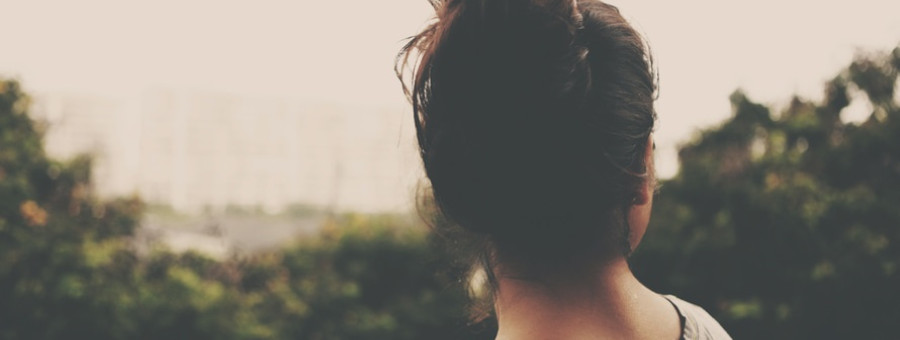
Rolling down a hill with glee – just because it’s there – is something you might expect from a small child.
So when Estella Lee saw a fellow adult from China doing just that when she took them to Auckland’s Michael Joseph Savage Memorial, she laughed and laughed with delight.
“Chinese people are in the mindset that their mood is very much related to their environment,” says the former travel guide.
“So when they come to New Zealand and see a big piece of lawn, they will be very, very, very happy, just like little kids!”
There’s mounting evidence that connecting with nature has a positive impact on a person’s mental health, according to Dr Mardie Townsend, honorary professor at the School of Health and Social Development, Deakin University.
Dr Townsend tells Psychiatry Advisor that “[Connecting with nature] is associated with reduced levels of stress, which also has huge ramifications for physical health, reduced levels of depression and anxiety, increased resilience, increased engagement with learning for children and adolescents otherwise disengaged from the education system, improved self-esteem and increased capacity to engage socially.”
These days, Estella is the chair and operator of the Chinese Conservation Education Trust (CCET), a charity she co-founded with the Department of Conservation in 2002.
The trust takes Chinese people living in the Auckland area out into nature to foster a love and understanding of New Zealand’s beautiful spaces, plants and animals.
One of the reasons the trust was set up was to educate Chinese people immigrating to New Zealand that they couldn’t bring fresh produce or plant medicines into the country with them. That idea extended into nature tours to explain the effects of pollution on flora and fauna and air and water.
Estella’s passion has been invaluable in her delivering the message of protecting the environment.
“I know how to deliver the message to people because I have the love of nature myself. So I can deliver my feelings to that, and tell Chinese people why we have to protect nature, and why is it so valuable.”
Some trips have included taking people out to the bush to learn about the natural environment, and visiting beaches at low tide to look at marine animals, Estella says.
“Each ecology system is different and New Zealand is a very unique place. It’s got a lot of different plants and animals and we need to protect them because once they’re gone, they’re gone.”
The tours are very popular, with everyone attending wanting to come back again and again.
Although the CCET is no longer funded by DOC, Estella is determined to keep it running on donations and grants because of the vast benefits she sees in Chinese people connecting to nature, and enhancing their wellbeing.
“I still want to sustain this trust because it is important as a bridge between the mainstream and the Chinese, and it’s also important to the wider world because those Chinese who have learnt will take their knowledge back to their place of origin.”
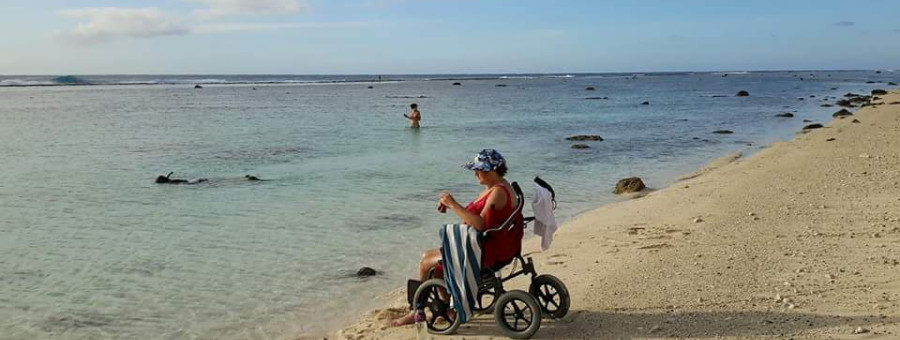
Using a wheelchair hasn’t stopped Merle Bradley going snorkelling or getting out into the rugged West Coast bush.
The 60-year-old nature-lover was diagnosed with motor neurone disease in 2014 but that hasn’t stopped her going into nature and doing what she loves.
“I’m still doing something I love. I thought my mental health would go downhill after my diagnosis, but it hasn’t because I can get out and about,” she says.
People with chronic physical conditions generally do experience a higher prevalence of mental disorders compared with people without physical conditions. So Merle is thankful she can counter that with her outdoor activities.
Central to her ability to get out in nature is her specially designed all-terrain wheelchair.
“I was so excited when I got it because I knew it would revolutionise my life. It meant I could get out and about every week and be able to go out into rough terrain.”
The wheelchair, designed by Greytown engineer Peter Thompson, allows Merle to tackle just about any terrain, including the Abel Tasman Coast Track.
Earlier this year, Merle traversed the track for two days as part of a trial by the Department of Conservation to make tracks more accessible for the disabled. She completed two days of the track, with help from family and friends, who used harnesses and ropes to assist her through the more difficult parts.
Merle, who lives in Hokitika but is originally from South Africa, says it’s important when you are disabled not to be cooped up in a room or institution watching TV.
“Just to be outside listening to the birds, having a sense of achievement and the fun of tramping is an incredible feeling. I’m still doing something I love. My life can continue, I can still see the trees and watch the birds.”
After her diagnosis, Merle was told she had between two and 10 years to live. So the former primary school teacher and her husband embarked on a six-month holiday around the world.
“I wanted to go travelling while I could still walk, before I knew I would be confined to a wheelchair.”
After she returned, she got her all-terrain wheelchair and has never looked back.
While on holiday in Rarotonga this year, Merle was able to get onto the beach thanks to her special wheelchair.
“I put on bigger tyres so I could get over the beach. I could go up to the water’s edge, then stand up with the help of my husband and then go snorkelling. To get out into nature like that was so exciting.”
She is keen to spread the word to other people with disabilities about the benefits of all-terrain wheelchairs to the disabled.
“Before I got my all-terrain wheelchair I thought I would never be able to do things like going to the beach, but I actually can.’’
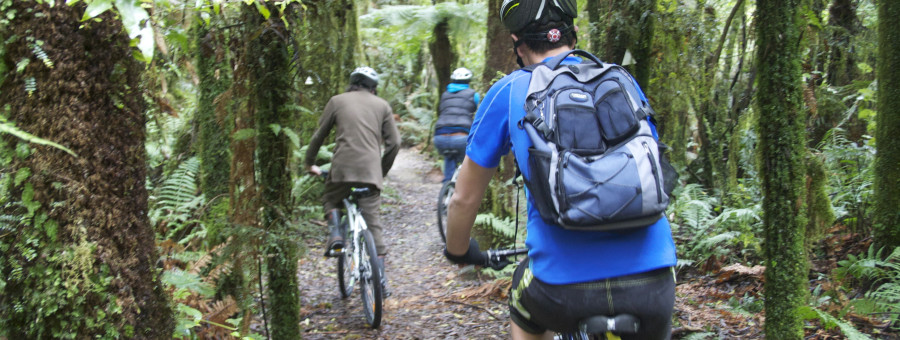
The silhouette of Mt Pureora rises majestically from Ngati Rereahu land in the central North Island. It overlooks the Pureora Forest Park, which straddles the Hauhungaroa and Rangitoto ranges between Lake Taupo and Te Kuiti.
According to Maori legend, the mountain is in the centre of the fish Maui, which represents the North Island. On its slopes, the 78,000ha Pureora Forest Park, with its native bush and birdlife, is surrounded by exotic forests and farmland, including the 5,500ha Maraeroa C Incorporation pine forest.
Mt Pureora is a sacred place to Ngati Rereahu, who have honoured the abundance of food and medicinal plants that have nourished its people and neighbouring tribes for centuries.
“It was our food cupboard, our kapata kai,” Glen Katu says.
Glen is Chief Executive of Pa Harakeke, an ecotourism and adventure company owned and operated by Maraeroa C Incorporation, a Ngati Rereahu land corporation.
These days about 9,000 visitors – trampers, cyclists, bird watchers and eco-cultural enthusiasts from New Zealand and around the world – visit the park every year, with about 2000 of them coming through the Pa Harakeke visitor centre.
Glen says they come because of the pristine bush, the bountiful bird life, the pure, clear air and to experience the rich Maori culture, heritage and hospitality.
“We love to bring people here and share this taonga. Everyone enjoys the moment and leaves with a sense of enrichment and happiness.”
Mountain bikers and trampers of every age choose to ride or walk the Timber Trail, which winds its way through the Pureroa National Park. The 85km trail was built three years ago and is being talked about as one of the “bucket list rides” by many people.
It’s a fun ride, Glen says, but aside from the physical challenges, there’s something about being in touch with nature that visitors love.
“People who come here say they just can’t get over the serenity and beauty of the forest – that and the birdlife. There’s kind of a soul feeling about being in a place where you can still enjoy wildlife – you may even get to see a wild pig or wild deer on your journey.”
A deep love and nurturing of the land is elemental within Maori culture, as taught by the ancestor Rereahu, and handed down to the current generation of Ngati Rereahu.
“Rereahu was a peaceful person and had an immense knowledge about plants and animals, which fed and nurtured our people,” Glen says.
“He was all about sustainability and caring for the land. The Maori proverb which encapsulates this is, ‘Toitu te whenua, Toitu te Iwi’, which translates as ‘Care for the land and the people will be cared for’.”
Those who come to Pa Harakeke also have the opportunity to get involved in preserving the beauty of the natural environment by planting a tree.
“They can choose a native plant from our nursery and plant it out on the estate.”
When people return, they can track the growth of the tree they planted by locating it via GPS, and then zooming in on it through Google Earth.
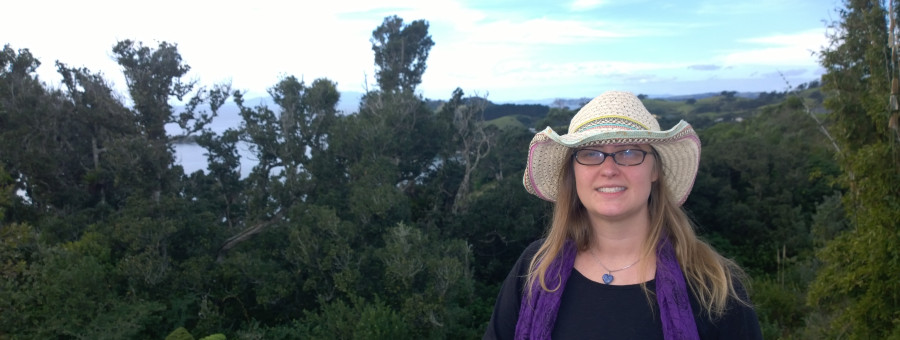
Turning her face to the sun and feeling the wind in her hair and sand between her toes is the therapy Debra Wallace gives herself most days – and also the remedy she recommends to those she counsels as a marriage and family therapist.
The beach and native bush on the beautiful island of Waiheke near Auckland is where she turns to process her emotions, reframe any negative thoughts, and also get the exercise her body needs.
Nature is also where her family spends time together to play and take time out.
Her love of nature as body and soul food began when Debra was 17, after her mother was diagnosed with severe depression. Looking after her mum was challenging and took its toll emotionally on Debra, who began to realise she herself was down a deep, black hole.
“From reading handouts on depression from my mother’s therapist, I realised that I too was suffering. This provided relief because I finally identified the problem and could learn new skills to solve it.”
After just a few counselling sessions, Debra quickly learned that actions speak louder than words and committed herself to making daily changes, such as running. Exercising outside lifted her mood and allowed her to take control of her life – outrunning the symptoms of depression.
“The landscapes have changed from running around a small pond as a teen to hikes with my kids now. Each excursion melts away stress and reminds me how sacred life is.”
Being active is one of the Mental Health Foundation’s Five Ways to Wellbeing. Introducing any of the five ways into your life, has been shown to improve mental wellbeing.
Knowing the value of self-care was essential in Debra’s training as a family therapist in her native America, and became critical after having a traumatic birth with her first child, miscarriages and stillbirth.
“Recovering from these was actually easier because I was aware of the symptoms and could rely on my healing rituals, skills and support network to process the negativity.”
The turning point in her recovery from post-natal depression and grief came when she again took refuge in nature and exercise.
“Biking, yoga, hiking and mindfulness were some of my main ways of processing. When I couldn’t go outside, I would visualise scenes from my favourite hikes.”
Mindfulness, the practice of being in the present moment, has also been shown to help decrease symptoms of anxiety and depression and increase wellbeing.
Debra’s experience of recovering and thriving from her experiences with depression has been invaluable in working with her clients, which include couples and families in emotional crisis, as well as young people dealing with low self-esteem, family conflict or problems in school.
“Connecting to nature has been the closest quick fix that I have found as it nourishes my wellbeing. The best part is that… it’s free. “
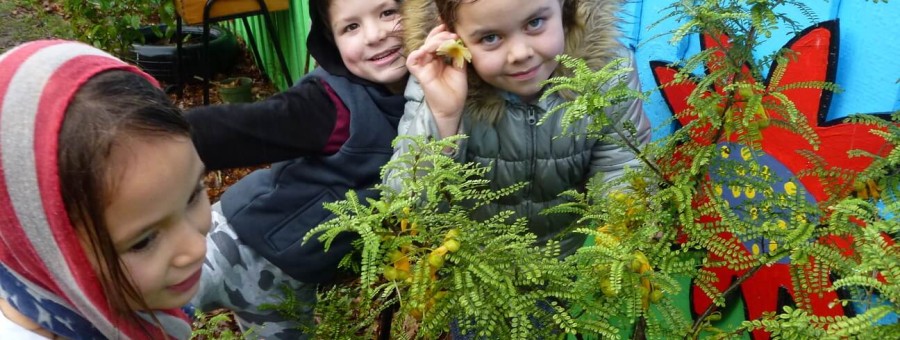
You may find bees buzzing, butterflies fluttering, native seedlings thriving and veges growing in rural settings or your garden but these beautiful spaces are also popping up among hundreds of Enviroschools schools around the country.
In this technology-filled age where kids can lose touch with nature, getting outside and involved in their surroundings is good for them on many levels, says Michelle Ducat, an Enviroschools facilitator in the Hutt Valley.
Enviroschools include early childhood learning centres and primary schools through to high schools. There are close to 1000 New Zealand schools participating in the programme with about 250,000 people involved.
“We talk about learning in the environment, learning about the environment and taking action for the environment,” Michelle says.
“We know there’s really positive things that can happen from the constant exposure and revisiting of natural places. Research shows that kids who have lots of regular opportunities to get out and revisit places in nature have positive impacts on their wellbeing.”
Many studies show the positive links between direct experiences in nature and children’s mental, emotional and physical health and wellbeing, as reported by the Department of Conservation’s document Benefits of connecting children with nature.
Kids getting out in nature can increase self-esteem and resilience against stress and adversity, as well as improve concentration, learning, creativity, cognitive development, cooperation, flexibility and self-awareness. It can also prevent childhood obesity.
Of course, it really helps that once encouraged, most kids just love getting physical and being outdoors, whether it’s in their school environment or on field trips.
“It’s meeting that natural urge to learn and explore,” Michelle says. “Some kids approach nature a bit slowly sometimes but their excitement overcomes a fear about insects or mud. Then, there’s an amazing sense of confidence and pride in what they’ve done.”
Growing, preparing and cooking veges, native tree planting, building bird sanctuaries and waste reduction projects are some of the Enviroschool activities the kids get involved in.
“Enviroschools are about supporting our tamariki to be sustainability leaders of the future and our schools and early childhood centres to be sustainable communities,” Michelle says.
Creating beautiful spaces and connecting to the earth teaches kids about teamwork and how to learn from each other.
“I recently worked with a school where the kids created a bee and butterfly garden. It’s such a delightful and beautiful place to be and they were so proud of what they’d added to the school.
“The feedback I get from parents is that the children are so excited to be part of this. It’s wonderful to see how happy it makes them.”
Thomas and Mahrukh Stazyk know very well how connecting with nature can benefit a person’s wellbeing – so much so they decided to do something creative with the idea.
In 2003, the former accountants bought a 24ha farm in Araparera, an hour north of Auckland overlooking the Kaipara harbour.
Their original thoughts were to have a space where people from diverse backgrounds could come together to share ideas and learn from each other, so they named the property CUE Haven. The “CUE” stands for Cultivating Understanding and Enlightenment
Over the years, the couple was becoming increasingly concerned about the decimation of the natural environment due to increasing property development and, in 2007, decided to restore the property back to native forest.
“Auckland still has green spaces but with all the development, those spaces are disappearing. We don’t want Auckland to become like other big cities around the world,” says Mahrukh, who was born in India.
“Thomas and I have always spent time in nature, therefore it came naturally to us to create something like this.’’
They have enlisted the help of volunteers to transform the area. To date over 3,000 volunteers from school, community and corporate groups have planted more than 151,000 native trees and built almost 4km of walking tracks and boardwalks.
“We are so grateful for all the people who have volunteered their time,” says Thomas, who comes from the US.
The couple love seeing the joy planting trees and helping with the project brings to the volunteers, especially to those who haven’t spent much time in nature.
“It gives them confidence and a sense of creating something that will be around for a while, something bigger than them. It’s relaxing, educational and they get a real sense of achievement,” Thomas says.
The couple are in agreement that the benefits of being involved in CUE Haven align with the Mental Health Foundation’s Ways to Wellbeing – connect, give, take notice, keep learning and be active.
CUE Haven also allows people to plant memorial trees for loved ones who have passed away.
“It’s been so rewarding for us to see people gain a sense of closure after planting a tree. Nature has been very therapeutic for grieving people,” Mahrukh says.
“To us it’s a wonderful place to unwind and to just be, to be quiet, to listen, to talk. It invigorates you and enables you to recharge. We are hoping to create an experience like that for other people.”
The couple plans to covenant the restored property with the QEII Open Spaces Trust and eventually gift it to the community to enjoy in perpetuity.
“We hope CUE Haven will be a space for people to go to chill out. People need somewhere to go where it’s quiet and peaceful. Where they can hear the birds and be still and be in the moment.”
Climbing trees, building huts, collecting tadpoles and running through the bush with friends is the stuff of childhoods from a bygone era.
These days our kids are more likely to play indoors, or maybe in playgrounds under the watchful eye of protective parents.
“Shutting our children away” has concerned childhood teacher Jan Beatson for many years.
“It really struck me that being outside is what our children in New Zealand didn’t have. They had lost their freedom.”
Nature Kindy – inspired from some Scandinavian preschools that are held almost entirely outside – was her solution to getting Kiwi kids back into nature to learn, grow, have fun and form healthy habits for a lifetime of wellbeing. Set up in 2010, Nature Kindy has spawned two more centres and five playgroups in Auckland. Jan says that the Te Whāriki curriculum is followed.
“It’s wonderful to see their absolute exhilaration of running really fast down a hill, or the joy of standing up on top of a look-out. They get huge enjoyment out there,” Jan says.
Research published by the Department of Conservation shows that if we connect with nature as children, we will turn to it later in life to find relief from stress.
“If you’ve connected with the mall or TV or food, then you’ll turn to those things when you feel down. But if outdoors is your place that’s where you will go and you will get those restorative benefits,” Jan says.
And though a Nature Kindy class might seem like one big playtime, the children are learning just as much as they would in a classroom.
“There’s nothing that you can’t do outside that you can do inside, but there’s plenty that you can’t do inside that you can do outside,” she says.
“If you’re inside you can’t kick a ball, you can’t run fast and you can’t throw things. But if you’re outside you can do art and music and stories.”
Numeracy, literacy and creativity come naturally in nature.
“The kids have got to find their own things to do, as we don’t take toys. So if want to build something, they have to go off and find their sticks and measure things for themselves.”
More importantly, the children learn crucial life skills outside, including problem-solving, managing fear, risks and challenges and developing resilience.
“We’ll talk them through things but they have to work it out for themselves – we want them to use their own judgement to manage fear and uncertainty. So if they want to climb a tree and get stuck, we won’t get them down. Then, they might practise and practise until they can go up higher.”
Children are also allowed to roam freely within generous boundaries to develop independence, discover their own limits and overcome adversity. And dealing with the elements provides great lessons in coping strategies.
“If it’s raining, we just put on raincoats and go out. In life, not everything goes right and sometimes you just have to keep trying until you do get it right.”
Of course safety is still paramount, Jan adds, but involves including the children in taking responsibility for it.
“We get them to talk about what they have to look out for, like, if it’s raining the track might be slippery, so they put their own strategy in place to manage that.”
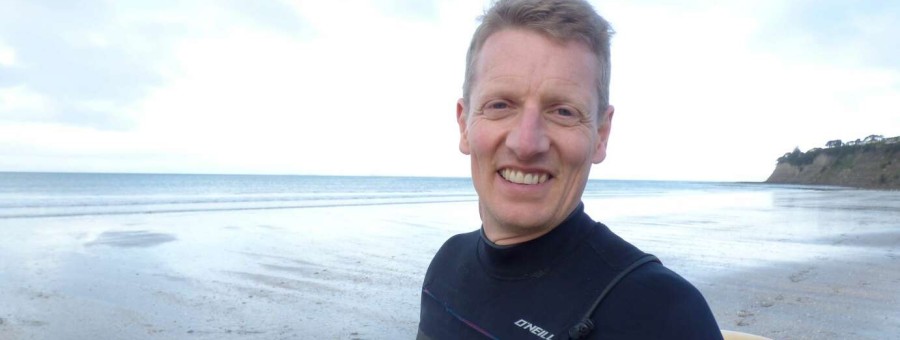
There’s nothing like a good surf to get David Smale feeling restored and on top of the world.
And the sport certainly ticks off three of the Ways to Wellbeing that the Mental Health Foundation promotes to maintain mental wellness: taking notice, connecting and being active.
Exercising releases chemicals called endorphins, which are the brain’s “feel-good” chemicals.
“I have moments of exuberance and complete joy when surfing. I can have an amazing session and the thrill and enjoyment is unbeatable,” David says.
“When I luck in and the waves are pumping and I’m surfing well, I get a natural high off it.”
And that good feeling extends to after the surf has finished.
“The feeling after a good surf is epic. I have a cool after-vibe and all that endorphin stuff going on. It’s physically, mentally, emotionally and spiritually satisfying.”
David, an English teacher at Westlake Boys’ High School in Auckland, has been surfing for 30 years. He started when he was 10 years old growing up in Taranaki, which is home to a number of world-class surf breaks.
Surfing keeps him connected to nature, which makes him feel good.
“Surfing has that natural connection that’s as authentically being back to nature as you can get,” he says.
“When you’re surfing, you’re in a dynamic, natural environment. You see incredible things like sunsets, sunrises, amazing light, wildlife like birds, fish and dolphins. It’s a real privilege.”
He has only positive associations with surfing. “Even though I broke my ankle badly surfing a few years ago, surfing has positive connotations. I don’t have any negative associations with it.”
It can be both a solitary and group pursuit. “I like the solitary aspect of it, being in the natural environment. It’s a retreat from your ordinary existence. But I also like the camaraderie. Going surfing with mates is fun.”
Surfing is a great way to stay fit too. “It’s the perfect type of fitness in that you don’t think about exercising when you’re doing it.”
The technical side of surfing keeps him fulfilled and is something he’s always honing. “It’s constantly interesting and challenging and something I never get bored working on.”
Surfing helps keep his mind in the moment. “I’m wholly focussed on the waves, paddling and getting into a rhythm and getting in sync with the ocean. It clears my mind.
“I associate it with getting away from things, whatever the hectic stuff in life is. It’s very relaxing and restorative.”
Like David, you can introduce any of the ways to wellbeing into your life, any time, and you will begin to feel the benefits.
Whakatōkia ngā rautaki māmā nei ki tō ao kia rongo ai koe i ngā painga.
http://www.surfingnz.co.nz/
http://www.newzealand.com/int/feature/surfing-new-zealand/
http://www.stuff.co.nz/life-style/well-good/78638901/Surfing-helps-me-cope-with-depression
Hawke's Bay
Getting children and families together. Especially those who are finding difficulties to attend community associations organized ev…
Learn moreOnline
Informal and free.
In person (Rotorua Library) on Friday the 27th September at 2:30pm or Online via Zoom (Thursday 26 September…
Bay of Plenty
Informal and free.
In person (Rotorua Library) on Friday 27 September 230pm or Online via Zoom (Thursday 26 September 830pm for…
Canterbury
This week, our Oma Oma group is heading to Bottle Lake Forest to kick off our training for the upcoming Pae Ora Whānau fun run/walk…
Learn moreNorthland
To support this kaupapa and this years theme “Community is… what we create together” Te Rarawa Anga Mua are offering 3 mini mental…
Learn moreOtago
As part of Mental Health Awareness week GROW Nz is having an Open Day in Dunedin.
Wednesday 25h September from 2pm - 4.30pm.
22 M…